- Destinations

Is Lisbon Worth Visiting? (And How Long Do You Really Need)
- February 1, 2022
Lisbon is becoming an increasingly popular place to visit, but it still isn’t the crowded and expensive nightmare of other European destinations!
Lisbon is extremely walkable and has a relaxed atmosphere.
Here is everything you need to know about visiting the capital of Portugal, including how long you need, and is it even worth doing?

Is Lisbon Worth Visiting?
Yes, Lisbon is worth visiting. It is a trendy young city and a top choice for Digital Nomads, but you don’t need a lot of time to see it.
There are other places in Portugal that are worth spending more time in. If you are slow travelling through Portugal I would still allocate a short time for Lisbon.
How Long Do You Need in Lisbon?
3 days is the ideal amount of time to spend in Lisbon. That will give you enough time to visit everything you want to see in the city center, and still have time to relax.
If you only have 2 days, that would be enough to see Lisbon, but less time for coffee shops, lazy strolls, and activities.
You can’t visit both Lisbon and Sintra properly with only 2 – 3 days. 4 might be possible, if you stay in Sintra instead of Lisbon.
(More on that in a moment, plus your full 2-3 day itinerary.)
Is 5 Days in Lisbon Too Much?
5 days is the ideal amount of time to spend in Lisbon if you also plan on exploring Sintra. There is a lot more in Sintra than you can see and do in a single day trip
Is 7 Days in Lisbon Too Long?
7 days is too long to spend in Lisbon alone. You can see all of Lisbon and Sintra in 5 – 6 days. If you have a whole week, you would be better off heading to the Algarve, spending some time in Fatima/Batalha, or even taking a train up to Porto .
Having said all of this, there are plenty of people who like Lisbon enough to live there. Digital Nomads and families like the city for it’s amenities and mild weather.
For me the difference is that Lisbon would be a practical place to settle down, but not an exciting place to explore for more than a week.
Best Time to Visit
Most tourists will be on vacation from May through August , so by visiting in the off season you can avoid any large summer crowds.
For pretty much any trip, I will always advocate for the shoulder season, which is Spring or Fall.
The best time to visit Lisbon is in March/April or October/November. These transitional months are mild and the weather is nice.
That being said, Portugal doesn’t get truly cold weather, daily temperatures in winter range from lows of 2C (35F) to highs of 20C (68F.)
That’s quite warm compared to where we are from, so a winter visit would be fine by me.
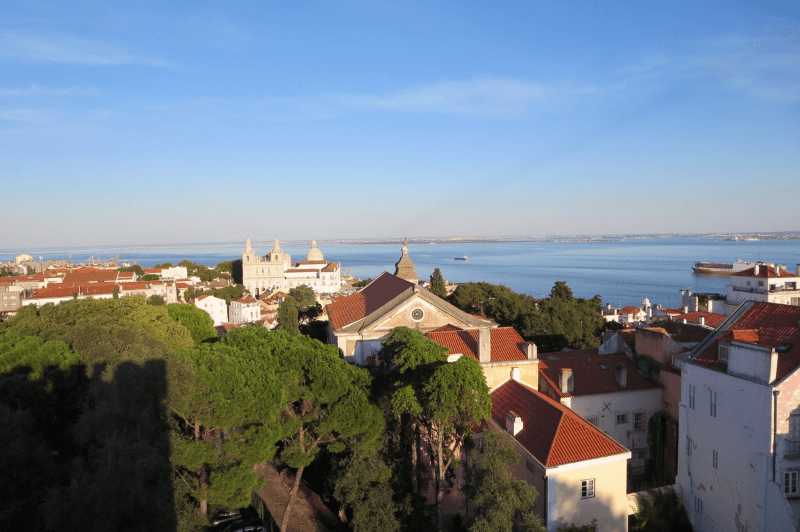
Arriving in Lisbon
Lisbon does have Uber , so you don’t need to plan too much ahead about how you will get to the city center. (We only EVER take airport taxis as a last resort.)
Uber is only allowed to pick up in the departures area, so make your way over there.
There is also a metro station in Terminal 1. If you arrive at Terminal 2, you can take the free shuttle bus between terminals.
Getting Around
Using the lisbon metro.
Lisbon’s metro is very user friendly, so you won’t have an issue figuring out the lines.
The Saldanha line is one of the main ones that goes to the city centre from the airport, but of course, it depends on where your accommodation is.

The metro is safe , but like most major cities, petty crime is a problem. To avoid pickpockets, keep your belongings in sight and off of your back.
Both times that I was the target of pickpockets it was on an escalator, so don’t think that it only happens on the train or in crowds.
NEVER store important items in outside pockets, and keep your wits about you at ticket machines and while you’re reading maps.
Other than that, happy riding! It’s very easy and affordable to get around.
Where to Stay in Lisbon
The best area to stay in Lisbon is the Baixa district and the surrounding area.

The easiest way to choose your accommodation is to find “Santa Justa Lift” on a map, and then cast a wide net outwards.
Lisbon is very easy to get around, both on foot and via the metro, so being right in the centre is less important than other cities .
Most of Lisbon is beautiful historic buildings, so finding a place you can afford in a picturesque location shouldn’t be too much trouble.
Upon your arrival, make your way to your accommodation and get settled.
Explore your neighbourhood on foot.
Pick up a “Pasteis de Nata” – Portuguese custard tart – at a cafe, have dinner, or go right to sleep.

Day 2 & 3
Your second day in Lisbon will really be your first actual day, so spend it having a wander!
Here is a list of some ideas for easy things to do without needing to plan. This is an opportunity for you to decide how long you will want to spend in Lisbon.
Relaxing Things to do in Lisbon
Oriente station.
This train station is both a main connecting point for the metro and for long distance trains.
The architecture here is very interesting and it makes for a good photo stop!
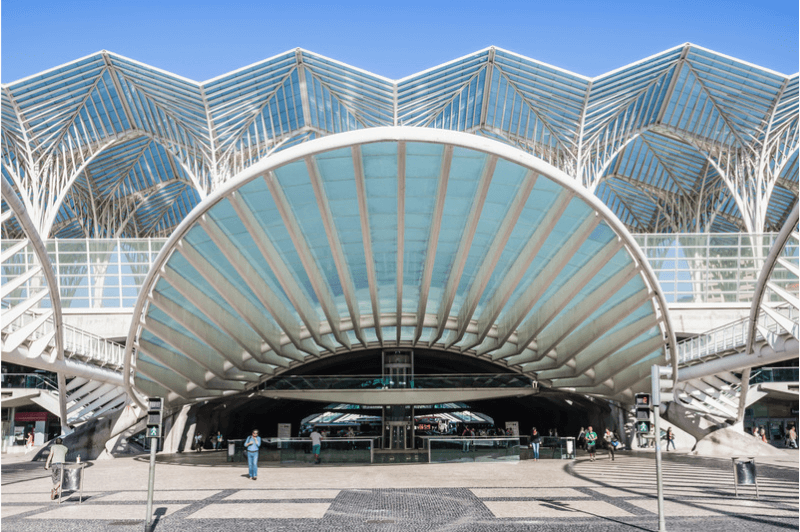
On the upper level of Oriente station is where the longer distance trains come in, and it is covered in a cool geometric canopy.
The mid-level is an interesting concrete structure . Ground level is a pretty typical train station.

Across from Oriente station is a HUGE mall , so if you are needing to purchase anything before your vacation really takes off, this place has everything.
The grocery store on the bottom level is very convenient.
Lisbon Oceanarium
The Oceanarium is what it sounds like, an aquarium, but there are also penguins and other water creatures.
You don’t need a lot of time here, maybe a couple of hours, depending on how busy it is and how much you like watching sea life!
We found the visit very relaxing, and there was a travelling exhibit called “Forests Underwater” that we also enjoyed.

The Oceanarium is only one block walking from Oriente Station.
Oceanarium Ticket Prices
- Ages 0 – 3: Free
- Ages 4 – 12: 10 Euros
- Adults 13 – 64: 19 Euros
- Seniors 65+: 13 Euros
I don’t believe there is a family rate unfortunately, but I could be wrong! I checked, but there is nothing listed on the website.
The Oceanarium is not exactly a “cheap” thing to do. We really like aquariums and downtime so we bit the bullet, but it was one of the most expensive things that we did in Portugal.
(Second only to some admissions in Sintra!)
You can take that two ways:
- Nothing in Portugal is crazy expensive, and
- You might not want to spend 58 Euros to take the kids to the Oceanarium

If you like aquariums and plan to spend a lot of time in Lisbon during your trip, the annual family membership is 85 Euros (2 adults + 2 kids,) and then you can return any time.
An adult membership is 35 Euros , and additional kids are 30.
Telecabine Lisboa
The Lisbon cable car south station is right outside of the Oceanarium.
We love a good cable car, so we’ve seen a few, but this one is probably my favourite!

The ride is a decently long round trip in a comfy enclosed cabin with a bench seat. The car dangles perilously (kidding!) above the ocean and you have a great view of the Lisbon waterfront.
The best part was that it was not at all busy when we were there. I imagine in summer it could get a little more crowded, but shoulder season was quiet.
Telecabine Lisboa Ticket Prices
- Ages 4 – 12: 5.50 Euros
- Adults 13 – 64: 8 Euros The cable car operates daily from 11 am to 6 pm, with additional hours during high season.
Here is an ideal schedule for exploring this whole area:
- Arrive from your hotel via the metro to Oriente Station
- Take a walk through the shops and get lunch on the top floor
- Walk to the Oceanarium and take your time through the exhibits
- Walk just a few steps to ride the cable car over the ocean
Strolling the City Centre
From Oriente Station you can take the metro a little closer to the centre.
Restauradores, Rossio, or Baixa-Chiado are all good stations to get off in a walkable area.
From whichever station you choose, get lost in Lisbon! You can’t really get very lost, because there are metro and tram stops everywhere.

Speaking of which, consider taking the little yellow trams at night, through Lisbon’s pedestrian friendly centre.
Cafe’s and restaurants are not hard to find in this area. Challenge yourself to find a quieter haunt on a less travelled street.
Santa Justa Lift
While you’re in the area you will probably catch a glimpse of the Santa Justa Lift at the end of one street or another.
The lift amounts to a very large, very elaborate, elevator. It was styled after the Eiffel Tower by it’s designer, who admired his fellow architect’s work.
The lift connects two parts of Lisbon where previously you would have to climb a prohibitively steep hill.

I feel like I should be embarrassed by saying that I have been to Lisbon several times and have never actually taken the lift.
Every time that I have happened by, the line up was very long, and I just didn’t want to ride it badly enough.
(The Santa Justa lift carries 20 people up and only 15 down.)
The lift does have an observation deck on top , which offers views of central Lisbon.
Insider tip: Access the lift from the top for a shorter queue!
Santa Justa Ticket Prices
- Return ticket: 5.30 Euros
- Observation Deck: 1.50 Euros Riding the lift is free if you purchase a 24hr transit ticket. (Observation deck extra)
Carmo Convent
If you do decide to ride the lift, it will take you up to the Carmo Convent.

(If you don’t take the lift, access the same area by exiting on the “Chiado” side of Baixa-Chiado station.)
Destroyed during the great earthquake of 1755 (of which you will read a LOT in Lisbon) this convent is now a beautiful open-air Gothic cathedral.
Tickets: 5 Euros per person
Lisbon’s Pink Street
Ten minutes walk from Santa Justa Lift, or near the metro stop “Cais do Sodre”, is Lisbon’s “Pink Street.”
Closer to the waterfront in Lisbon, this street was painted pink as a revitalization project, in what was considered a seedy area.

The project did work and now it has become a tourist and Instagram hot-spot , instead of being the red light district!
Come back in the morning if you want to take photos without the crowds!
Praça do Comércio
You will very likely pass Praça do Comércio during your pedestrian adventures in Lisbon, but if you want to seek it out, just walk straight from the Santa Justa Lift to the waterfront.
This public square is huge , and surrounded on three sides by distinctive yellow buildings. Once the site of a palace, the square was destroyed by the earthquake and following tsunami of 1755.
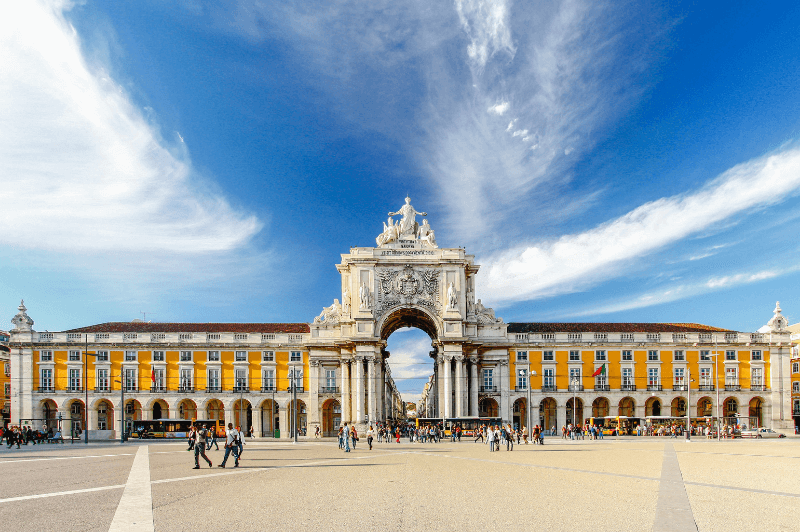
When Praça do Comércio was rebuilt, it was no longer a palace because the traumatized King refused to move back to a stone house , and lived in tents until he died.
In the centre of the square, leading towards the old town, is a huge arch: The Arco de Rua Augusta.
For just 3 Euros you can actually climb the stairs to the top of the arch and take in an amazing view of Lisbon. A fact I did not know until long after our trip. Next time!
You can easily cover all of the City Centre sights in one day, since you can walk to them all and explore as you like. If you fall in love with Lisbon, stay longer!
If you spend days 2 and 3 of your trip to Lisbon enjoying all of the sights above. Now is a great time to move on to nearby Sintra.
Visiting Sintra

A visit to Lisbon (and Portugal for that matter!) isn’t complete without spending some time in Sintra.
If you do it right, you can easily combine the two cities.
Don’t Plan for One Afternoon
I will start by saying that Sintra is not a day trip from Lisbon.
Technically yes, you can take the train to Sintra and back in the same day, but you can’t possibly see everything you should during that time.
Plan for a few days that you will split between Lisbon and Sintra.
Stay in Sintra to Visit Lisbon
We found that it worked best for us to actually stay in Sintra for a few days. It allowed us an early start in the morning before the crowds descended , and a place to take a break when we wanted to.

In the late afternoon or evenings we would take the train to Lisbon for dinner and nightlife in the city. Sintra is pretty dead after the castles close for the day, so it’s half out of necessity.
The train is 45 – 50 minutes into Lisbon, but it’s a pleasant ride and we didn’t mind it at all.
You could always do the opposite , and take the train from Lisbon to Sintra each morning, but we preferred to start the day already in Sintra.
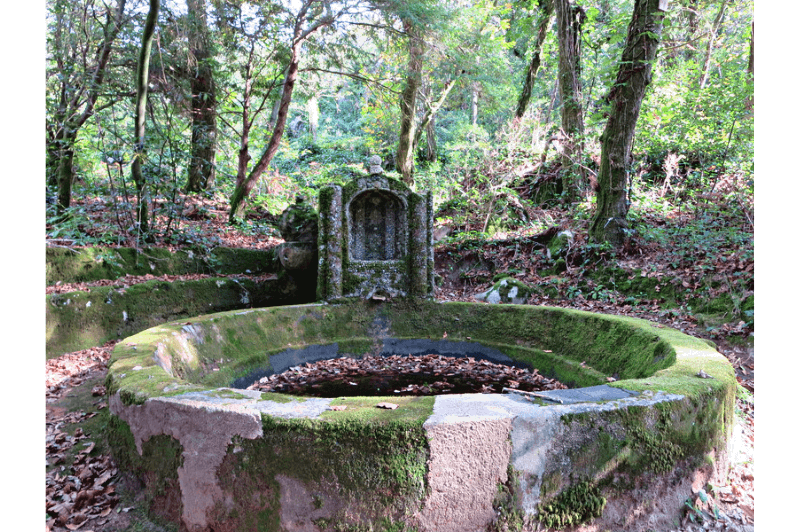
Definitely do whatever you need to do in order to spend a good amount of time in Sintra. Every major attraction in the town is totally worth seeing!
5 – 7 Days or More
If you have decided to stay longer in Lisbon, here are some of the more famous sights that you might want to visit.
More Things to do in Lisbon
These are the kind of tourist attractions that will be busier and you should plan your visit ahead.
Buy tickets in advance if possible, and go early in the day.
There are lots of other things to see and do in Lisbon, but nothing that I consider a “must-see.”
(I will explain why in a minute!)
In the spirit of slow travel , I think you should really walk and ride around to see what piques your interest.
Sao Jorge Castle (Castelo de Sao Jorge)
You really can’t miss the beautiful outline of Sao Jorge Castle while you explore Lisbon. It’s basically in the city centre, and it’s lit up at night.

The first fortifications occupied this spot as early as the 1st century. Many rulers over the years added to it until it was a castle and royal residence of impressive size.
At one time the castle had all but disappeared under military barracks and other structures built over top of it. Here is an interesting photo I found of Lisbon in 1877 .
Restoration of the castle took place in the 1930’s and 40’s to bring it back to the landmark that it is today.
The castle boasts several towers, an attractive inner courtyard with trees, and a museum. You can enjoy stunning views over the city from Sao Jorge Castle.
Sao Jorge Castle Ticket Prices
- Adult: € 10
- Student: € 5
- 65+ or people with disabilities: € 8.50
- Children (under 12): Free
Belem Tower
Belem Tower (or the Tower of Saint Vincent) is a fortification on the Tagus River from the 1500’s.
This UNESCO World Heritage Site was also named one of the “Seven Wonders of Portual.”

The fortress is more elaborate than a lot of the brick castles scattered around Portugal, and it managed to survive the great earthquake of 1755 that destroyed a lot of Lisbon’s other treasures.
Getting to Belem Tower
The fortress is a little ways out of the centre. You can catch a tram from Praça do Comércio straight down the waterfront to the tower. It takes about a half hour.
Your Visit to Belem Tower
As of August 2021 the inside of Belem tower is closed to visitors.
It was reported to be closed due to the pandemic, but the signs state something about it’s historical value, so perhaps it is going to be a restoration project of some kind?
If and when the tower reopens , you can climb the spiral staircase up all five stories to the viewing platform at the top. You could also tour the prison cells below.

This is one of Lisbon’s busiest tourist attractions, and the stairs are narrow and can get claustrophobic. If it reopens and you want to go in, arrive early in the day for your visit.
Ticket prices before it closed were: 6 Euros for adults, 3 Euros for Students & Seniors, Kids under 12 free.
Are Belem Tower and Sao Jorge Castle Worth Visiting?
It depends. If you have a lot of time in Lisbon to wander around and enjoy all the sights, then sure!
If you are planning to visit other places in Portugal, I would say that there are better castles and better fortresses to see.
Sightseeing fatigue is real , and as slow travellers , that’s what we are trying to avoid.
I would personally rather walk around the city centre, or sip coffee in a park, then take the day to visit these two sights, if I know we will be seeing LOTS of impressive architecture on our trip.
(Sintra being one of those places.)
Jeronimos Monastery
Another UNESCO World Heritage Site, Jeronimos Monastery (also known as The Hieronymites Monastery) is the most popular tourist attraction in Lisbon.

Considering Lisbon is the most visited city in Portugal, this means that Jeronimos Monastery could be the most popular tourist attraction in the country.
Any way you slice it, this place is busy.
Visiting Jeronimos Monastery
The monastery is very beautiful of course, having been built in the old Portuguese style. There is an inner courtyard, impressive gardens, and an epic cathedral.
If you have time, and you are visiting in the off-season, then a visit to Jeronimos may not be too busy for you.
If you want to skip the crowds, make the trip to the awe-inspiring Batalha Monastery instead. (Another of Portugal’s seven wonders, as is Jeronimos.)
Getting to Jeronimos Monastery
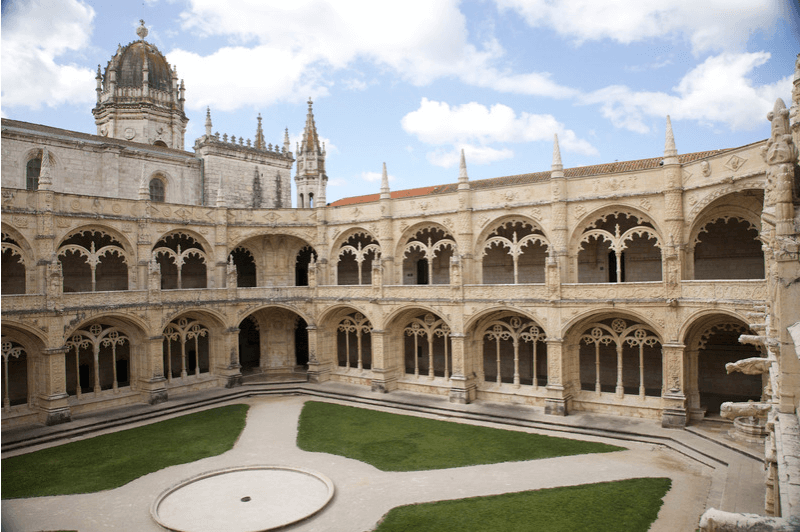
You can get to Jeronimos on the same tram from Praça do Comércio that you would take to go to Belem.
If you plan to visit both Belem Tower and Jeronimos Monastery, ask about the combo ticket (but only if Belem Tower is reopened to visitors by then.)
Jeronimos Monastery Ticket Prices
- Adults: 10 Euros
- Students & Seniors: 5 Euros
Ideal Lisbon 2 – 3 Day Itinerary
Now that I have covered all of these great things to do, I will say that I like Lisbon, I don’t love it.
For me personally, two to three days in Lisbon proper would be plenty. There are so many amazing places in Portugal, and if I’m going to settle in for a while, it just wouldn’t be in Lisbon.
(Again, I do like it and it is worth a visit.)
My ideal itinerary to Lisbon would be:
Days 1 – 3 : Lisbon
Days 4 – 7: Stay in Sintra with evenings in Lisbon.

Sintra or Lisbon
If you have to choose between Sintra or Lisbon, I would choose Sintra all the way. You can still do dinners and evening strolls in Lisbon, but also make sure that you see all the amazing sights in the village.
(Honestly, the train ride is not bad at all! I feel like it gives you the best of both.)
If you only have 2 days to see Lisbon:
Skip Sintra, and come back another time, because the visit will be deeply dissatisfying.
Spend your 2 days doing everything from “Day 2 & 3” in the itinerary above. It looks like a long list, but you can easily cover the city centre as well as visit the Oriente Station area in just two days.

Make Time to See Portugal
Portugal is truly an amazing country with a relaxed atmosphere and a staggering amount of history. Whenever possible, plan to spend a good amount of time here! You will find it so worth your efforts.
For my complete Portugal Slow Travel Itinerary , visit this article:

Slow Travel Portugal: You won’t want to leave!
For more of the Lisbon Aesthetic, here is my moodboard !
Want More Slow Travel?

A Solo Woman Traveling
Boutique Travel Guides & All-Female Luxury Tours

Lisbon Solo Travel Guide For First Timer’s + Map
Heading to Lisbon by yourself for the first time? With all the planning that goes into a solo trip , it’s totally normal if you’re feeling a little nervous.
But hey, there’s no need to worry. I’ve ventured to Lisbon solo more than once and have come back with loads of tips and stories to share.
Who better to guide you through the ins and outs of exploring Lisbon alone than someone who’s done it themselves?
Whether you’re feeling overwhelmed by the idea of planning your journey or just looking for some insider advice, I’ve got everything you need right here!

Human-written content, by me, and nearly all original images, unless stated. Posts could have affiliate links to help offset the cost of maintaining this blog. When you click on a link we receive a small commission. This is at no extra cost to you. See Our Affiliate Policy and Advertiser Disclosure for more info.
What To Expect Arriving In Lisbon
Lisbon, Portugal’s capital , is a trendy European destination for expats and solo travelers. From my experience, many locals have a good grasp of English and can help with basic inquiries , though not everyone might be fluent.
The people of Lisbon are much friendlier than in other European cities such as Paris , for example. I have also felt very safe alone in Lisbon, even walking alone at night.
Just use your common sense —while Portugal’s crime rates are low, it’s wise not to leave your stuff unattended.
Overall, choosing Lisbon for your solo trip is a great idea . It’s a friendly and safe place where you can explore, eat delicious food, and meet nice people.
Lisbon is full of fun and interesting things to do, and it’s a city that will make you feel welcome right away!
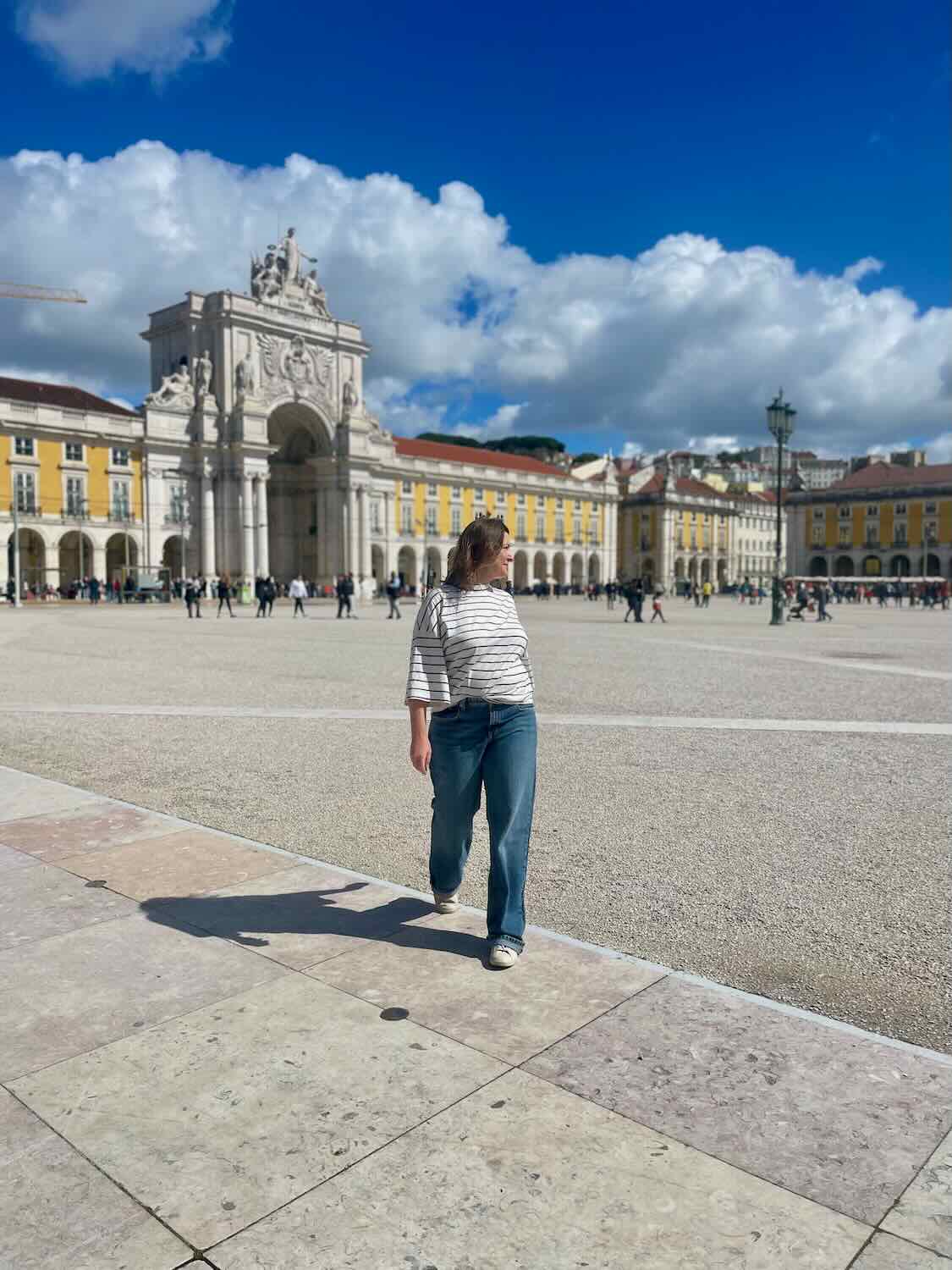
How to Get To Lisbon From Humberto Delgado Airport
Getting to the city center from the Lisbon airport is very easy! Depending on your comfort level as a solo traveler, you can choose which is best for you!
By Train🚊
Lisbon’s metro system is super convenient and easy to navigate, even if it’s your first time visiting. As you step out of Airport Terminal 1, just follow the metro signs to find your way.
If you happen to arrive at Terminal 2, no worries—you’ll need to head over to Terminal 1 first, which you can do by either walking or catching the shuttle bus.
Once you’re at the metro, take the escalator down to the subway level. You’ll notice red ticket machines to your left, where you once had to buy a ticket to the city center.
However, Lisbon has updated its system , making things even more straightforward. Now, you don’t need to buy a ticket at all . Simply tap your credit card at the entry gate and again when you leave the station.
The metro is open from 6.30 am to 1 am and a single fare costs €1.80 . 📲 Download the Lisbon Subway Map here!
By Uber / Taxi 🚕
If you are traveling with a lot of luggage or just are not comfortable taking public transit you can get an UBER or taxi.
Taxis are lined up outside either terminal . In a taxi you can expect to pay from €12 to 15 euros to the city center from the airport.
🛑 Not all taxis accept credit card s, so be sure to ask upon entering.
For Uber , just follow the signs as you exit Terminal 1. These will guide you to the P2 parking area right outside the arrivals hall. My experience is that Ubers are always less than taxis and most recently I paid around €10.
📲 Get all my tips for Portugal + a Free Google map when you subscribe to my newsletter!
Is Safety A Concern in Lisbon for Solo Travelers?
Solo travelers can feel safe in Lisbon, the seventh safest capital worldwide, thanks to Portugal’s low violent crime rates . It’s impressively safe for a major city.
That said, it’s still wise to stay mindful of your belongings. Like in any large city, pickpockets exist, though neither I nor anyone I know has personally experienced theft here. It’s rare, but it’s always better to be cautious.
This is one reason I always opt for travel insurance on my trips . Whether it’s the risk of losing something or the chance of theft, it’s comforting to know you’re covered. You can never be too prepared.
Women traveling solo can confidently explore the country on their own . I’ve journeyed alone to both Porto and Faro by train and felt entirely secure throughout my travels.
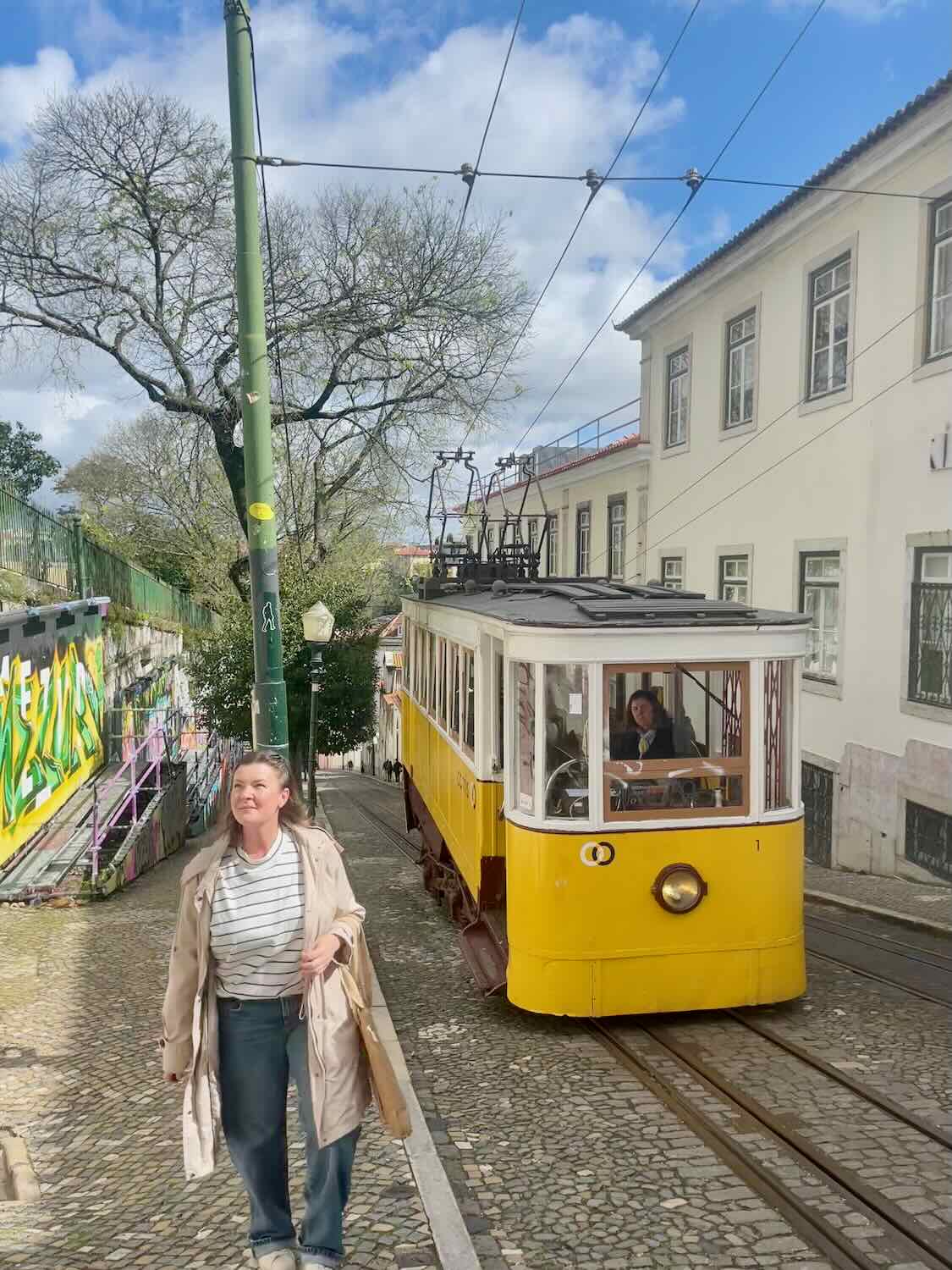
Best Areas To Stay Solo in Lisbon
Whenever I’m visiting a city by myself, I make it a point to stay in the city center , even if it means spending a bit more . It’s worth the extra cost vs staying on the outskirts and feeling a bit insecure.
Here’s a quick guide to picking a neighborhood in Lisbon:
- Chiado : Ideal for those who love shopping and trendy cafes.
- Principe Real : Perfect for boutique shopping and scenic parks.
- Alfama : Great for experiencing traditional Fado music and historic streets.
- Cais do Sodré : Best for clubbing & nightlife and eclectic dining.
- Barrio Alto : The go-to spot for party-goers and bar hoppers.
- Baixa : Excellent for first-time visitors wanting to be close to major attractions.
🛌 Search for hotels in Lisbon by neighborhood!
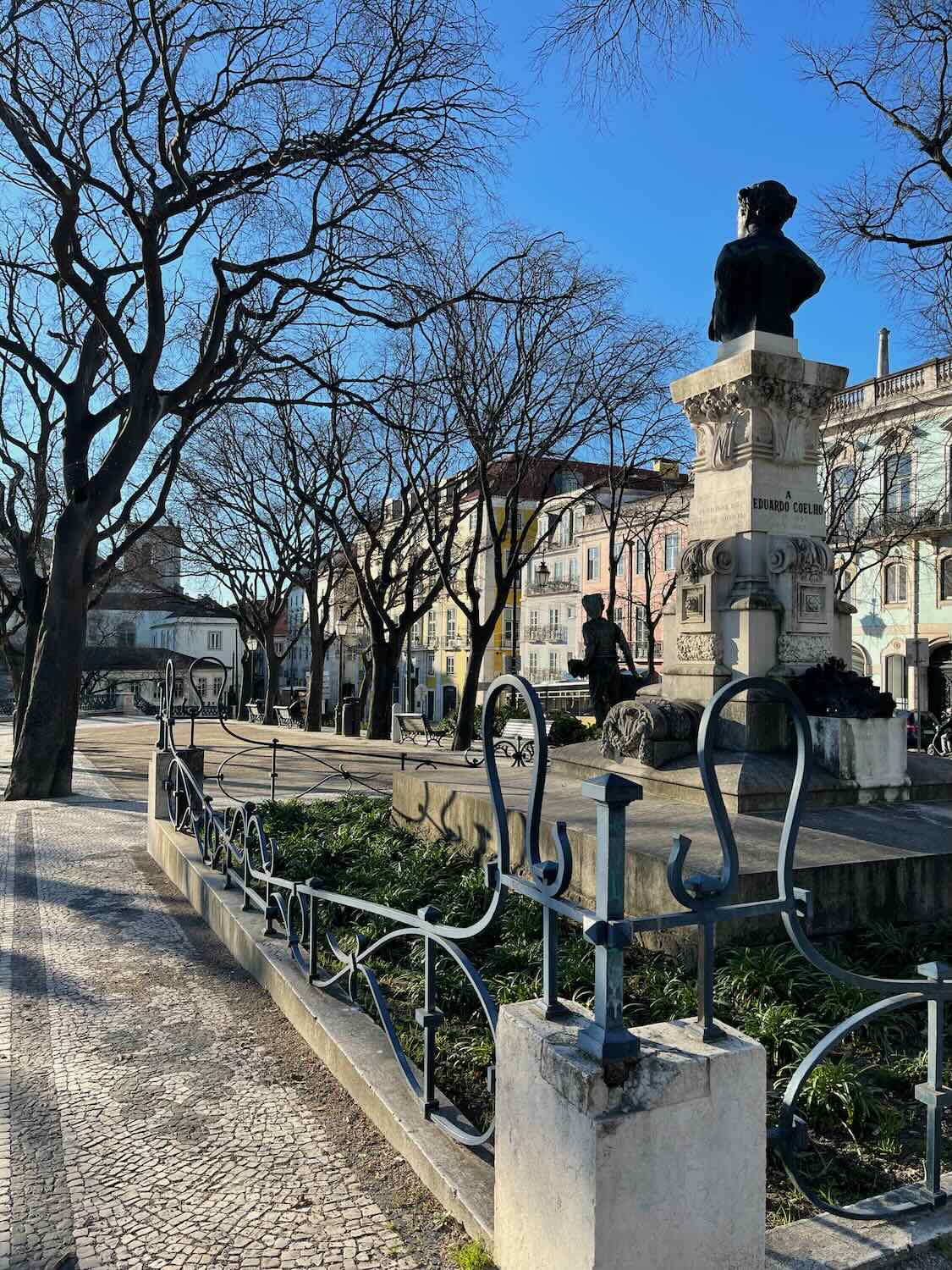
Lisbon’s Best Hostel For Solo Traveler
Staying in a hostel is a great way to meet people when you are traveling alone. But staying in the “wrong hostel” could do damage to the enjoyment of your trip!
Everyone raves about Yes! Lisbon Hostel , so I had to check it out for myself to see if it was actually worth staying here.
And I have to say that this place checks out! It’s well kept, conveniently located, and has AIR CONDITIONING , which, news flash, is a big deal in Lisbon!
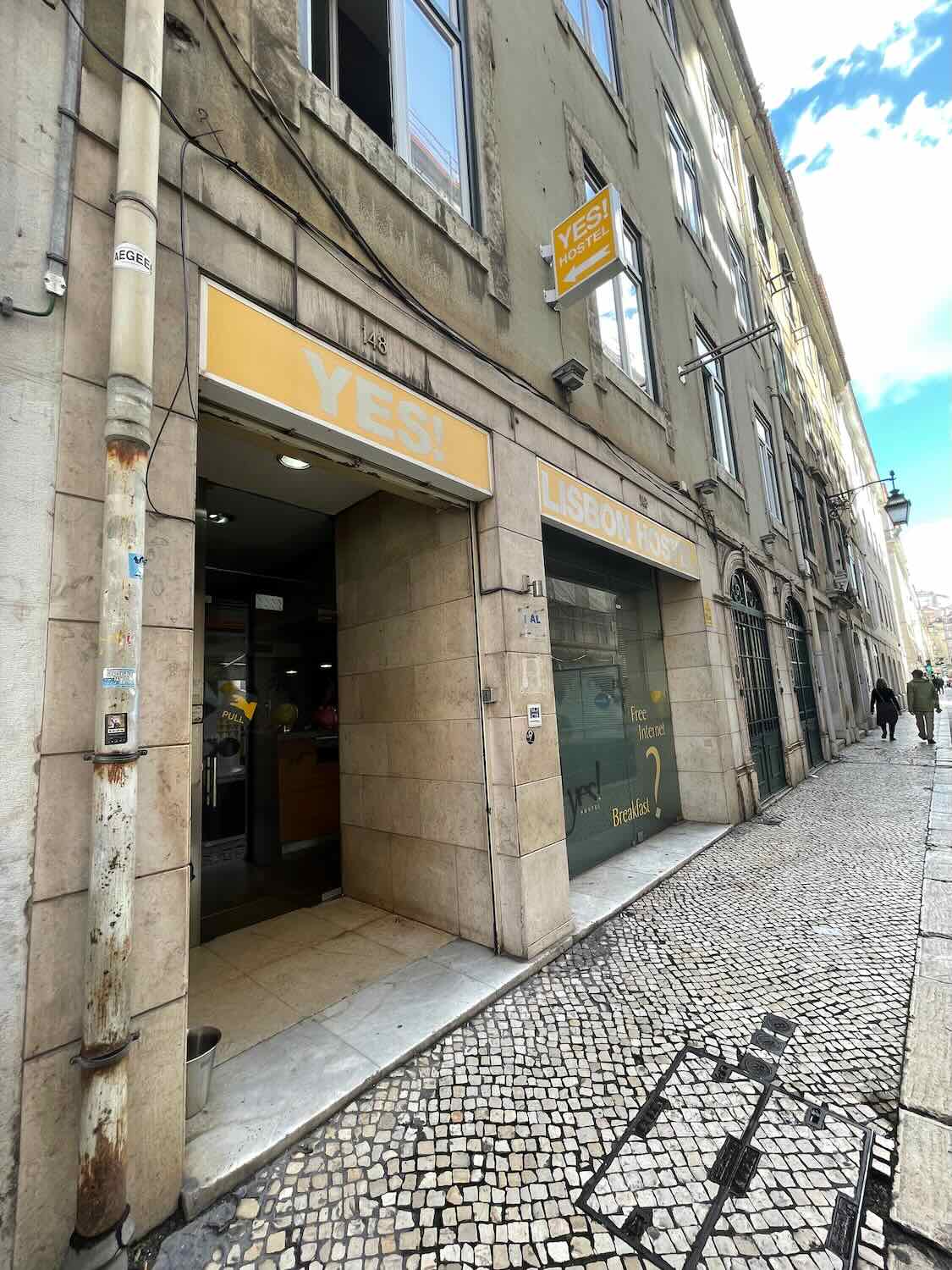
Best Hotel in Lisbon for Solo Travelers
If hostels aren’t your jam , I totally understand. They’re definitely an acquired taste, not for everyone.
Lucky for us, there are some fantastic hotels out there that won’t make your wallet cry, especially for solo travelers. My absolute favorite? Alecrim ao Chiado.
It’s right in the heart of everything, offers the bliss of air conditioning, and won’t break the bank. Perfect for solo adventurers looking for a bit of comfort without the hefty price tag!
🛑 Neighborhoods to Avoid in Lisbon
Some neighborhoods may seem central, and the hotels might even have good reviews, but you should still consider avoiding them when possible.
This area sees a little more homeless than you want to see walking alone at night. Not to be worried if you do end up staying in this neighborhood, just be more vigilant.
Martim Moniz
Located north of Baixa-Chiado, and not a wildly unsafe area , but an area to avoid if possible . If you find yourself here during the day you are not to worry, there are just nicer areas to stay where you would feel more comfortable.
If you are aiming to stay central, you won’t even come across Chelas. Located just east of the airport , it is a neighborhood that has social housing and has had more issues in recent years.
Fun Things To Do Alone in Lisbon
Traveling by yourself is like having the ultimate freedom to do whatever you feel in the moment! One huge perk of solo travel in Lisbon?
There’s an endless list of things to dive into , so boredom is off the table, guaranteed. Check out my go-to list of activities to keep your adventure in Lisbon jam-packed with fun.
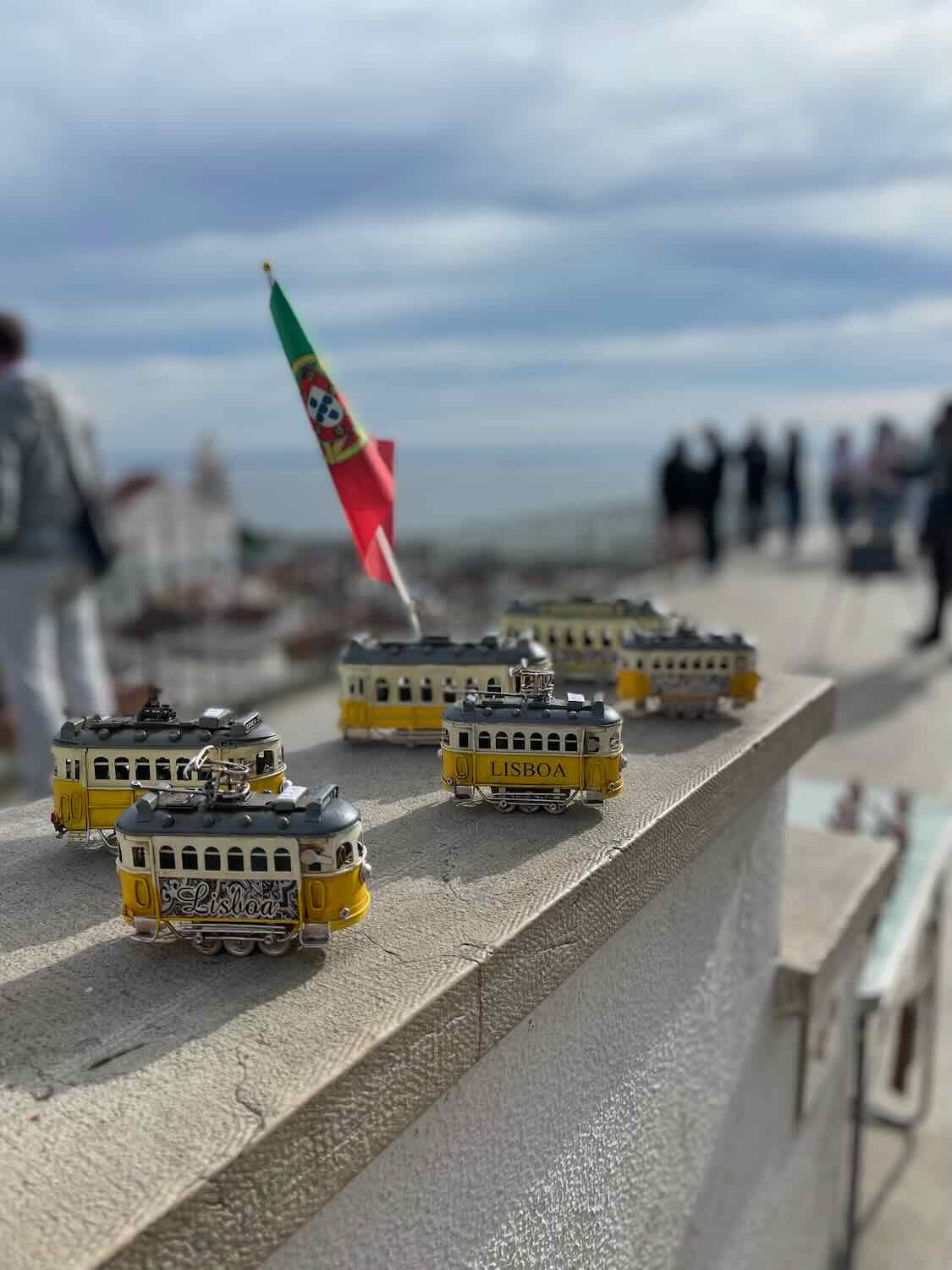
Explore Castelo de S. Jorge (SÃO JORGE CASTLE)
You don’t have to be a history lover to enjoy a visit to the iconic hilltop castle, Castelo de S. Jorge . This castle dates back to the 11th century when it was a Moorish fortification.
Plan to spend around an hour exploring the interiors and climbing the walls for different viewpoints of the city.
Pro tip: Try and time your visit around sunset! The panoramic views are spectacular.
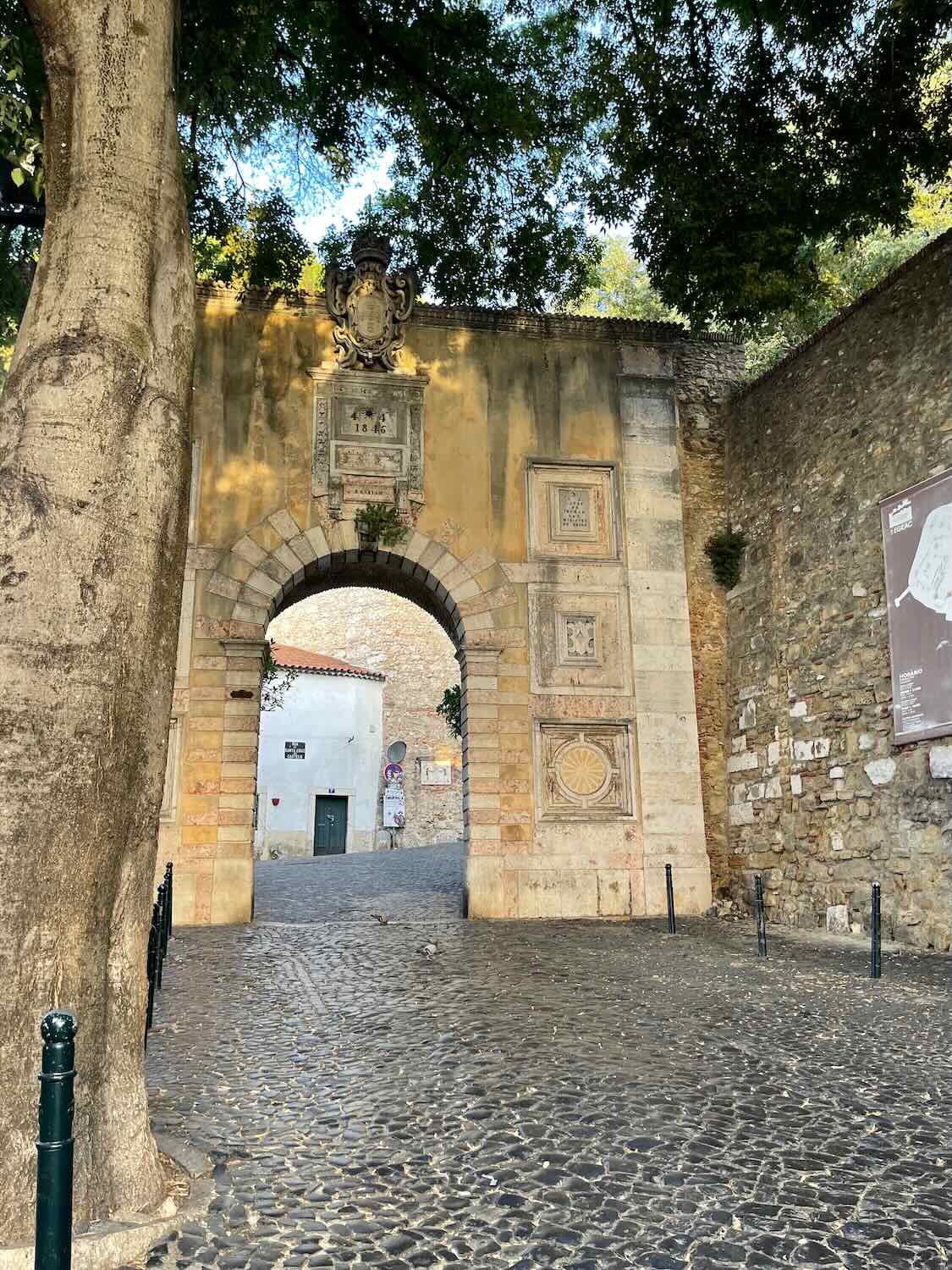
🎟️ GET YOUR TICKETS ONLINE : The amount of people who just show up and wait in line baffles me. The online ticket costs a few bucks more, but it is worth it. Stand in line entry to the castle is €15 . It will gives you access to the grounds, towers, and exhibitions inside this significant landmark. Open daily from 9:00 to 21:00 (may differ on holidays).
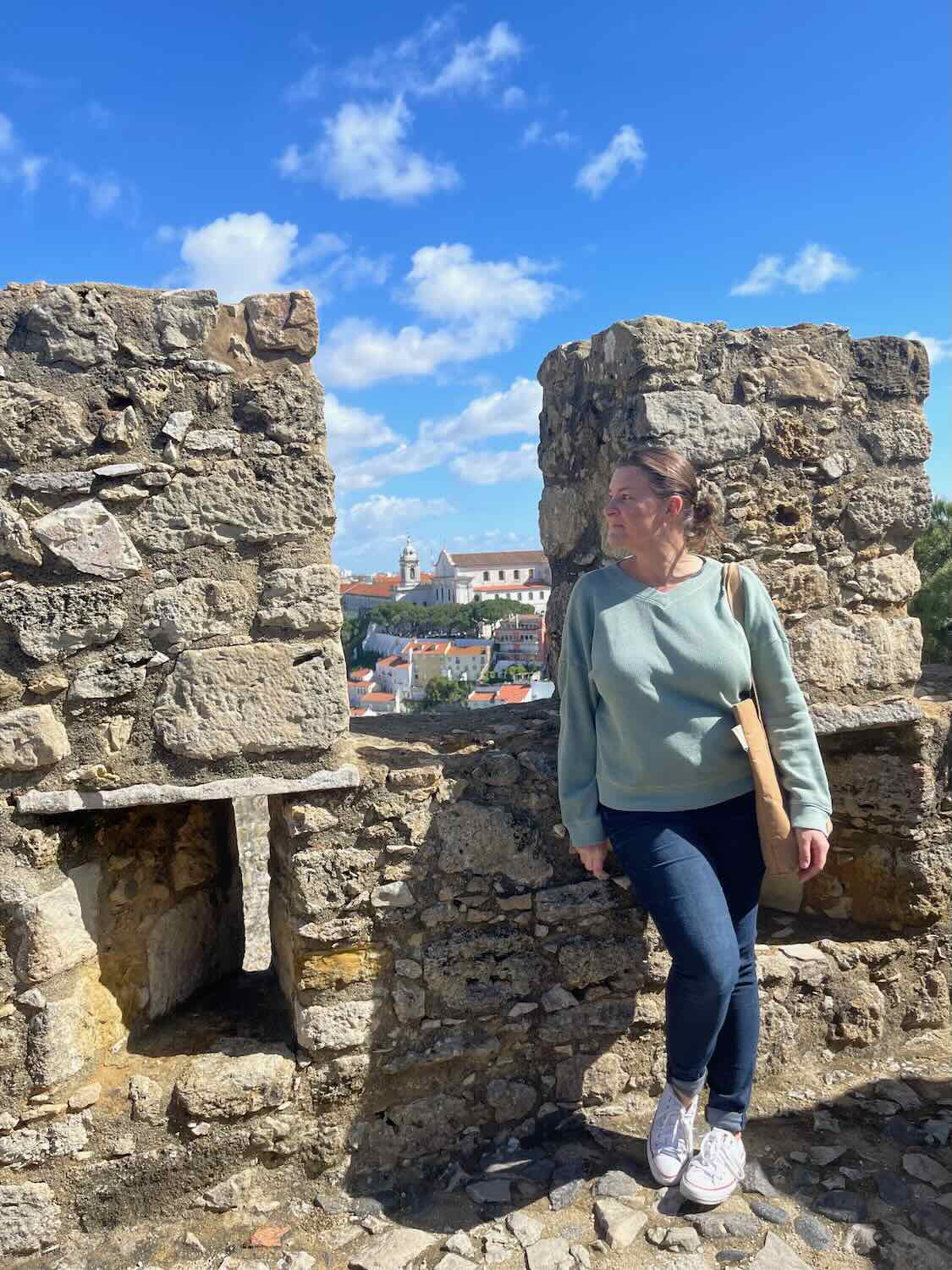
Ride The 28 Tram
The 28 tram in Lisbon takes you on a cool ride through the city’s old and beautiful spots. It starts at Martim Moniz, then goes up to the Graça area where you can see awesome views of Lisbon.
This tram zigzags through Alfama, Baixa, Chiado, and Bairro Alto, towards Estrela , passing by Basílica da Estrela, ending in Campo de Ourique, near Prazeres cemetery.
This tram ride is a fun way to see many different parts of Lisbon and some famous spots.
🎟️ You can get a ticket when boarding the tram for €3 or buy a prepaid ticket at any metro station. Just buy the Navegante Card and pre-load it with at least €6.

Eat Pastel de Nata on a Terrace with a View
Have your Pastel de Nata and eat it with a view! Lisbon is known for its kiosks selling coffee, tea cocktails, and delicious snacks!
My favorite kiosk in Lisbon is located at Quiosque Porta Do Sol .
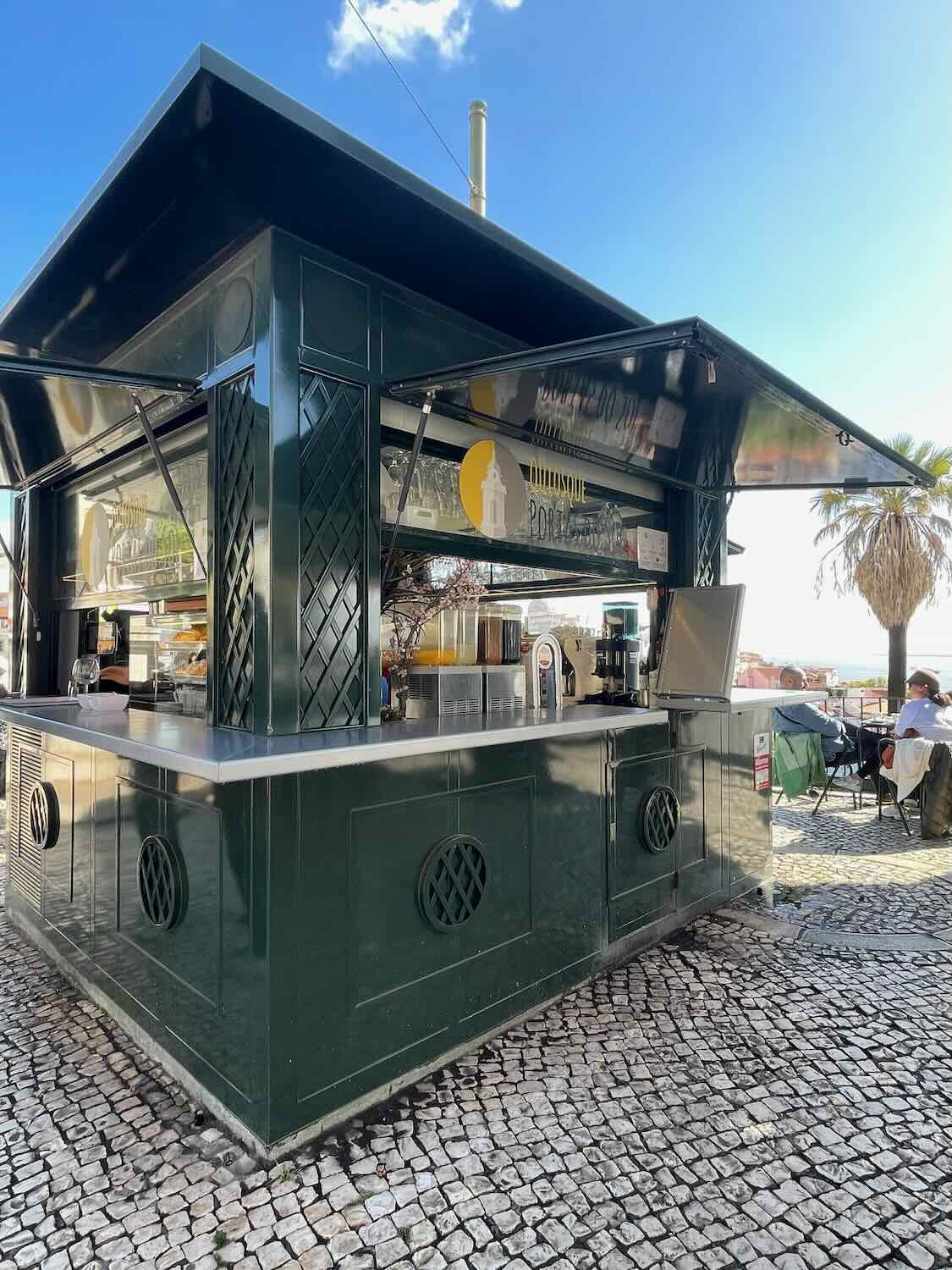
Go to a Fado Show
Going to a Fado show is touristy, sure, but it’s totally worth it . It’s one of those must-do things in Lisbon! For those that don’t know, Fado is this really emotional type of Portuguese music . Hearing it live is super special.
You’ll find these shows, often including dinner, in cozy spots, like small bars and old-school restaurants. I can recommend O Corrido in Alfama.
It was €47 (CASH ONLY) for a 3-course dinner and a show.

Shop for Crafts & Books at LX Factory
If you are looking for unique handmade gifts and cool souvenirs you should make your way to LX Factory . It is most popular on weekends with additional vendors.
The old industrial complex turned shopping & dining spot is full of street art and one-of-a-kind finds!
LX factory is outside the city center, but a quick and cheap UBER can get you there in no time.
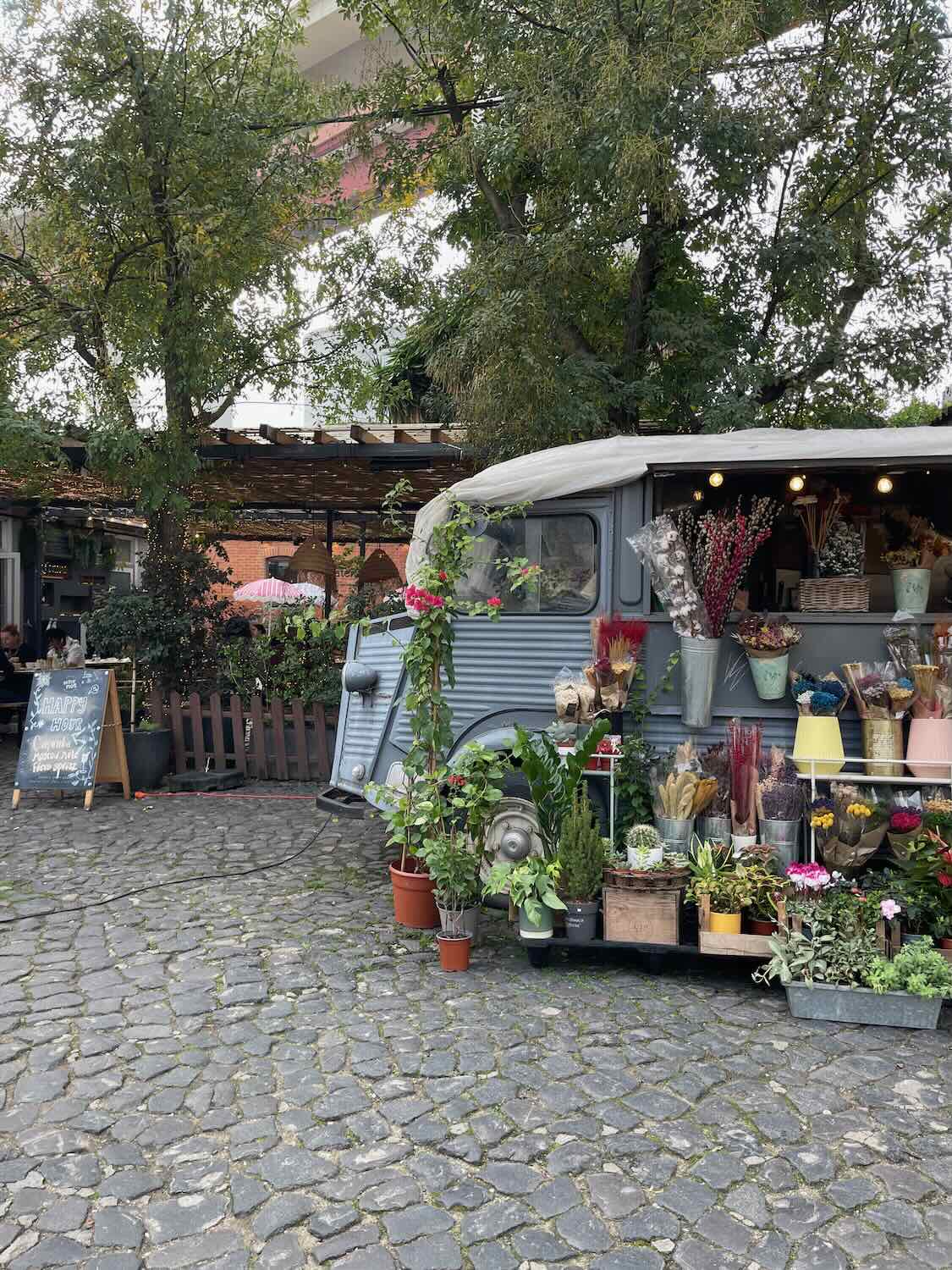
Explore Belém Tower and “Padrão dos Descobrimentos”
Something to pair well with a day to LX Factory is going to explore Belém and the Padrão dos Descobrimentos monument. These attractions are just beyond the LX factory a few more stops on the train.
Start by getting off the train from Cais do Sodré to the Belém stop . First, walk to the Padrão dos Descobrimentos, then walk ahead to the Belém tower.
You can climb to the top of the tower for some great views, but if the line is long, you could skip it.

Browse at Feira de Ladra ‘Thieves Market’
Browsing at Feira de Ladra market , known as the ‘Thieves Market,’ is a fun way to spend a day on a Tuesday or Saturday (closed the rest of the week).
It’s more antiques and buried treasured than anything else. It is free to enter and located in the Campo de Santa Clara area, near the National Pantheon ( Church of Santa Engrácia ).

Have a Drink in Bairro Alto on a Rooftop for Sunset
A little hidden gem in Lisbon is the Rooftop bar at the Barrio Alto Hotel ! It is the BEST place to have a cocktail as the sun sets over the city.
It might be smart to call ahead and see if you can get a reservation. As a solo traveler, I often get lucky and can sneak in, but you might want to play it safe.
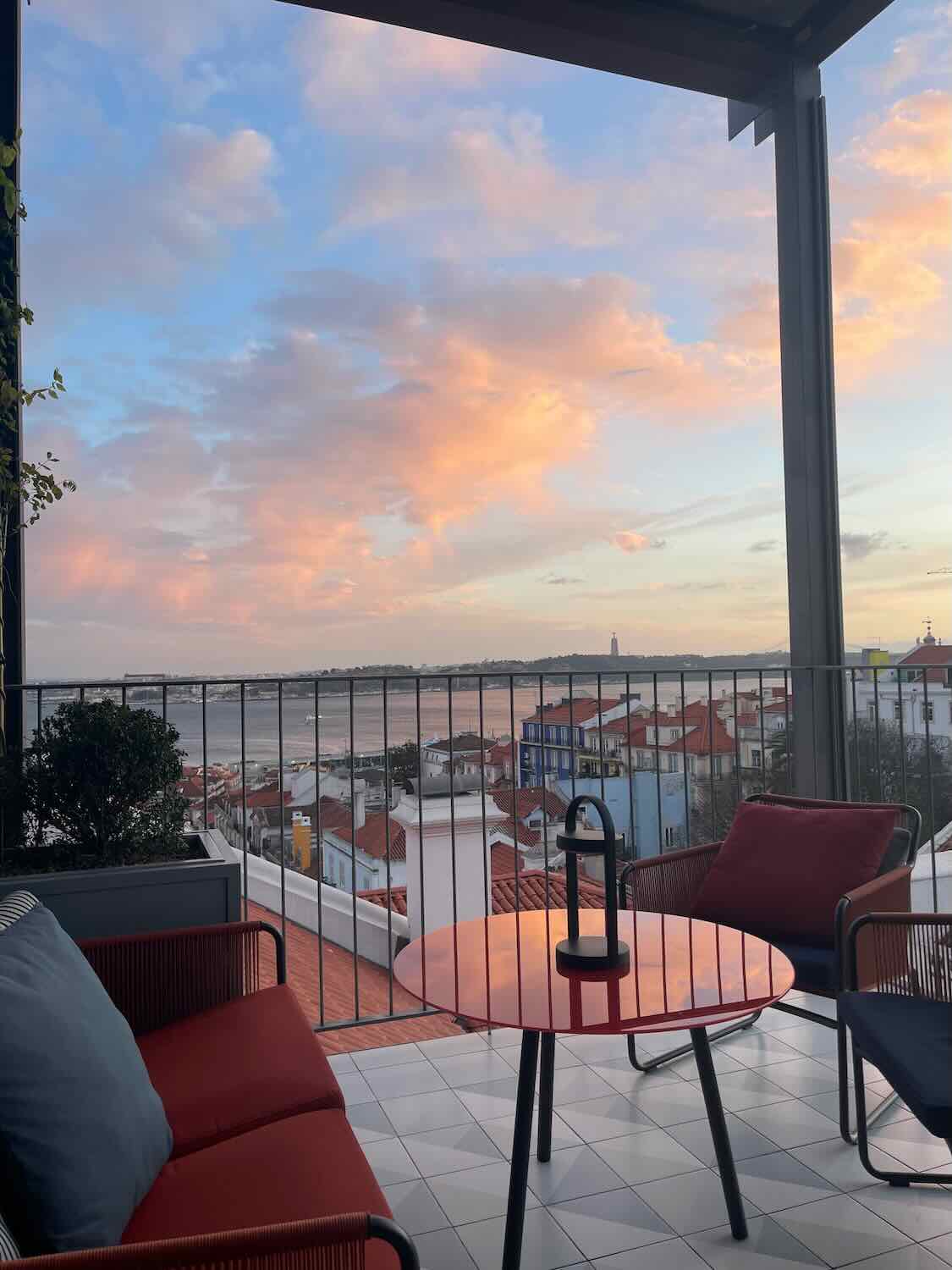
Visit Praca do Comercio and Rossio Square
It’s almost safe to assume that you won’t miss the 2 famous squares in Lisbon, the Praca do Comercio and Rossio Square!

Things not to miss in Praca do Comercio are:
- Lisboa Story Centre: Interactive museum of the history of Lisbon and the earthquake of 1755.
- Martinho da Arcada: The oldest cafe in Lisbon where famous poet Fernando Pessoa frequented.
- Ribeira das Naus : Waterfront promenade along the Tagus River.
Things Not To Miss in Rossio Square:
- A Ginjinha : Just off Rossio, visit this tiny bar to try Ginjinha, a sour cherry liqueur.
- Rossio Gastrobar : An incredible spot for a rooftop cocktail and snacks at sunset.
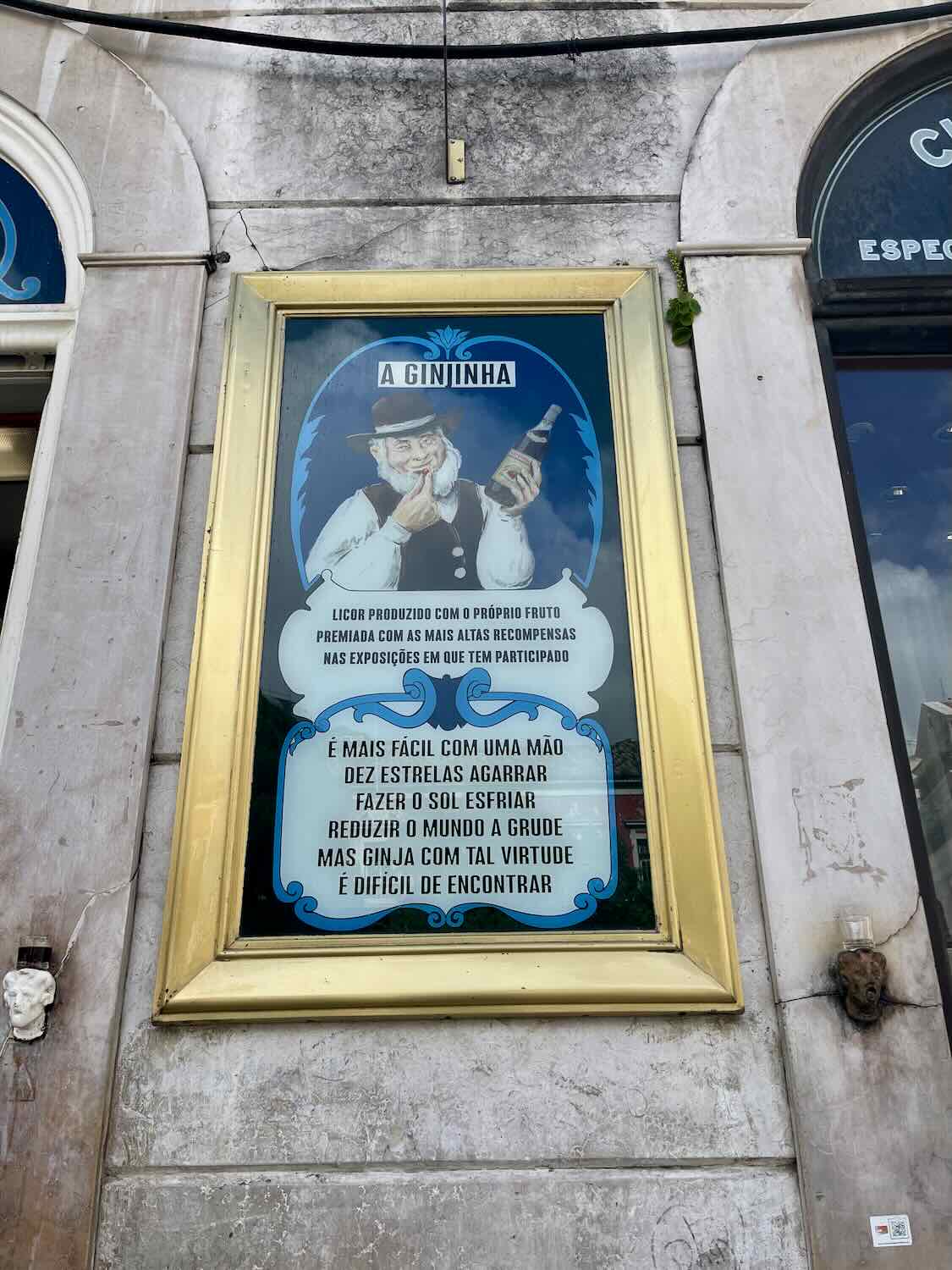
Visit the Cathedral
If you’re in Alfama, you’ll definitely see the big Cathedral, Sé de Lisboa. It’s a nice spot to chill and grab a coffee at the nearby kiosk.
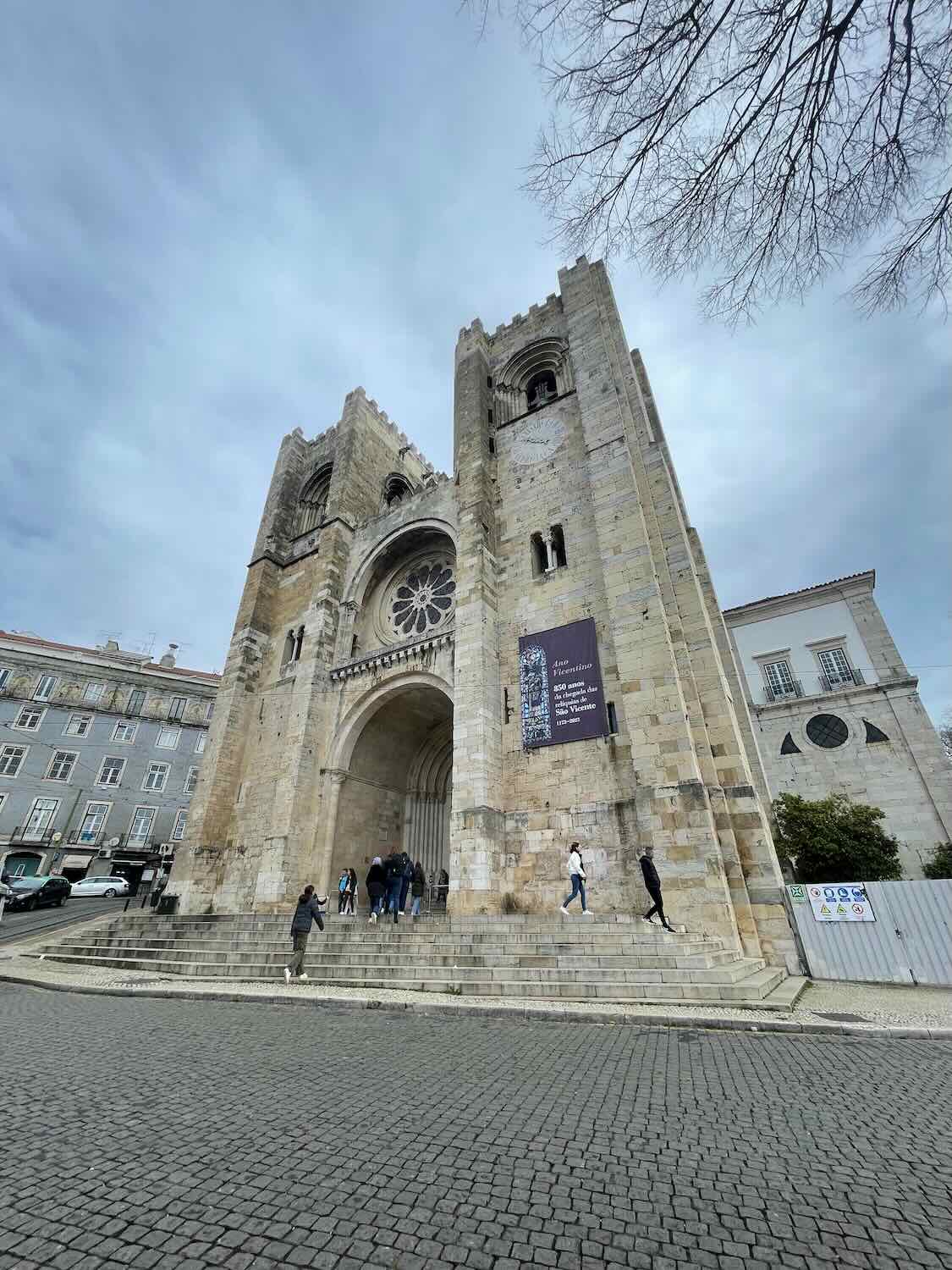
Take a Day Trip
While there are more than a couple day trips you can make from Lisbon, there is two you should really consider.
If the weather is nice, a day trip to the beach town of Cascais is a no-brainer! Just 40 minutes north and you will arrive in the most beautiful coastal town. I would plan to spend at least 2-3 hours walking around and exploring.
Alternatively, you could make the day trip to Sintra! Another 40-minute train ride will take you to this magical forest with the most incredible castles, museums, and old town.
Deciding between Cascais or Sintra can be tough, hopefully, you have time for both!
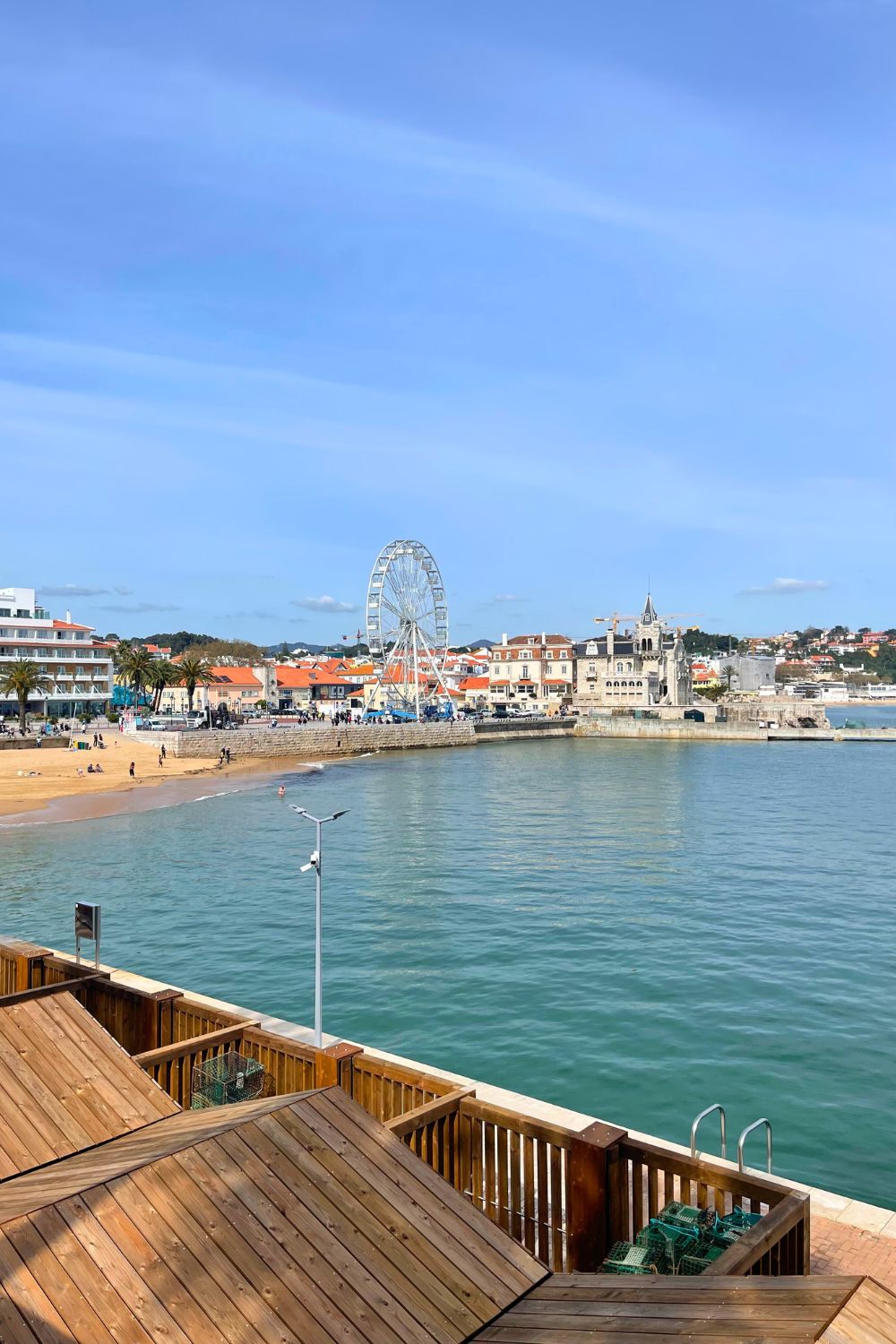
Getting Around Lisbon
Many of the attractions in Lisbon are all within walking distance of each other which makes it very convenient. However, something you need to have to get around easily in Lisbon is stamina!
You might have seen memes and funny Instagram reels of people going 100 meters straight uphill. And it’s no exaggeration. Lisbon is full of steep inclines and hundreds upon hundreds of stairs.
Luckily there is a metro, BUT the metro doesn’t get close enough to some of the places you might want to go. Trams will take you within the neighborhoods and up those hills, but thanks to tourism, they can be very crowded.
My advice is get some comfortable shoes, and don’t worry about how they look, you’ll appreciate the tip.
PRO TIP: I know it sounds “gimmicky” but you should really get the Lisbon card! It comes with free access to the transit system + loads of attractions.

Things to Be Cautious of in Lisbon
- The titled sidewalks are pretty, but VERY SLIPPERY! Most slippery when wet and in the heat. It can be downright dangerous, especially if you have mobility concerns. Bring slip-proof shoes like these.
- Stay clear of Drug Pushers . More common in areas like Barrio Alto or on Pink Street, you might encounter people pushing drugs. Just walk away.
- Don’t assume all hotels have air conditioning . Surprisingly many don’t and the summer months get very warm.

Where to Next?
After you’ve fully explored Lisbon you might be wondering where you should go next? Another city that is fantastic for solo travel is Porto!
While I’d argue you need more than 24 hours in Porto , if that’s all you have you should go! Porto is located north, 3 hours by train from Lisbon.
It is the 2nd largest city in Portugal with so much to see and do it’s the perfect next destination! The weather in Porto is less pleasant than Lisbon, so if that is the case, you can also consider visiting the Algarve for a few days!
Faro is located just 3 hours south of Lisbon and it is a good base to make many day trips from!
No matter whether you go north or south, you will certainly love all the solo travel you can do within this beautiful country!
Melissa Byron, a seasoned solo traveler since 2009, is the founder & visionary behind A Solo Woman Traveling. Drawing from her extensive personal experience globetrotting solo to over 40 countries, she has dedicated herself to a mission: crafting invaluable guides and itineraries for women who embark on solo adventures.
Related Posts

Are Solo Trips to Greece Safe For Women? The Truth From Female Travelers
If you are wondering “is Greece safe for solo female travellers” you’ve come to the right place. I have been taking solo trips to Greece for the past 10 years! It’s definitely a safe place for women to travel. In 2023, I moved and found a new home in Athens, a place where I’ve always…

Foolproof Copenhagen 3 Day Itinerary + Map
Three days in Copenhagen will go by in the blink of an eye, so if you need help to craft a truly foolproof Copenhagen 3-day itinerary, I’ve got you covered. I’ve been to Copenhagen so many times, I consider myself a local. My itinerary, ideal for first-timers, hits every must-see spot and hip restaurant, in…
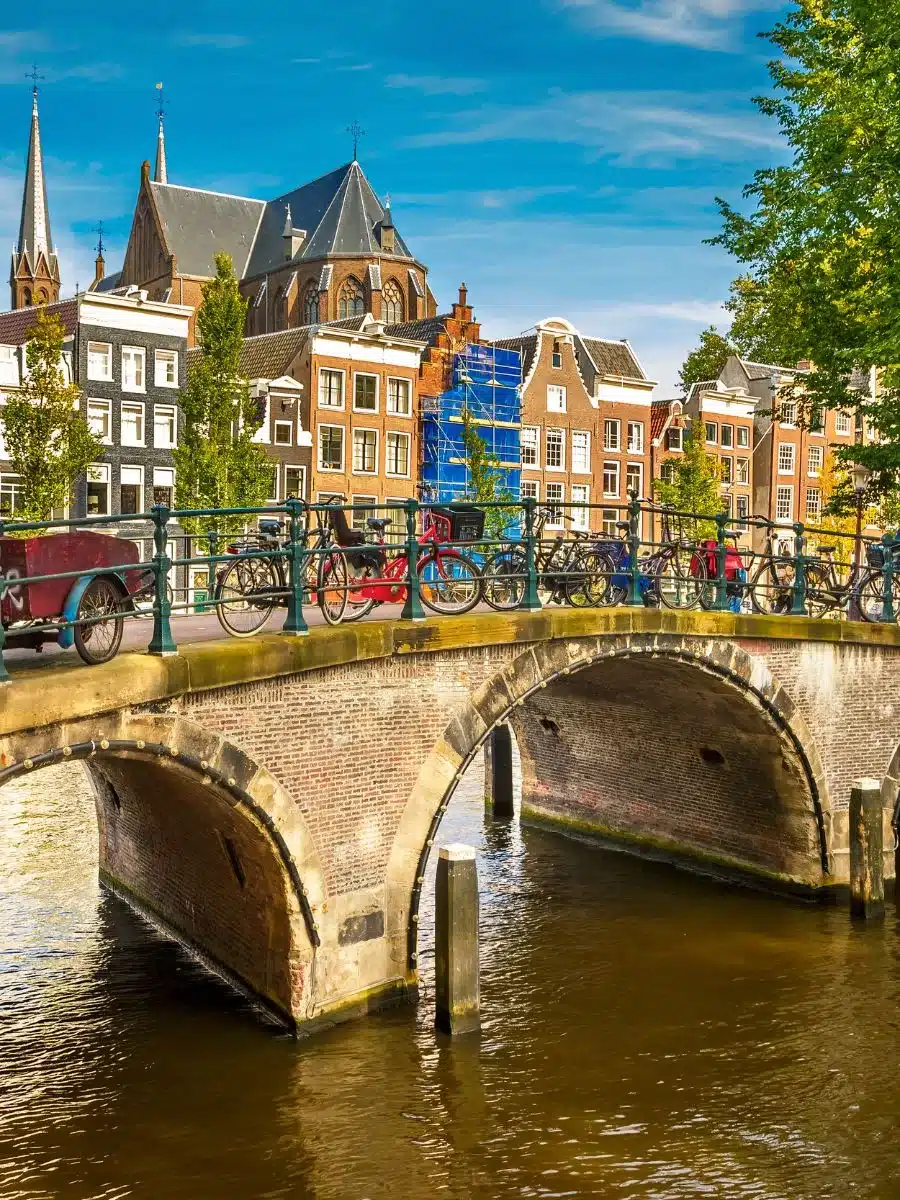
Ultimate Guide For a Safe Solo Trip to Amsterdam + Map
Back in the day, when I was figuring out the ropes of solo travel, safety was my top priority. I’d spend hours searching “Is Amsterdam safe for solo female travelers?” and looking for the safest places to stay. Now, after hitting up Amsterdam solo on three different occasions over the years, I’ve decided to put…

The Complete Day Trip to Verona Itinerary & Guide + Map
Let me take you on a day trip to one of my favorite Italian cities, VERONA! I’ve been to this picturesque town twice in the last few years! It is one of the easiest places to reach from nearby destinations such as Milan, Florence, and Bologna! Depending on where you are in Northern Italy, Verona…
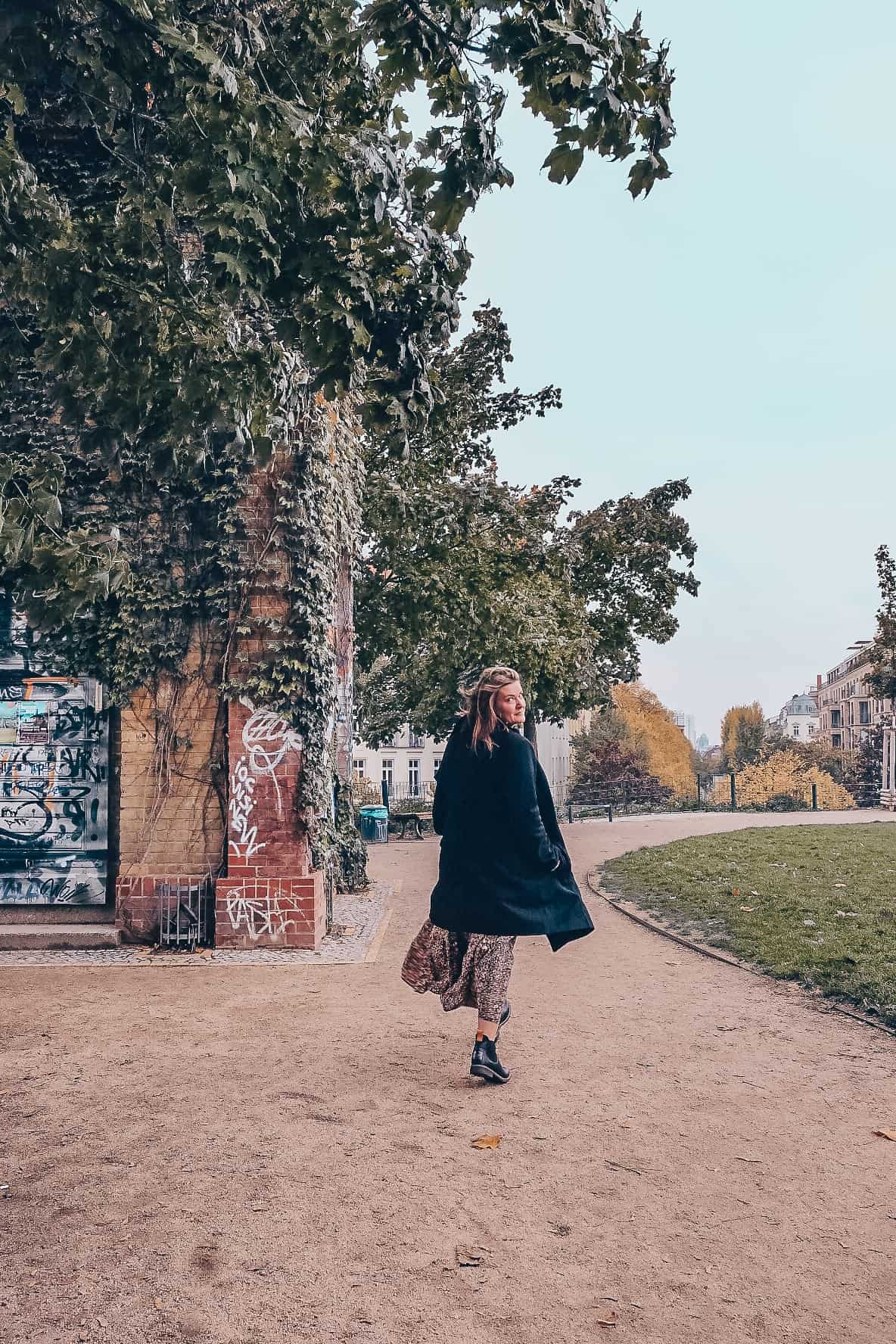
The 5 Reasons & Life-Changing Benefits of Traveling Alone
Traveling alone is a life-changing step towards achieving inner confidence and strength. Once I started traveling, my world began to open up, and what I wanted for myself began to change rapidly. With each trip I took, I learned something new, and my life goals adjusted. I want to share my story and talk about…

The Top 5 Concerns For Solo Female Travelers
So you are planning on traveling solo? Hi, I’m Melissa, a single woman traveling alone for over a decade now. I’m very familiar with the questions should you be asking yourself about traveling by yourself. This whole site is a dedicated resource and guide to all things solo female travel. Once you declare your adventurous…
What are you looking for?

Visiting Portugal: Itinerary for “Slow Travel”
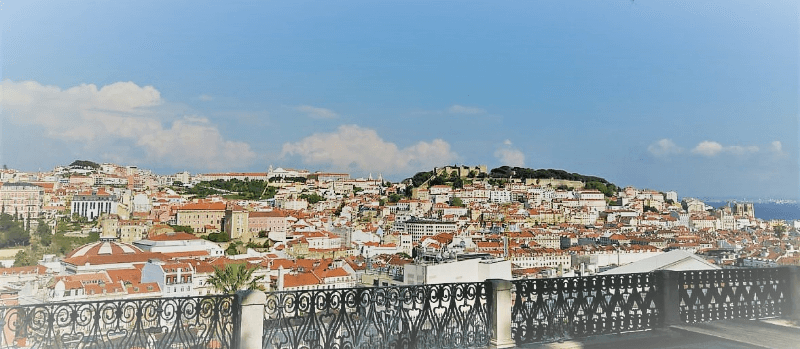
One of the best places to visit in Europe is a unique blend of old world charm and modern convenience. It’s also extremely affordable. What country is that? It’s Portugal!
Portugal offers the European experience at Latin American prices, and it’s the perfect destination to get the best of both worlds.
Despite its small size, this diverse country has a little bit of everything. Whether you have a week or 3 months, you won’t run out of things to do in Portugal. We spent more than 2 months exploring Portugal’s vibrant cities and beautiful coastlines, and we can’t wait to return!
Here’s a taste of our experience to help you plan your Portugal itinerary.
Contents (click to expand)
Slow Travel in Portugal
First of all, what is slow travel ? We also call it “local style” travel, and it’s how we spend most of our time when traveling overseas. For us, it means we focus on experiencing what it’s like to live in the places we visit, so we stay in short-term apartments rather than hotels.
We seldom visit more than a few major tourist attractions in an area, because we prefer to simply enjoy day-to-day living.
| Related Reading: This American Retired to Portugal at Age 50
Here are the places we visited in Portugal and a few highlights from each location. At the end, you will find more details about the logistics of travel to and within Portugal.
First Stop: Porto
Although Portugal is quite small by American standards (you could drive the length of the entire country from north to south in about 6 hours), Porto is considered “Northern Portugal.” Indeed, it has different weather and a completely different vibe from Lisbon and Algarve, the other main areas we visited.
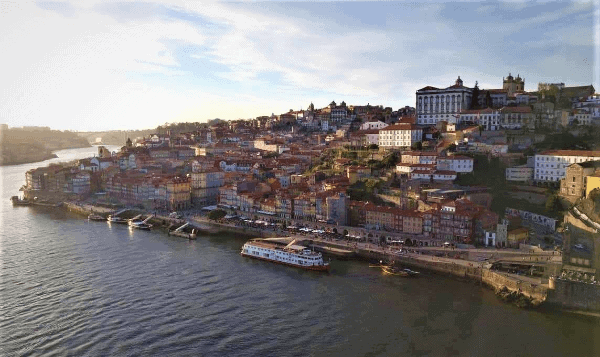
We arrived in mid-March and were quite lucky with the weather; virtually every single day was bright sunshine. Normally, we were told, March is rainy season, and Porto is known for its frequent morning fog.
We spent our first week in an apartment in the popular Ribeira neighborhood (on the Douro river), very close to many of the major sites in the “old city.”
As we often do when visiting a city for the first time, we took a hop-on, hop-off bus tour to get the lay of the land. The tour helped us identify places we wanted to spend more time.
The top place that caught our attention was the beautiful, rugged coastline and beaches in the neighborhood called Foz do Douro. Within a couple days of arriving in Porto, we decided to extend our stay so we could spend time in that neighborhood by the beach, and we found a fantastic deal on a Foz apartment.
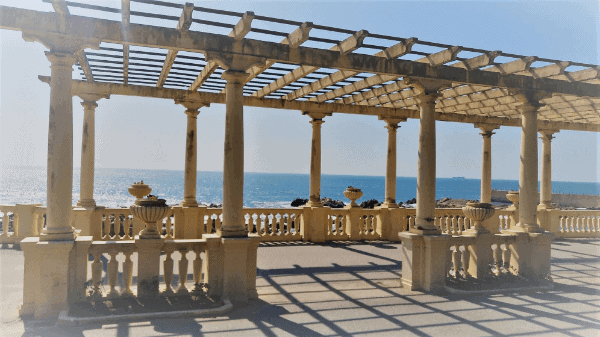
In total, our stay in Porto was almost 2 weeks, and it was divided into two distinct phases. During our first week, we were much more ambitious with our touring, and we explored the city daily.
Once we moved to Foz, we mostly enjoyed the coastline and the neighborhood. It has a much more “local” feel than the old city of Porto and is less crowded.
Things to Do in Porto
Here are a few things to see and do in Porto that we recommend:
Hop-On, Hop-Off Bus Tour
The hop-on, hop-off bus tour gives you a great overview of the entire Porto area, and I recommend doing it your first day in Porto. The two-day pass is a good choice because it allows you to take your time. If you get off and want to spend a few hours in one spot (Foz do Douro, for example!), you can pick up where you left off the next day.
An even better deal is the package that includes the Hop-On, Hop-Off bus plus a Douro river cruise and port wine cellar tour. At only a few dollars more per ticket than the bus-only tour, it’s a good value.
Click here to reserve the package tour .
Livraria Lello
This local landmark tops many lists of the world’s most beautiful bookstores. It’s famous for its architecture and décor. Livraria Lello is also said to be the inspiration for the Harry Potter series (author J.K. Rowling lived in Porto for several years).
If you visit, I recommend going on a weekday as soon as the store opens to avoid the crowds. You must purchase a voucher for €5 to enter the store, but the amount is credited to your purchase if you buy a book.
Wine Cellar Tour
A visit to Porto would not be complete without tasting port wine. We did the tour through the cellars of Ferreira and tasted three of their delicious wines. Of course, we also bought a couple bottles!
Get more bang for your buck by doing this tour instead, which includes a 3-hour walking tour and tastings at three different wineries.
Enoteca 17-56
One of our most memorable experiences in Porto was at this winery, restaurant, and museum . We stumbled upon it while waiting for Ferreira to open. My husband saw the words “cigar club” and wanted to check it out, and we were glad we did!
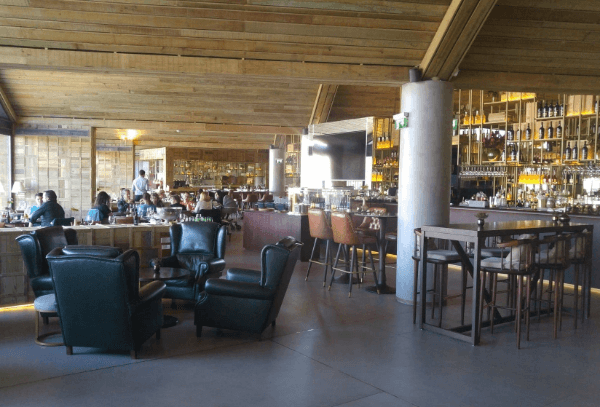
They not only have a great cigar lounge, where you can order small plates of food and drinks, but the restaurant is top notch, especially for the price. The chef makes very creative dishes that are delicious and beautifully-presented.
Parque da Cidade do Porto
The largest urban park in Portugal is located at the western end of Porto. It’s full of small lakes and winding, shady trails, making it the perfect place to exercise, stroll, or picnic.
The park has multiple entrances, one of which connects to the oceanfront path.
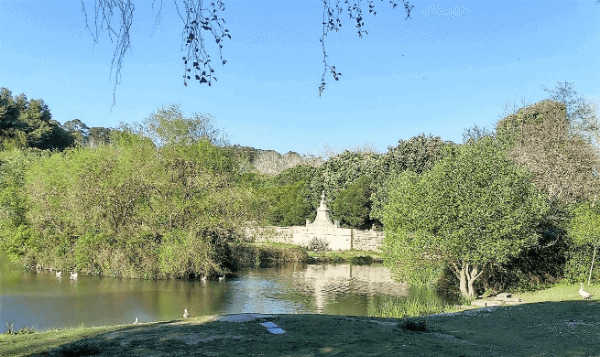
This restaurant was around the corner from our apartment in Foz, and it was one of our favorite restaurants in Portugal. They had an interesting mix of food that was far different from what we saw on most menus, and everything we tried was delicious.
Casa Vasco is definitely a “locals” place and a great find if you’re in the neighborhood.
Douro Valley Wine Tour
A short day trip from Porto is the Douro Valley, Portugal’s famous wine region. There are hundreds of wineries in the Douro Valley , and this stunning region of northern Portugal was declared a UNESCO World Heritage site in 2001.
An organized tour is the best way to see this area so that you can leave the driving to someone else! This one offers a full day experience! Enjoy a tour and tasting of delicious ports, wines, and olive oils. Then take a relaxing cruise on the Douro River followed by lunch overlooking the Valley.
Click here to reserve your spot !
Next Stop: Lisbon and Costa da Caparica
In recent years, Lisbon has become one of the most popular cities in Europe, and with good reason. Picture a much less expensive version of San Francisco, but with more sun! It even has a bridge, Ponte 25 de Abril , that is almost an exact replica of the Golden Gate Bridge.
Besides the resemblance to San Fran, Lisbon boasts all the charm of a major European city: many museums, castles, and historic sites; tons of cafes and restaurants representing cuisines from around the world, and dozens of small neighborhoods, each with its own character and vibe.
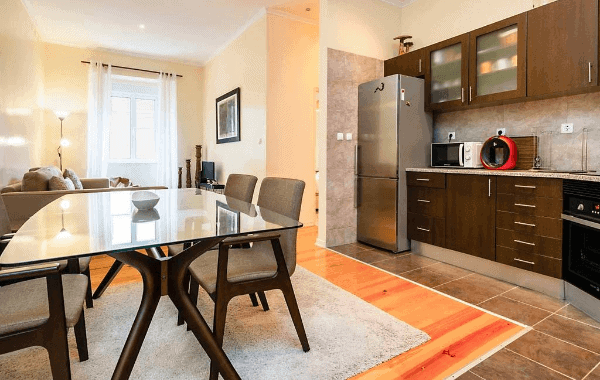
We spent 5 days in Lisbon. We purposely chose an apartment in a residential area outside of the main tourist neighborhoods to get the local feel. Buying groceries at the supermarket, hanging out in a local pastelaria , and doing our morning workout in the nearby park were some of the fun ways we got a window into life in Lisbon.
(Of course, we also did our usual Hop-On, Hop-Off bus tour to see the highlights of the city!)
From there, we were in search of fewer crowds and more beach, so we moved to a little town called Costa da Caparica. We had never heard of it until we spotted it on the map.
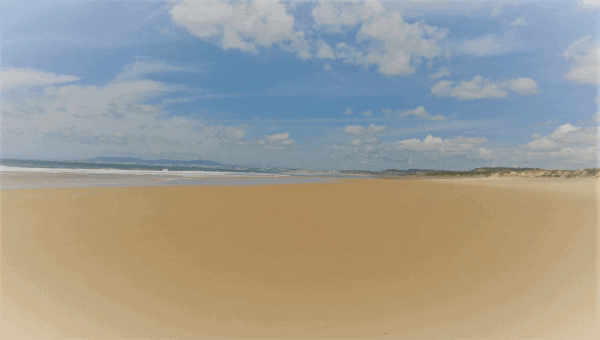
Caparica is across the river from Lisbon and only about a 20-minute ride by car, but it feels like a world away. It’s primarily a surfing town, and the main appeals of Caparica are its waves and its 15-mile stretch of wide, flat, uninterrupted beach.
We loved our little Caparica apartment , which was a block from Costa da Caparica beach and very affordable, so we hunkered down for more than a month!
Day Trips from the Lisbon Area
We took numerous day trips while staying in the Lisbon area, and here are a few I recommend:
This gorgeous resort town is about 30 minutes outside of Lisbon. It has quaint beaches, stunning scenery, and myriad shops and restaurants. The train from downtown Lisbon (€2.25) runs along the coastline with breathtaking views the entire way!
One of the most popular day trips from Lisbon, Sintra is a must-see. It’s most famous for its hilltop castle, the Palácio da Pena (Pena Palace) . A visit to Sintra should include a tour or the castle and gardens and time to have lunch in Sintra’s historic center. Wear good walking shoes!
If you’re based in Lisbon, you can take a full-day tour that includes both Cascais and Sintra. Go2Lisbon offers small group tours that give you free time to explore on your own. Reserve your spot now , and you can cancel or make changes if you need to.
A laid-back town known primarily for surfing, Peniche is about 75 minutes north of Lisbon along the coast. Even if you don’t surf, visit Peniche for the incredible views and fresh seafood.
One site near Peniche that we regret not visiting is the Berlengas Islands, only 10 km off the coast. The São João Baptista Fort on the main island is considered one of the most beautiful in Portugal, and the nature preserve is an excellent place to kayak or snorkel. A tour like this one from Lisbon hits all of the highlights.
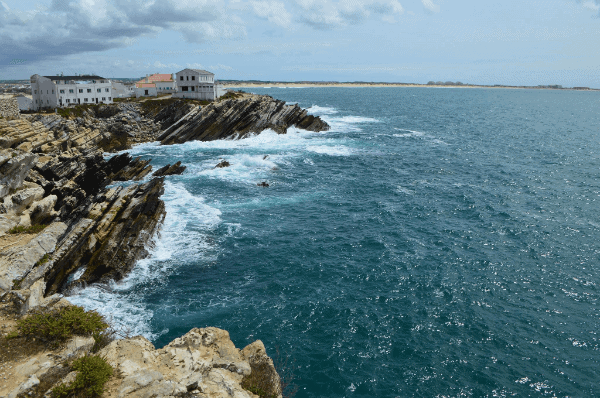
Vinhos Cortém Winery
Our visit to this winery was one of our favorite days in Portugal. We enjoyed an incredible tasting featuring 10 wines paired with delicious cheese, olives, and homemade appetizers.
The tasting was conducted in the winery’s lovely dining room, where we sat for more than 3 hours enjoying stories about the wine and vineyard while chatting with other guests.
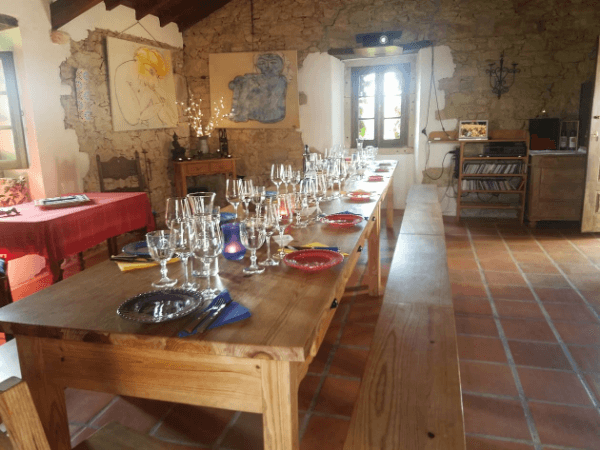
The owners of this small winery – Christopher Price, an Englishman, and his German wife, Helga – made the experience magical, and Helga’s cooking was amazing!
When you visit this winery, use public transportation so that you can indulge in the tastings. Take the bus from Lisbon to Caldas da Rainha (70 min) and take an Uber to Cortém from the bus station.
Ribeira do Cavalo
This secluded beach is in the town of Sesimbre, about 45 minutes south of Lisbon. It requires a 30-minute hike down a rocky cliff to get there, but it’s well worth the effort! Wear good hiking shoes (no flip-flops) and arrive in the morning when there are few other people.
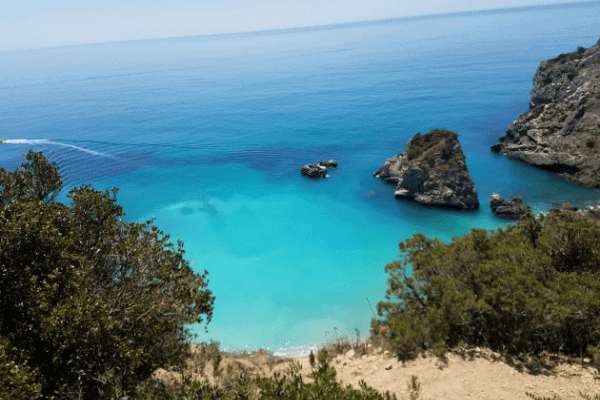
While you can find tours from Lisbon that include a visit to Ribeira do Cavalo, I recommend renting a car and visiting on your own. The beach is quite small, and if you visit with a tour, you will bring the crowds with you.
Afterwards, have lunch at Tasca do Isaías, a locals’ favorite where you choose your meal from the list of freshly-caught fish on their daily menu. They cook it on their outdoor grill, and you eat at the communal tables in their small, bustling restaurant.
Final Stop: Quarteira (Algarve)
We spent our last week in Portugal in Quarteira, a beach town in the famous Algarve region .
| Related Reading: The Best Towns in Algarve
Our apartment was one of our all-time favorites that we’ve rented while traveling, and we spent much of our time relaxing on the terrace, enjoying the incredible view.
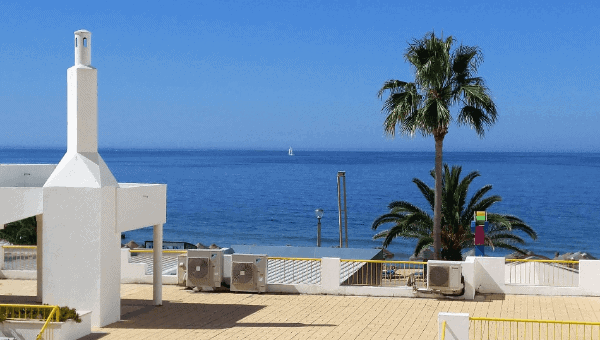
Things to Do in Algarve
Here are a couple highlights from our time in Algarve:
Ponta da Piedade
The dramatic cliffs and caves of Ponta da Piedade, located in the town of Lagos on one of Algarve’s best beaches , are a must-see. Our 75-minute small boat tour of the caves and grottos was one of the highlights of our visit to Algarve.
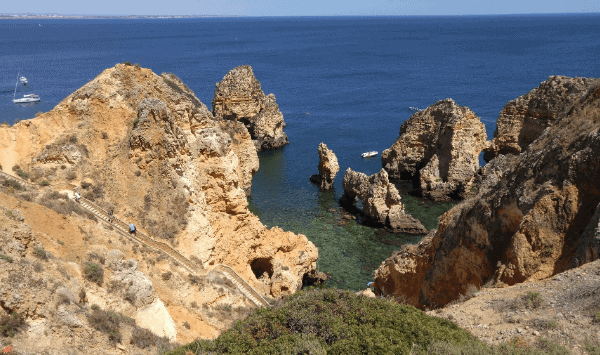
There are dozens of other amazing tours to explore Algarve, whether you want to kayak, snorkel, or search for dolphins. With more time, we would have done several other excursions.
Explore the options , and reserve your spots in advance!
The Cape of St. Vincent
This is the southwestern-most point in Europe and was once thought to be the edge of the world. It’s well worth a visit to see the stunning views and crystal blue water. Bring your camera and a windbreaker!
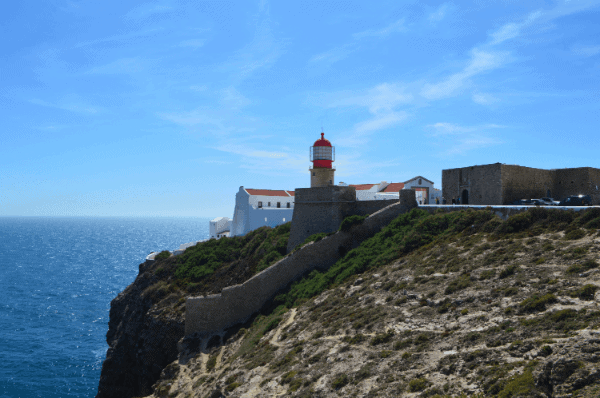
Portugal Travel Tips
Based on our 2+ months in Portugal, here’s what you should know before you go.
Connectivity/WiFi
Free WiFi is everywhere in Portugal. You don’t need to worry about purchasing a SIM card or using your cell phone carrier’s international plan while you’re here. You can communicate using WhatsApp, Skype, or other free apps.
It’s easy, because most restaurants, cafes, and even many stores have their own WiFi network and supply the password to customers. Make sure you use a Virtual Private Network (VPN) to secure your connection and protect your privacy ( we use TunnelBear )!
Money & Banking
You may use cash more often in Portugal than in other Western European countries, especially when you’re outside of Lisbon. Many smaller restaurants and stores don’t accept foreign credit cards.
Plan ahead and withdraw cash from a bank ATM. You can find them in many grocery stores, train stations, shopping centers, and of course, attached to a bank itself.
Avoid Euronet ATMs, which are very prevalent, but charge a high fee. If you must use one of these ATMs, don’t accept their offer to convert your transaction to USD. They will give you a bad exchange rate, and the conversion has no benefit to you.
Restaurants
Many restaurants have one or more appetizers on the table when you sit down. Some have only bread and butter, while others offer more substantial dishes, such as calamari or cod fritters.
Those appetizers are not free, and if you eat anything, you will see the charge on your bill. When you sit down, tell the server to remove whatever you don’t want.
Tipping waitstaff is not customary in Portugal. If you particularly enjoyed the meal or service, leave a few coins, but anything more is unnecessary.
Public Transportation Within Portugal
We traveled by train from Porto to Lisbon and by bus from Lisbon to Algarve. Both modes of transport were clean, efficient, and relatively inexpensive, although prices may vary, depending on how early you book.
The bus is a good option when traveling to smaller cities, because it has many different routes and may drop you closer to your destination.
Use Omio to search both train and bus schedules and to purchase tickets.
Renting a Car in Portugal: Tips and Cautions
Having a rental car in Portugal makes it much easier to explore smaller towns within a region. We rented cars for several days to visit places within the Lisbon area and during our week in Algarve. We paid between $9 and $15/day.
We found cheap car rentals in Portugal by searching at the nearest airport. In contrast to how rental car prices work in the U.S., Portuguese rental cars are typically cheaper near the airport than in city centers.
Warning: rental car companies in Portugal use high-pressure sales techniques to convince you to buy their collision damage waiver (CDW), which often costs more than the daily rental rate. If you have other insurance (ours was through our credit card), decline the CDW, regardless of the fear tactics they use.
Portuguese rental car companies may require written proof of other coverage, and they may still place a very large hold on your credit card. Both times we rented a car, the companies removed the hold even before we returned the vehicle.
If you decline the CDW, do a very thorough inspection of the vehicle and take pictures of any damage before you sign off on the contract.
Finally, Portugal has an electronic toll system throughout the country. In some toll locations, there is no option to pay manually with cash/card; you simply drive under the toll and it records your license plate. Trying to pay the tolls after you’ve incurred them can be inconvenient and costly; rental car companies may charge steep administrative fees.
When picking up your rental car, you can choose to rent a “Via Verde” transponder to pay toll charges automatically. This is definitely a convenient device to have while driving in Portugal, but it shouldn’t cost more than a couple Euro per day. Click here to learn more about Portugal’s toll system.
Language and Communication
You can easily get by in Portugal without speaking Portuguese. Most people speak English very well, and in our experience, were extraordinarily friendly and helpful. Menus are usually available in English, and you will find a lot of American movies and programs on TV in their original versions (with Portuguese subtitles).
Get a Free Stopover in Porto or Lisbon
The best way to fly to Portugal is on TAP Air Portugal. TAP is Portugal’s national airline, and in our experience, they offer great service (including a substantial snack, even in Economy) with very competitive prices.
Of course, I highly recommend that you devote an entire vacation to visiting Portugal. But if you’re headed elsewhere in Europe, you can still spend up to 5 days in this incredible country at no extra charge using TAP’s stopover program .
Once you’ve had a small taste of Portugal, I promise you will want to return for a longer visit!
Ready to Go to Portugal?
After staying more than 2 months, we still didn’t see everything that Portugal has to offer, and we will definitely be back! There are many vineyards, mountains, fishing villages, and beaches yet to be explored.
No matter what you seek in a destination, Portugal has something for you at a great price. Don’t forget to write and tell us about your adventure!

Good article? Share it!
12 thoughts on “Visiting Portugal: Itinerary for “Slow Travel””
I always enjoy reading about your adventures and travel tips! Yes Portugal is a great country to visit~ but one must try the Azores as well.
Yes! We haven’t made it to the Azores yet. It’s not so easy to fly Space-A anymore, but I’m sure it’s worth a commercial ticket!
Hi Stephanie! I always look forward to your newsletters, but especially enjoyed this one on Portugal. We hope to do that trip soon, so I am keeping this article for sure. Thanks again!
Thanks for reading!
Great post Stephanie. What fun the wine tasting must have been. Looking forward to experiencing Portugal one day too.
Thanks, Mariah! Writing that post was fun, because we got to re-live everything, and yes, we can’t wait to go back to that winery!
I just retired as an Air Force officer at Joint Base Elmendorf-Richardson in Alaska May of this year. Ran into your husband Mike at the PX today and he recommended your site. In 2 minutes with Mike I learned 3 new facts about traveling as a retiree that are life changing. I plan to never work again and just travel. Our stuff is in long term storage, all debt is paid off and I am free! This site is a Godsend! Thank you so much for sharing your leg work! Our first space A trip will definitely be Spain ( then Portugal) based on the opulant picture of awesome travel that Mike gave us! God bless you both and see you on the ‘by and by’ !
Congrats on your retirement and your freedom! Glad you met my husband, and I hope to see you on a Space-A flight sometime soon!
I am so glad you wrote such a detailed post with Links. We are taking a transatlantic cruise from FL to Spain next March. We are retired and want to spend some time in Portugal. We could spend a month or 2 there.
I appreciate you taking great notes for us!
I have bookmarked this page!
Thanks! Clare
Sounds like a wonderful adventure! Please report back and tell us about your trip!
Heading to Lisbon in 2 days to spend 5 weeks there taking language classes and scouting Portugal out as a place to spend more time. Have made notes of your recommendations for the winery and the warning about the EuroNet ATMs… thanks!
That sounds like fun! Good luck with Portuguese! I found it very easy to read with a background in French and Spanish, but I couldn’t understood a word they said 🙂
Comments are closed.

Solo Travel In Lisbon: The Ultimate Guide (With Map!)
By Linn Haglund. This guide to traveling alone in Lisbon contains affiliate links to trusted partners!
Are you interested in learning about solo travel in Lisbon, Portugal ? Want to have a safe and fun trip exploring on your own?
Then you’re in the right place!
Portugal’s capital city is full of charm with its cobbled streets, tiled buildings, and coastal location. And with plenty of hotels, attractions, and events to choose from, you’ll never get bored in Lisbon as a solo traveler.
Personally, I’ve traveled solo to Lisbon numerous times, falling in love with this safe and exciting city more and more with each trip.
If you love exploring local culture, Lisbon showcases art and tradition at every turn, from its traditional tilework covering building facades to the soulful Fado music spilling out the doors of venues and restaurants into the late evenings.
Speaking of restaurants, solo travelers will also fall in love with delicious local dishes like ameijoas a bulhao pato (clams with sauce) and cozida a Portuguesa (mixed meat stew).
But, this is just the beginning of what makes Lisbon such an incredible solo travel city. Luckily, the following Lisbon solo travel guide will cover everything you need to know about how to have a safe and fun trip exploring this beguiling city on your own!
⏳ Short on time? Here are some top recommendations for your Lisbon solo itinerary: ✈️ Lisbon Airport Transfer: Book that here ☔ Safety: While Lisbon is safe for solo travel, it’s still smart to pack travel safety essentials . One top pick is the She’s Birdie Personal Safety Alarm , which is TSA-approved and can help scare away potential attackers. Other recommendations include Clever Travel Companion Pickpocket-Proof Garments and Speakeasy Travel Supply Hidden Pocket Scarves . 🏨 Accommodation: Goodmorning Solo Traveller Hostel & Lisboa Central Hostel . You can also view accommodation on this map to view local Lisbon hotels, hostels, and vacation rentals. 🚅 Public Transportation: Omio 💸 Save Money: Lisbon Card gets you free and discounted admission to attractions + free access to public transportation 🗺️ Experiences: Viator (tours), GetYourGuide (tours), and EatWith (cooking classes & dining in local homes) 📍 Recommended Excursions: ✨ Private City Tour: Highlights of Lisbon ⛵ Lisbon Sunset Sailing Tour with Wine & Snacks 🥘 Lisbon Cultural Food & Wine Walking Tour 🎉 Events: Fever 🏥 Travel Insurance: SafetyWing 📞 Staying Connected: Airalo eSIM
Table of Contents
Travel Solo In Lisbon With Confidence [Free Course]
But first, before we get into our solo travel Lisbon guide , I invite you to grab a seat in Jessie’s free Savvy Solo Traveler E-Course .
The 6-day course is designed to help you feel confident about booking your first solo trip and exploring the world alone.
Lessons include:
- Common solo travel fears and how to overcome them
- How to choose your perfect solo trip
- How to tell loved ones you’re hitting the road solo
- Mentally preparing for your solo journey without losing your mind
- Essential steps for staying safe on a solo trip
- How to take amazing solo selfies
Once you’ve grabbed your seat , read on to learn everything you need to know to travel alone in Lisbon and have an amazing time.

Solo Travel In Lisbon: Is It Worth It?
You might wonder if solo travel to Lisbon is worth it or not. The truth is, this is one of the best European cities to explore on your own .
It is a safe city with fun hostels offering group activities, plenty of culture, and attractions to explore on your own if you prefer some “me-time”.
Plus, whether you visit Lisbon in winter or in the summer months, temperatures are mild, there are plenty of things to do, and each season has its own allure.
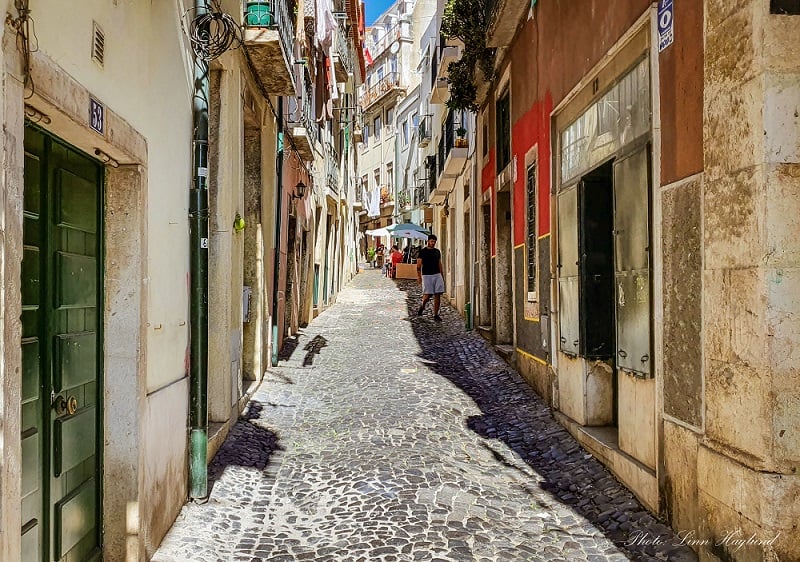
Where Is Lisbon?
Lisbon is located in central Portugal in western Europe , with the Tagus River running peacefully below the city’s hills.
In terms of nearby destinations, Lisbon is about three hours north of the Algarve and three hours south of Porto , making it a popular base for day trips around the country.
Getting To Lisbon
Flying into lisbon.
Lisbon Airport (Humberto Delgado Airport) is Portugal’s main international airport, making it a natural arrival point for a solo trip to Portugal . Further, Tap Portugal uses Lisbon as a base, so most flights to other destinations have a layover in the city.
Getting from Lisbon Airport to the city center is easy by metro. The metro line Aeroporto-Saldanha takes you directly into the city center in only 20 minutes.
Getting to Lisbon by train or bus
Additionally, Lisbon is well-connected by train and bus from all across the country and neighboring Spain. The main train station is Gare do Oriente Station and the main bus terminal is called Sete Rios Bus Station .
You can use a platform like Omio to plan your train and bus journeys.
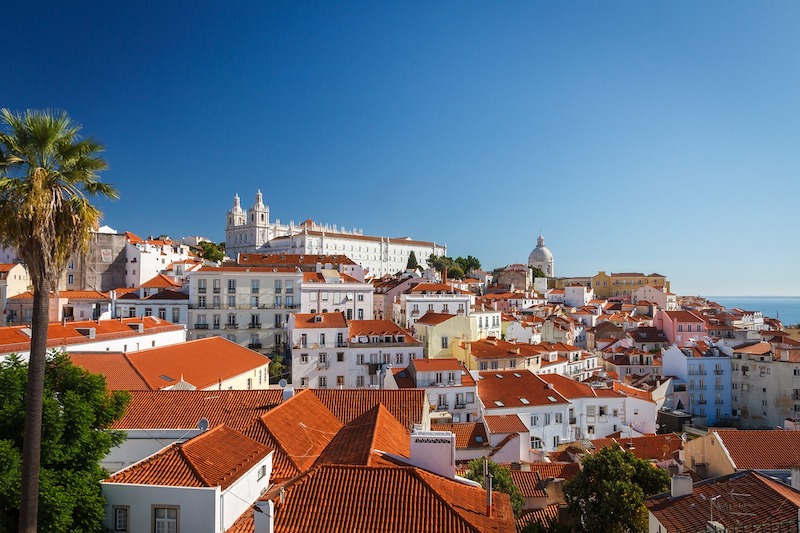
Getting to Lisbon by car
If you travel by car and visit Lisbon on a road trip , it is easy to reach the city; but note that there are several toll roads in Portugal, and once you get closer to Lisbon there are multiple.
Some only take cash or don’t accept foreign cards, so make sure you have about 100 Euros in cash in the car for both pay roads and parking in the city.
Parking in Lisbon is a little bit complicated, especially if you park in the city center. This is because you must pay cash to park along the road, and can only park for four hours maximum at a time.
Your best bet is to find a hotel with free parking or leave your car in a parking garage or public parking lot. You can use a platform like Parclick to find public parking lots.
Renting a car in Lisbon
Need to rent a car for your solo Lisbon trip? Check out Discover Cars to quickly compare your rental options.
Getting Around Lisbon As A Solo Traveler
Lisbon is easy to get around, and you’ll find plenty of options for seeing the many interesting and beautiful places around the city.
The best way to get around the popular destination of Lisbon as a solo traveler is by foot or taking the iconic yellow trams. While the city is walkable, there are a lot of steep hills which might feel quite daunting if you are not used to it.
Tram no. 28 runs through the Alfama, Baixa, Estrela, and Graca districts while the Tram no. 15 goes to Belém.
Note that while Belém has numerous Lisbon attractions, it is not easily reached on foot. Because of this, I recommend taking the tram to help you maximize time on your Lisbon solo travel itinerary.
Tram tickets cost 3 Euros for a single journey and are free with the Lisbon Card .
Getting home at night in Lisbon alone is usually safe, but I would recommend taking a taxi for anything more than a 10-minute walk, especially if you must pass any dark alleys or you have been drinking.
Taxis in Lisbon have meters; however, sometimes they don’t turn them on so they can charge you extra. Make sure the driver turns it on and if they don’t, agree on a price upfront or get a different taxi if you think the price is too high.
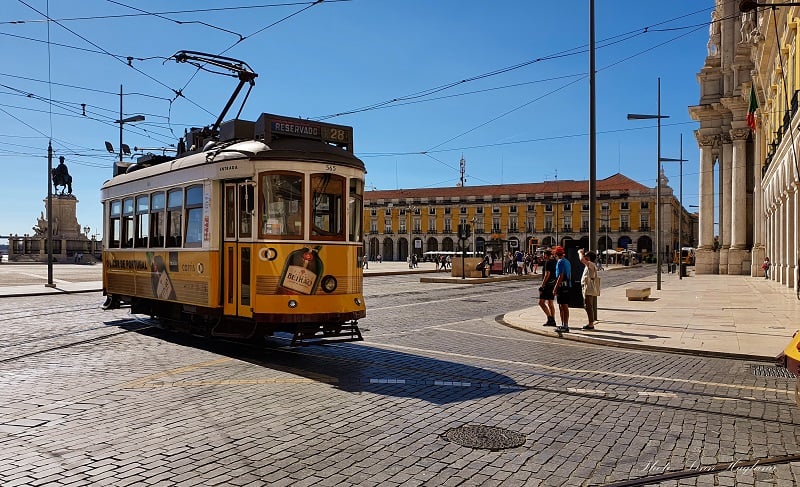
Is Lisbon Safe For Solo Female Travelers?
If you’ve ever wondered “Is Lisbon safe to travel alone?” you’ll be happy to know the answer is yes!
According to Travel Safe-Abroad , the chances of being the victim of a violent crime are low. Additionally, the city is safe for women traveling alone – though you should still keep normal solo travel safety tips in mind.
It’s also important to remember that pickpocketing does occur somewhat regularly. To avoid thieves, swap your open purse for a crossbody bag that sits in front of you or even pickpocket-proof clothing or a money belt .
Finally, avoid walking alone at night, particularly in areas where there aren’t other people. I’ve walked around Lisbon solo at night multiple times and never felt threatened or uncomfortable, but it’s better safe than sorry.

Best Places To Stay In Lisbon For Solo Travelers
When considering where to stay in Lisbon as a solo traveler, there are a few neighborhoods that are centrally located. Both Baixa and Alfama are some of the best areas for walking around the historical center and visiting the city’s attractions.
There, you will find the São Jorge Castle overlooking the city, Lisbon Cathedral, the Carmo Convent, and the Santa Justa Elevator among other sites.
If you want to stay near the evening action, Bairro Alto offers a vibrant nightlife scene with plenty of restaurants, bars, and clubs. It is also within walking distance of tourist attractions like the Miradouro São Pedro de Alcântara viewpoint and Igreja de São Roque church.
Here are my favorite hostels to stay for solo travelers in Lisbon. They are both centrally-located and walkable to numerous tourist attractions in Lisbon:
Goodmorning Solo Traveller Hostel
View this post on Instagram A post shared by Goodmorning Solo Traveller Hostel (@goodmorninghostel)
This is a good place to stay for anyone traveling solo to Lisbon with a communal room where you can get to know other travelers or watch movies. Walking tours and pub crawls are organized too, so you can go out in a safe environment with fun company. Your stay includes free breakfast, and rooms are a mix of dorm sizes, including female-only dorms.
Lisboa Central Hostel
View this post on Instagram A post shared by Lisboa Central Hostel (@lisboacentralhostel)
This is another one of the best hostels in Lisbon for solo travelers and it features both shared and private rooms. It is nice and spacious with a great common area and kitchen – not to mention complimentary breakfast and free milkshakes on Milkshake Mondays. The staff is helpful and they organize different activities so you can easily make new friends if you feel like being social.
Find Lisbon accommodation
Want to research other solo travel-friendly hostels, hotels, and vacation rentals in Lisbon? You can view accommodation on this map .
It’s currently set to Lisbon’s Baixa district, but you can easily change this to your preferred area to find the best hotels in Lisbon for solo travelers:
Top Things To Do Alone In Lisbon
Now that we’ve discussed the logistics of traveling solo in Lisbon, let’s go over what to actually do. There are endless things to do on a solo trip to Lisbon, and you can easily spend weeks there without getting bored. Here are some of the main highlights to add to your itinerary:
1) Visit Castelo de São Jorge

Atop one of Lisbon’s seven hills, you will see the majestic Castelo de São Jorge (Saint George’s Castle) looming above this amazing city.
This UNESCO World Heritage site is one of the most prominent landmarks in Lisbon and has been protecting the city since the 10th century; however, it was destroyed in both the 1531 and the 1755 earthquakes that hit Lisbon, so most of what you see today is restoration work after these devastating disasters.
You can get tickets at the entrance or book online . A visit encompasses the gardens with sweeping views of Lisbon and the Tagus River, the museum, and the castle where you can walk on top of its ramparts taking in more views.
2) Explore history at Jerónimos Monastery
Jerónimos Monastery is a UNESCO World Heritage site that should absolutely be on your Lisbon solo female travel itinerary.
The monastery was built in the early 15th century on the same site where Henry the Navigator founded an old hermitage. This was also the same place Vasco de Gama and his men spent their last night praying before venturing out on the open sea to India.
The monastery is a symbol of the wealth Portugal saw during the Age of Discovery with its impressive architectural details, courtyards, magnificent cloisters, and beautiful chapels. You’ll see a nautical theme all over the building with sculptures and details of sea monsters, coils of rope, and corals decorating the columns and ceilings.
3) Climb Belém Tower

About a 20-minute walk or a quick ride on Tram 15 from Jerónimos Monastery is Belém Tower , another UNESCO World Heritage site in Lisbon and perhaps the most important token of Portugal’s Age of Discovery.
Located on the riverfront, the tower was built at the beginning of the 16th century as a protective fort on a strategic point of the Tagus River defending the city against pirates. It was also the point where sailors set out on their discovery journeys. Later, it has also been used as a lighthouse and a prison.
A visit to the Belém Tower gives you a peek into the architecture, the pits where they held prisoners, and the canons; however, the highlight is climbing the stairs up to the top for amazing views over the city and waterfront.
I recommend visiting both Belém Tower and Jerónimos Monastery on the same day, as they are pretty close to one another. Along with exploring these sites, make sure to go for a walk in the Praça do Império Garden along the riverfront, see the 170-foot tall Monument of Discoveries , and try some of the famous Portuguese custard tarts, Pastel de Belém , while you are in the neighborhood.
💡 Pro tip: One of the best ways to visit these sites is on a Belém and Jerónimos Monastery Guided Small-Group Walking Tour , which also includes a stop at Pastéis de Belém, a Portuguese pastry shop that’s more than 100 years old!
4) Take the Santa Justa Lift
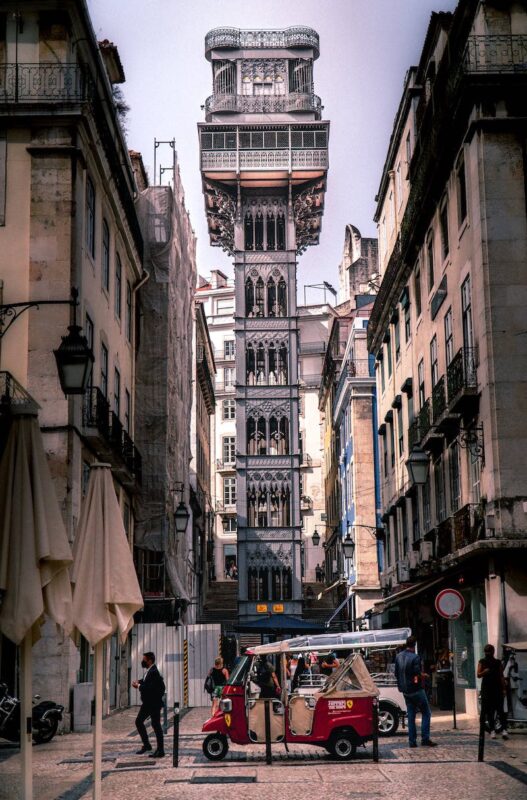
The Santa Justa Lift was built by Raul Mesnier du Ponsard, who was the apprentice of Gustav Eiffel of Eiffel Tower fame. This is why it appears so similar to the famous Paris landmark.
The detailed wrought-iron lift was originally run by steam but was changed to use an electric motor a few years later.
The lift is still in operation and takes you up 45 meters from the lower district of Baixa to the higher Carmo Square . It is a great way to reach a higher level without walking, but is also a unique experience in itself.
Note that during peak season in Lisbon, there is usually a very long line to take the lift, so the best time to go is early morning. Opening hours are every day from 7 AM to 10:45 PM.
On Carmo Square, you can visit the Carmo Convent which was completely destroyed in the 1755 earthquake, leaving only its empty shell. It is tremendously beautiful with its large arches but also showcases the devastating reality of what the earthquake left behind.
Now it houses an archaeological museum where you can see, among other things, an Egyptian mummy, the tomb of King Ferdinand I, and the tomb of Queen Maria Anna of Austria, who was queen in Portugal in the mid-18th century.
5) Explore Praça do Comércio
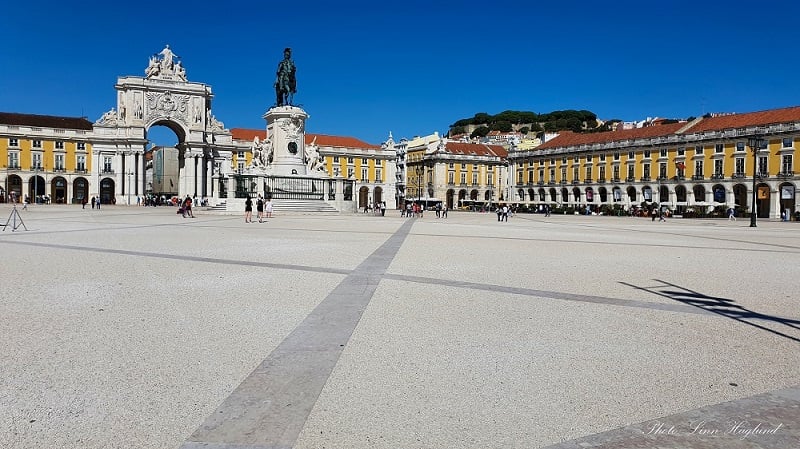
Located on the harbor, Praça do Comércio is one of Portugal’s largest squares and is lined with yellow Pombaline-style buildings on three sides and Lisbon’s harbor on the fourth.
The square was built after the 1755 earthquake destroyed the country’s most important palace, the Paço da Ribeira, which stood in this exact place.
Lisbon’s Praça do Comércio has been a place for receiving goods from the ships docking outside it and has always been a center of activity in the city. It is also where the beginning of the fall of the Portuguese Monarchy took place when the last King, Carlos I, and his son Luis Filipe were executed on the square.
These days, it is a bit more peaceful on Praça do Comércio, with tourists snapping pictures of the equine statue of King Joseph I and people eating and drinking in the restaurants surrounding the square.
💡 Pro tip: Many tours also visit the Praça do Comércio, like the Best of Lisbon Guided Walking Tour and the Old Alfama & Baixa Chiado Quarters Walking Tour .
6) Book a Lisbon food tour or cooking class
One highlight of a solo trip to Lisbon is the food. Portuguese food is renowned for its rich and diverse flavors, characterized by fresh seafood, hearty stews, and a variety of traditional pastries like pastéis de nata (Portuguese custard tarts).
The cuisine is celebrated for its use of high-quality ingredients, Mediterranean influences, and a perfect balance of sweet and savory, making it a delicious culinary experience that reflects Portugal’s rich history and culture.
One way to explore the local culinary culture is through a Lisbon food tour . A few top-rated options for this include:
- 🍷 Lisbon Small-Group Portuguese Food & Wine Tour
- 🦐 The Award-Winning Private Food Tour of Lisbon: 6 or 10 Tastings
- 🥘 Lisbon Cultural Food & Wine Walking Tour
➡️ Click here for a full list of food tours in Lisbon !
If you’d prefer to learn how to make the food yourself, you can also opt for a cooking class like:
- 🥐 Portuguese Pastry Workshop in Lisbon
- 🍛 Hands-On Portuguese Cooking Class in Lisbon
- 🥑 Market and Food Tour with Cooking Class
➡️ Click here for a full list of cooking classes in Lisbon !
7) Eat in a local home

If you’d like to really immerse yourself in Lisbon’s culinary culture while meeting locals, EatWith is a platform where you can book dining experiences with locals in their homes.
If you’re nervous about being lonely while traveling solo , these shared meals are a great way to socialize over some delicious food.
Along with dinners in local homes, EatWith also lets you book food tours and cooking classes led by locals.
8) Step into Lisbon Cathedral (Sé de Lisboa)
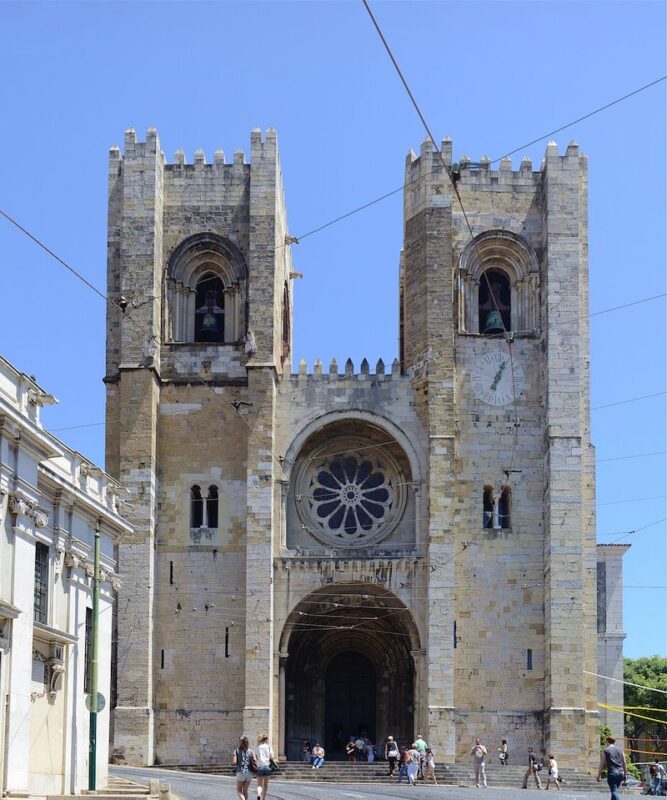
As you can see, there are many amazing things to do in Lisbon for solo travelers. And when it comes to local attractions, Sé de Lisboa (Lisbon Cathedral) is a must-visit.
Located in the Alfama district, the Tram 28 passes straight in front of it so it is hard to miss. The 12th-century Gothic basilica is the oldest in Lisbon, and beyond its grand facade, the interior hides beautiful treasures.
Inside, take note of the choir, the altarpiece, and the stained glass rose window. There is also a balcony where you can enjoy epic city views.
Besides, the tombs of King Alfonso IV and João Anes, the first archbishop of Lisbon, are inside as well as the relics of the martyr St. Vincent.
9) Visit the National Tile Museum
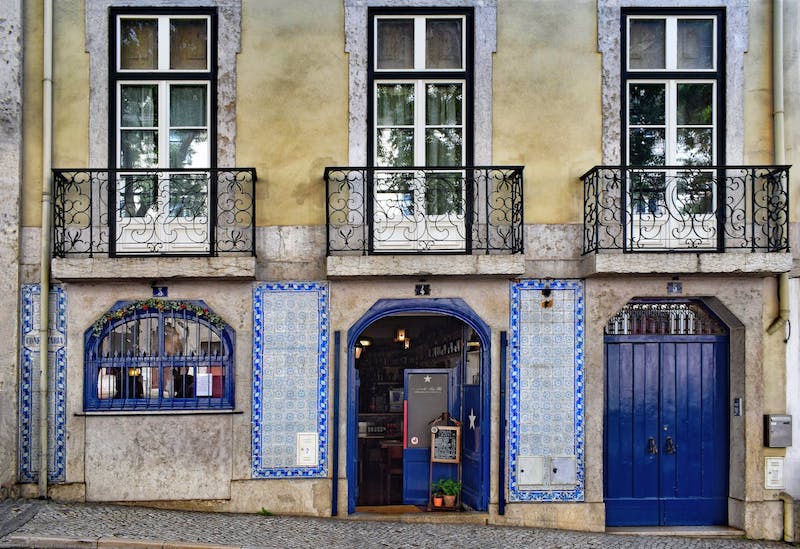
One of the most traditional art forms in Portugal is the mastering of the azulejos , the beautifully decorated tiles that adorn house facades as well as church and courtyard interiors around Portugal.
The National Tile Museum (Museu Nacional do Azulejo) in Lisbon is a wonderful place to learn more about the history of the Portuguese tiles.
It is set in an early 16th-century convent and displays a vast collection of tilework from the 15th century to the present day.
10) Search for the best Lisbon viewpoints
No Lisbon solo trip would be complete without taking in some absolutely stunning views. Lisbon is built on seven hills, so you can only imagine how many splendid viewpoints you will find throughout the city.
One of the most popular viewpoints is Miradouro de Santa Luzia in the Alfama district, recognized for its white and blue tiles and overhanging plants. It offers stunning views of Lisbon’s rooftops, the National Pantheon, and the Tagus River.
A short walk from there, you get another iconic view of Alfama’s terracotta rooftops from Miradouro das Portas do Sol .
Additionally, Miradouro de São Pedro de Alcântara is located in Bairro Alto and offers sweeping views of Alfama and Lisbon’s iconic hilltop castle with the Tagus River as a backdrop.
For a different view, you can climb the Arco da Rua Augusta at Praca da Commercio where you will get a bird’s eye view of the giant square, Rua da Augusta, and beyond. There is a small fee to go to the top, but it is totally worth it.
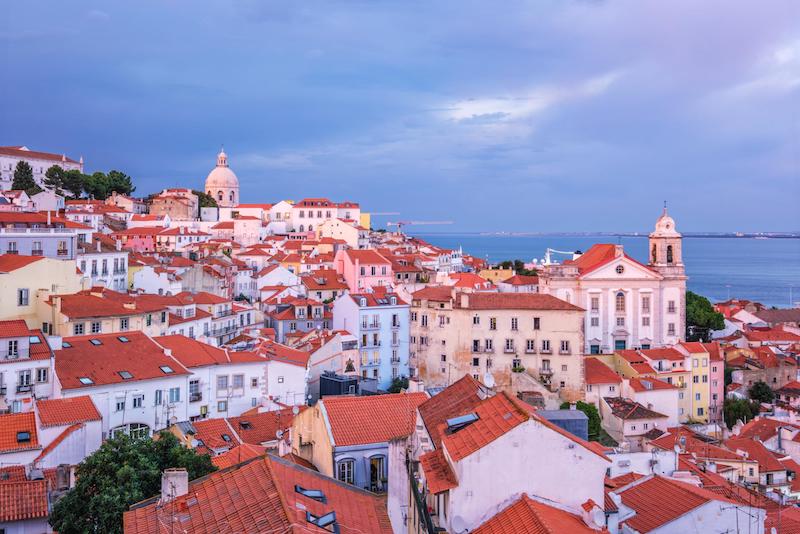
Top-Rated Tours For Solo Travelers In Lisbon
One of the best ways to gain a deeper understanding of the places you visit while making new friends during solo travel in Lisbon is to book a guided tour. A few top-rated tours in Lisbon include:
- 🛺 Half-Day Lisbon Sightseeing Tour on a Private Electric Tuk-Tuk
- ⛵ Lisbon Sunset Sailing Tour with White or Rosé Wine and Snacks
- 😍 Sintra and Cascais Small-Group Day Trip from Lisbon
- ✨ Private City Tour: Highlights of Lisbon
➡️ Click here for a full list of Lisbon tours .

Tips For Solo Dining In Lisbon
Solo dining in Lisbon is widely accepted and I have never experienced being denied eating anywhere when going alone or felt awkward due to the treatment of the restaurant workers.
Actually, many restaurants have small tables for one or two people, making it easy to seat those dining alone.
If you feel uncomfortable, go early for dinner at about 7-8 PM when the restaurants still are not full. This way, you have the option to chat with the waiters who usually have more time on hand, or read a book while waiting for the food.

A great place to go if you are not comfortable dining alone is the Time Out Market Lisbon . Here you can get food from different stalls featuring some of the best restaurants in Lisbon. It’s a popular place for solo diners looking for a delicious meal.
Finally, one of the best ways to try a variety of different Portuguese foods is to join a Lisbon food tour , which is also great for meeting locals and other travelers. Click here for a full list of food tours in Lisbon .
Lisbon Bars For Solo Travelers
Traveling to Lisbon alone shouldn’t mean you have to stay in when the sun goes down. There are a number of districts in Lisbon known for their evening offers, each with its own vibe. Some of my favorites include:
Bairro Alto. This is the best place for nightlife with plenty of bars, clubs, and restaurants. If you enjoy a good cocktail, one of the best bars for solo travelers in Lisbon is Cinco Lounge , a trendy spot with a vast drink menu. You can even sign up for a cocktail course if you fancy meeting people with similar interests.
Chiado . Head here if you are looking for more chilled-out after-work bars. For a casual and local dining experience, Taberna da Rua das Flores is intimate enough that it is easy to chat with people at other tables, and the staff is also very friendly.
View this post on Instagram A post shared by A Taberna da Rua das Flores (@tabernadasflores)
Marvila. Known as Lisbon’s Beer District, Marvila is the perfect place for beer drinkers. And if you enjoy craft beer in particular, definitely visit Fábrica da Musa which offers everything from IPAs to pilsners to blonde ales and beyond.
Alfama. Here you’ll find some of the best places to enjoy soulful Portuguese folk music or fado. My top pick for this is Fama d’Alfama as they easily accommodate anyone dining solo and it is entertaining watching the Fado show even if you are not used to dining alone.
💡 Pro tip: There are many ways to meet others to enjoy local Lisbon nightlife, such as joining pub crawls through your hostel or finding meetups through platforms like CouchSurfing and Meetup.com. Additionally, you can check Fever to find fun local events, concerts, and pop-ups.
Fun Day Trips From Lisbon For Solo Travelers
There are plenty of day trips you can take from Lisbon to nearby towns and cities, like:
The most popular day trip from Lisbon is the fairytale town of Sintra where you can visit the famous Palacio da Pena (Pena Palace).
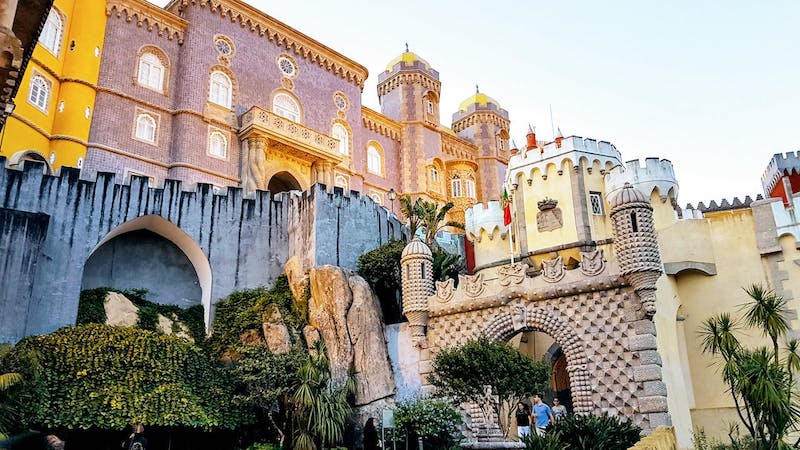
There are also plenty of other fairytale castles in Sintra like Quinta da Regaleira and the Moorish Castle with its walls reminiscent of a miniature Great Wall of China.
It is easy to visit Sintra by train and bus, or by booking a tour to Sintra from Lisbon .
Not far from Sintra, you find another charming town, Cascais. This is a coastal resort town with splendid beaches, palaces, and a lighthouse that is well worth a day trip.
A short walk from the town itself, you can admire the natural blowhole Boca do Inferno combined with a relaxing coastal walk.
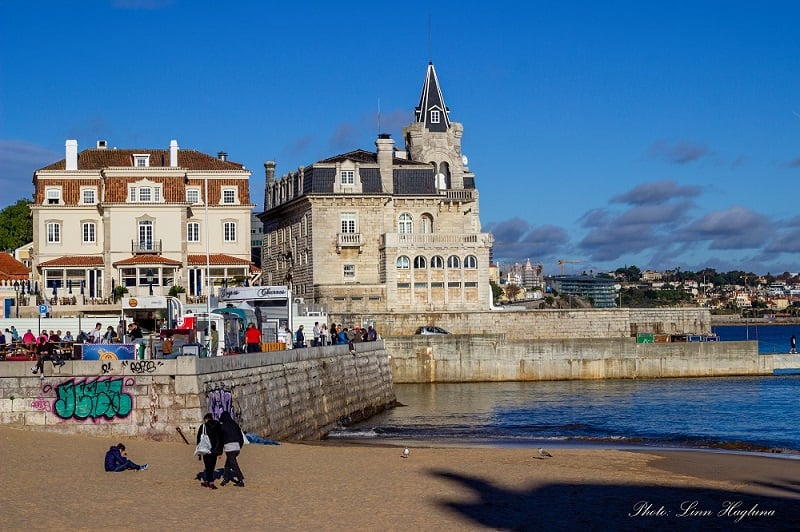
It is easy to reach Cascais by train or bus, or by booking a tour to Cascais from Lisbon .
Ericeira is home to Europe’s only World Surfing Reserve and is one of the most quaint little beach towns in Portugal near Lisbon.
Besides surfing, it has a lovely old town with traditional white and blue painted houses, interesting rock art along the coastal walk lining the town, and great beaches for swimming.
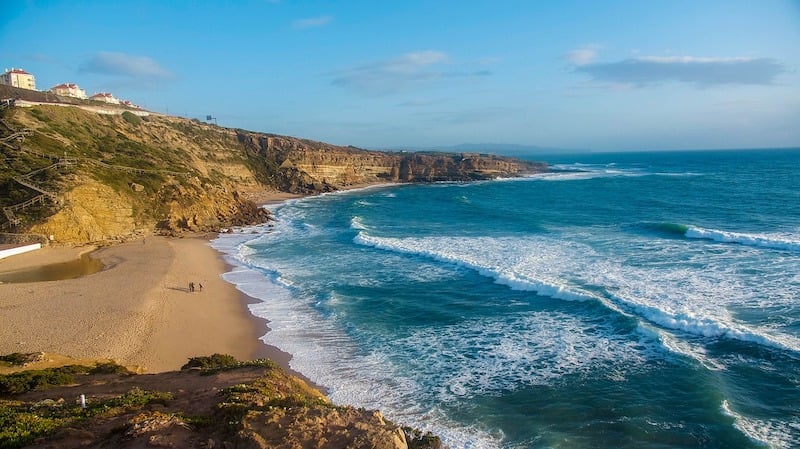
To reach Ericeira you can take a bus from the Campo Grande bus terminal in Lisbon to Ericeira’s Terminal Rodoviário. Alternatively, you can book a private transfer or book a tour to Ericeira from Lisbon .
In Mafra, you can visit the opulent National Palace of Mafra (Palácio Nacional de Mafra) which is 220 meters long and boasts 1200 rooms.
The palace has an integrated basilica and is listed as a UNESCO World Heritage Site. The town itself is small with a few restaurants and bars for lunch.
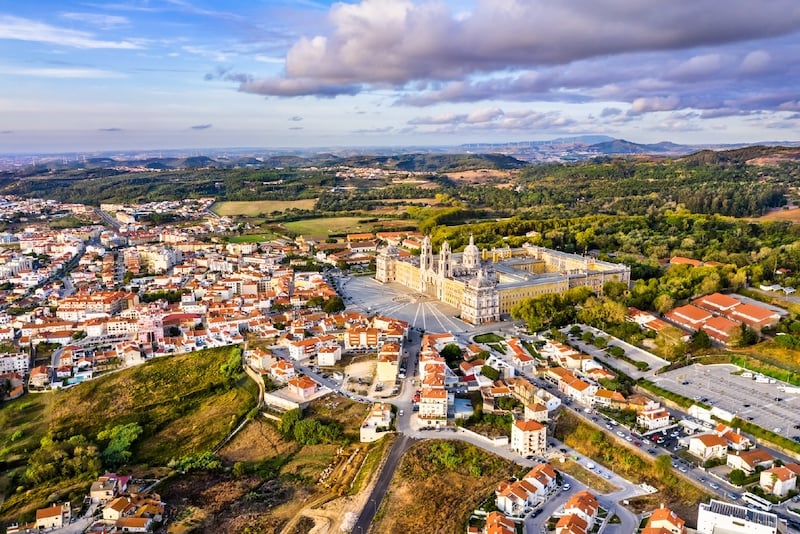
To get to Mafra from Lisbon, take a bus from Campo Grande bus terminal to Av Forças Armadas 8. You can also book a private transfer or book a tour to Mafra from Lisbon .
Lisbon Travel Map
To help give you a lay of the land, here is a solo travel in Lisbon map. It has all of the places mentioned in this guide pre-plotted:
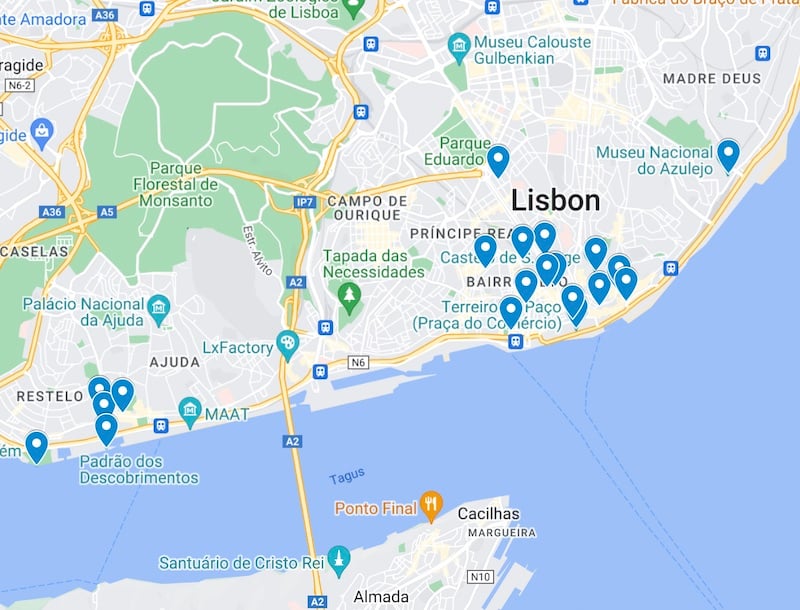
Click here for the interactive version of this map .
Do You Need Travel Insurance For Lisbon?
When visiting Lisbon solo, it’s wise to get travel insurance.
One of the best travel medical insurance for travelers is SafetyWing as they’ve got a large network and offer both short-term and long-term coverage — including coverage if you’re traveling for months as well as limited coverage in your home country.
Additionally, SafetyWing is budget-friendly and offers $250,000 worth of coverage with just one low overall deductible of $250.
Click here to price out travel insurance for your trip in just a few clicks .

Solo Travel In Lisbon FAQ
Now that we’ve gone over some important things to know when it comes to Lisbon Portugal solo travel, it’s time to answer some frequently asked questions:
Q) Is Lisbon good for solo travel?
Lisbon is great for solo travelers thanks to its welcoming atmosphere, vibrant street life, and a mix of historic charm and modern amenities, providing a safe and enjoyable environment for those exploring the city on their own.
Q) Is Lisbon safe for solo travel?
Yes, Lisbon is safe to travel alone, and your risk of being the victim of a violent crime is low.

Q) How do I meet solo travelers in Lisbon?
A few ways to make friends when traveling solo in Lisbon include booking small-group walking tours, staying at hostels, and making use of platforms like CouchSuring, Meetup.com, and local Facebook groups that help facilitate meeting locals and other travelers.
Q) When is the best time to visit Lisbon?
The best time to travel to Lisbon is the shoulder season, which includes March to May or September to October. During this time, you can enjoy wonderful weather without the crowds and high prices of summer.
Q) Is Lisbon friendly to foreigners?
Yes, locals in Lisbon are generally friendly to foreigners and are known for their warm hospitality and willingness to help visitors, creating a welcoming atmosphere for those exploring the city.
Q) Is Lisbon friendly to American tourists?
Yes, Lisbon is generally friendly to American tourists, as English is widely spoken, and locals are accustomed to welcoming visitors from diverse backgrounds.

Final Thoughts On Lisbon Solo Travel
Summing up this Lisbon solo travel guide, there are plenty of reasons to visit Lisbon alone.
Not only is it safe, but there are many places and opportunities to connect with other solo travelers. Additionally, there are loads of activities and attractions, not to mention the food is delectable – even for vegans.
If you enjoy a good nightclub, Lisbon will not disappoint, but if you prefer a quiet night out with wine and an authentic fado performance, you will find that too.
No matter what your travel style, I hope you enjoy traveling Lisbon solo just as much as I do!
What tips would you add to this guide to solo travel in Lisbon, Portugal?
About The Author
Linn Haglund is a multicultural full-time traveler, blogger, vlogger, and freelance writer focused on travel and the outdoors. Her passion for sustainable travel led her to help others travel more responsibly with her blog Brainy Backpackers . You can also follow her journey on YouTube , Facebook , or Instagram .
Related posts:

Hi, I’m Jessie on a journey!
I'm a conscious solo traveler on a mission to take you beyond the guidebook to inspire you to live your best life through travel. Come join me!
Want to live your best life through travel?
Subscribe for FREE access to my library of fun blogging worksheets and learn how to get paid to travel more!

Turn Your Travel Blog Into A Profitable Business
Subscribe to my email list to snag instant access to my library of workbooks, checklists, tutorials and other resources to help you earn more money -- and have more fun -- blogging. Oh, and it's totally FREE! :) // Privacy Policy .
Check your inbox for your welcome email + resource library password!
Leave a Comment Cancel Reply
Nomadic Matt's Travel Site
Travel Better, Cheaper, Longer
Lisbon Travel Guide
Last Updated: September 1, 2023
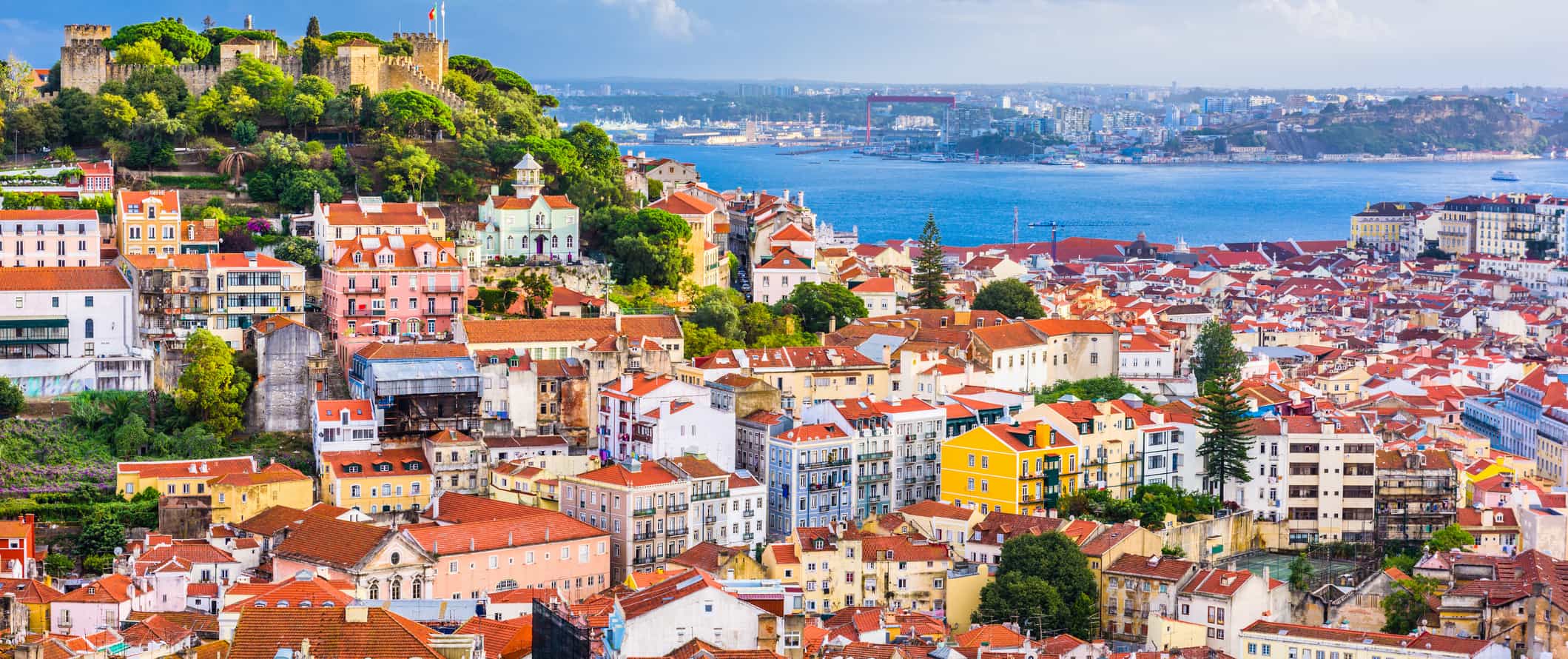
Situated along the south of the country’s west coast, Lisbon ( Lisboa in Portuguese) boasts an incredible mix of museums, historic buildings, eclectic music, a wild nightlife, charming plazas, and laid-back cafés where you can watch the world go by.
In recent years, Lisbon has become a lot more popular thanks to its inexpensive cost of living and lovely year-round weather. While it’s not the hidden gem it used to be (there’s a growing expat and digital nomad community here now), I don’t think it’s lost its magic — especially if you visit during the shoulder season when the weather is still great and the crowds have thinned out.
This Lisbon travel guide will give you everything you need to plan your trip, save money, and make the most of your time in this underrated European capital!
Table of Contents
- Things to See and Do
- Typical Costs
- Suggested Budget
- Money-Saving Tips
- Where to Stay
- How to Get Around
- How to Stay Safe
- Best Places to Book Your Trip
- Related Blogs on Lisbon
Top 5 Things to See and Do in Lisbon
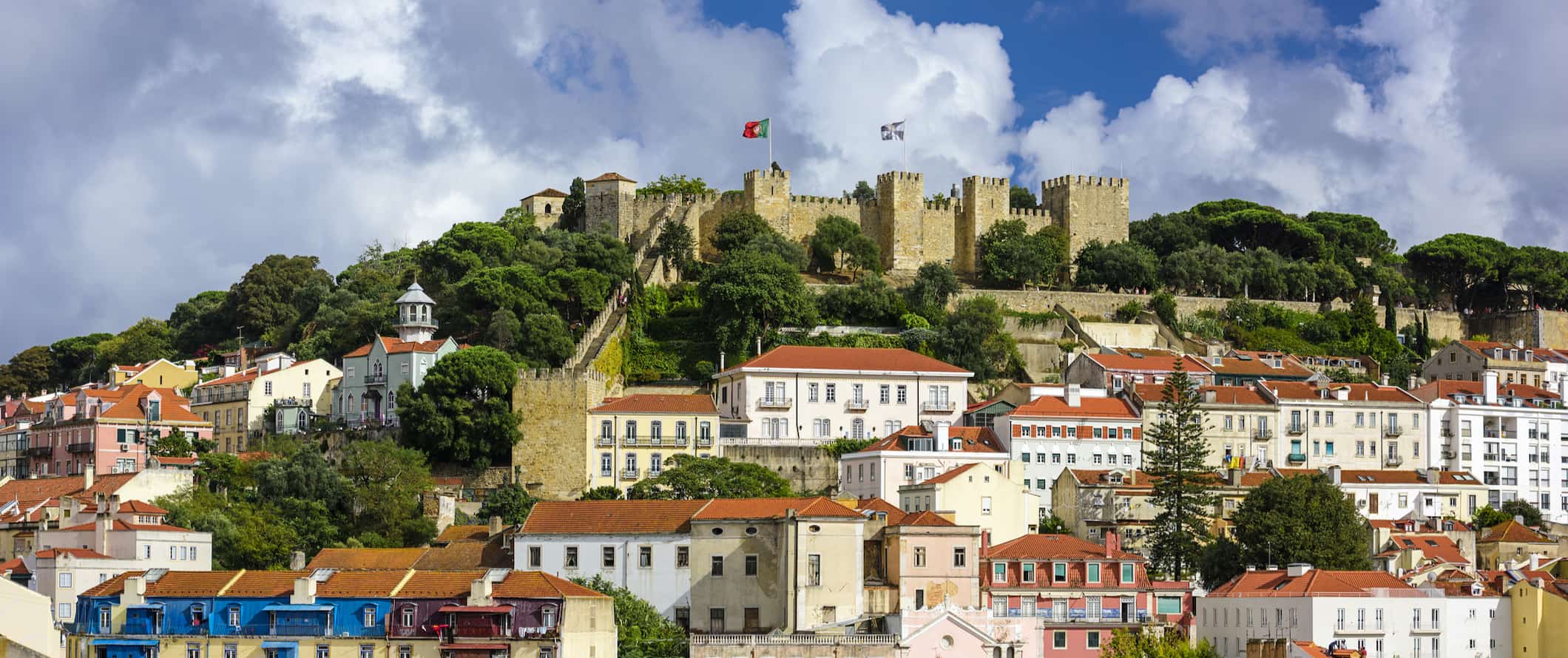
1. Walk around the Old Town
Alfama, the historic area of Lisbon, is filled with narrow, winding streets lined with shops, cafes, and restaurants. The name, meaning “hot springs,” comes from the Moors who conquered here in the 8th century. To learn more about this neighborhood, take a walking tour . Tours last 2.5 hours and are a great intro to the city and its iconic sights.
2. See the Belem Tower
Built in 1515, this tower was used as both a fortress and a lighthouse during the height of Portuguese power in the Age of Discovery. Situated on the northern bank of the Tagus River, the tower stands 30 meters (98 feet) and has 4 stories. It’s been a UNESCO World Heritage Site since 1983 and is open for self-guided tours where you can wander the halls, peek out the various portholes, and visit the pit where prisoners were kept. Admission is 9 EUR.
3. Walk through the Jardim Botanico
This massive 10-acre garden is a haven from the hustle and bustle of the city. Completed in 1873, it’s home to some 18,000 species of plants, including plants from New Zealand, China, Australia, Japan, South America, and more. It’s one of the best green spaces in Lisbon and perfect for relaxing. Admission is 2 EUR.
4. Hit the beaches
Lisbon has several beaches that are perfect for soaking in the city’s beautiful summer weather. Some of the best beaches are Guincho (best swimming area and good waves for surfing), Meco (peaceful atmosphere), Tamariz (easy to reach from the city center; good for kids), and Morena (has a fun vibe). Just be sure to get there early in the summer as the beaches get busy fast!
5. Explore St. George’s Castle
St. George (São Jorge) Castle is a massive medieval castle overlooking Lisbon. Fortifications on the hill date back as far as the 1st century BCE though the current castle dates to the Middle Ages. It was damaged during various earthquakes and more or less abandoned for centuries until the 1930s when it was finally restored and renovated. Today, you can tour the castle and the towers (they offer a beautiful view of the city) and visit the small archeological museum inside. There is also a small garden you can relax in as well as a restaurant. Admission is 10 EUR.
Other Things to See and Do in Lisbon
1. take a free walking tour.
The first thing I do in a new destination is to take a free walking tour. They’re the best way to see the main sights and connect with a local guide who can answer all your questions. New Europe is my go-to free walking tour company as their tours are detailed and their guides know their stuff. They’re the best way to see the city on a budget. Just be sure to tip at the end!
2. See the Berardo Collection Museum
The Berardo Museum of Modern and Contemporary Art has a wide selection of works by Warhol, Picasso, Dali, Duchamp, Bacon, Pollock, and many other masters. Its permanent and temporary exhibits have works representing dozens of modern movements from the past century. While I’m not a huge fan of modern or contemporary art, this is an excellent museum if you are. Admission is 5 EUR and free on Saturdays. Audio guides are 3.5 EUR.
3. Ride the “elevator”
For a sweeping view of Lisbon’s skyline, ride the Elevador de Santa Justa . It’s a century-old elevator located in the city that connects to a 45-meter-tall viewing platform. The elevator was originally steam-powered and offers a gorgeous view of the city. It has a small restaurant at the top where you can eat too. A ride costs 5.15 EUR but you can access the viewpoint (without a ride) for 1.50 EUR.
4. Visit the Praça do Comércio
Commerce Square is Lisbon’s biggest and most popular square. Located along the riverfront, it’s the former location of the royal palace (which was destroyed in a massive earthquake in 1755). Two marble columns from the palace are still standing and the square is now home to lots of small shops. The people-watching here — when accompanied with a book or some refreshing gelato — is excellent.
5. Check out Sé de Lisboa Cathedral
Constructed on the grounds of a former mosque, this Roman Catholic cathedral was built to celebrate the defeat of the Moors in the mid-1100s (a conflict that came about after a failed Crusade to the Holy Land). It’s been partially rebuilt over the years due to earthquakes and is now an amalgamation of Romanesque, Gothic, and Baroque architectural styles. While I’m not a huge fan of 12th-century Romanesque construction, the cathedral was very peaceful and beautiful. Be sure to dress appropriately as it is a place of worship. It’s free to enter.
6. Ride the trams
To get a sense of what life in Lisbon was like in the 20th century, hop on one of the yellow “Remodelado” trams. These old-fashioned trams are a fun way to explore the city and see the historic Old Town. While the city also has modern trams, enjoying the charm of the old-fashioned trams is a cheap and easy way to add some character to your visit.
7. See a Fado show
Fado is a local type of music that originated in Lisbon. It’s a rather haunting, mournful style often focused on the hardships of the poor or life at sea. The music first appeared in the 19th century and was popular with the working class (especially sailors). The word “fado” likely stems from the Latin word for fate, which is why many of the songs focus on the inevitability of misfortune and suffering. While melancholic, the music is also beautiful and poetic. To enjoy some traditional fado music, head to Clube de Fado, Tasca do Chico, Parreirinha de Alfama, or Senhor Vinho.
8. Visit the Mosteiro dos Jerónimos
This UNESCO World Heritage Site is a must-see when visiting Portugal’s capital. The monastery took over 100 years to build and was designed in the Manueline style (also known as Late Portuguese Gothic). The monks were primarily involved with helping sailors and mariners who anchored offshore, which is why there are many maritime designs and influences in the architecture. While it is no longer an active monastery, you can still tour the massive buildings and grounds. Admission is 10 EUR.
9. Check out the Discoveries Monument
The Monument to the Discoveries (Padrão dos Descobrimentos) was inaugurated in 1960 during celebrations of the 500-year anniversary of the death of Henry the Navigator (an important figure in the early Portuguese Empire). At 52 meters tall, it depicts Henry holding a small caravel alongside other heroes of Portuguese history. The monument is shaped like a ship’s bow and projects out above the water across the Tagus River. Within the monument is a museum with small historical and cultural exhibitions. On the seventh floor, you can look out to the Atlantic. Admission is 6 EUR.
10. Tour Batalha Monastery
Batalha is a town located just 90 minutes by car from Lisbon. The town is home to Batalha Monastery, officially known as the Monastery of Saint Mary of the Victory. Built in 1388, it’s one of Europe’s greatest Gothic masterpieces and makes for a popular day trip from Lisbon. The monastery took 131 years to build and is now a UNESCO World Heritage Site. Walking through the gigantic gothic doorway and seeing the towering interior (which is lined with 16th-century stained-glass windows) is absolutely breathtaking. Admission is 6 EUR, but you can also purchase a combo ticket to see The Convent of Christ in Tomar and The Abbey of Santa Maria for 15 EUR.
11. Enjoy a pastéis de nata
This delicious custard-filled pastry is a Portuguese staple. You can find them all over the city. They’re traditionally served warm and with cinnamon, paired with a coffee or hot drink. If you’re looking for an authentic experience, check out Pastelaria Versailles. They’ve been around since the 1920s and make some of the best in the city.
12. Take a day trip to Sintra
Lord Byron, writing in the 18th century, said that Sintra was “perhaps in every respect the most delightful [place] in Europe.” If you are visiting Lisbon, be sure to visit Sintra. It’s a wonderful town with cobblestone streets and traditional painted buildings filled with family-run cafes and unique shops. Wander the town on foot and check out the historic town hall, the bustling shopping street of Rua das Padarias, and the church of Igreja de Santa Maria (which dates to the 15th century and is a National Monument). Don’t miss the brightly colored Pena Palace and the Moors Castle. They offer wonderful views of the city. The train from Lisbon takes about 40 minutes and costs less than 5 EUR. If you’d rather take a tour, full-day tours with Tugatrips Tours cost around 65 EUR.
13. Visit MAAT
The Museum of Art, Architecture, and Technology is one of Lisbon’s newest museums. Its mission is to showcase contemporary artists, architects, and thought leaders via traditional exhibits and workshops while also revitalizing the waterfront neighborhood. They have rotating exhibits on music, philosophy, contemporary art, and much more. The building is a massive and futuristic-looking structure located beside an old industrial power plant (which you can also tour). Admission is 9 EUR and there is free admission on the first Sunday of the month.
14. Take a food tour
To learn more about the history and culture behind Lisbon’s cuisine, take a food tour. It’s the best way to eat your way around the city sampling the best eats Lisbon has to offer while learning what makes the cuisine unique. Devour Tours runs in-depth food tours led by expert local guides that will introduce you to the food culture and its history. If you’re a foodie like me who wants to learn more about the history and culture behind each dish, this tour is for you! Tours from 79 EUR.
For more information on other cities in Portugal, check out these guides:
- Lagos Travel Guide
- Porto Travel Guide

Lisbon Travel Costs
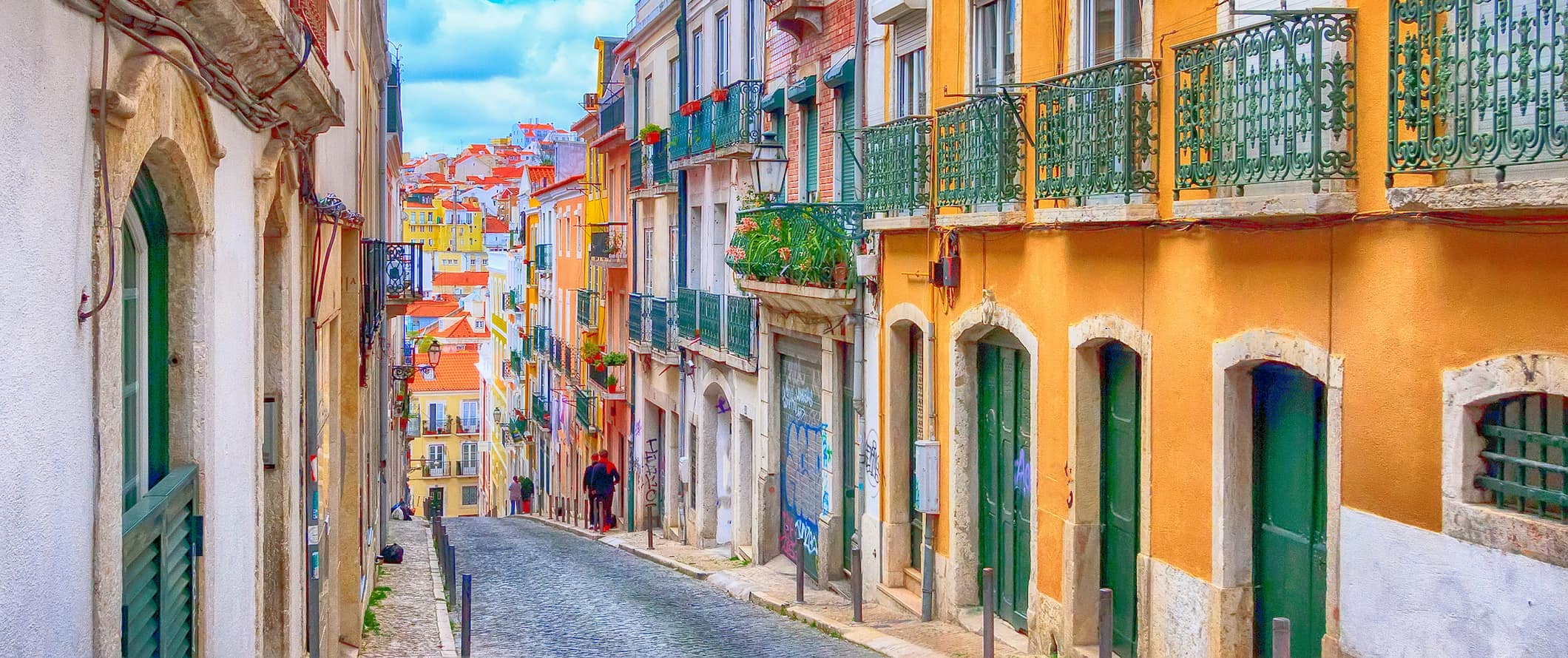
For those traveling with a tent, camping is available outside of the city. A basic plot for one person without electricity starts at 12 EUR in the off-season and 20 EUR in the summer.
Budget hotel prices – Two-star budget hotels start around 65-85 EUR per night. Expect basic amenities like free Wi-Fi, TV, and coffee/tea makers.
Airbnb is also available around Lisbon, with prices for an entire apartment starting at 70 EUR per night (but averaging more than double that). Private rooms start around 30 EUR but average closer to 70 EUR.
Food – Fish and seafood form the backbone of Portuguese cuisine (Portugal eats the most seafood per capita in Europe). Cod, sardinhas assadas (grilled sardines), sea bass, and shellfish are some of the most common staples. Other popular dishes include cozido à portuguesa (boiled stew), peixinhos da horta (breaded and fried vegetables), and cured ham. Be sure to also try the prego (beef sandwich) or the bifana (pork sandwich). You can find them at local cafes for just 5 EUR.
If you want a traditional meal with drinks at a casual restaurant, you’re looking at spending around 20-25 EUR (prices are higher in the touristy downtown area). Outside downtown, there are many local places where you can find meals for around 10-15 EUR.
A basic fast-food meal (think McDonald’s) costs around 7 EUR while a large pizza starts around 12 EUR. Chinese food costs 10-15 EUR for a main dish.
Beer is around 3 EUR while a latte/cappuccino costs around 2 EUR. Bottled water is less than 1 EUR.
For a week’s worth of groceries, expect to pay 35-45 EUR. That includes basic staples like pasta, vegetables, fruit, bread, cheese, and some meat or fish.
Backpacking Lisbon Suggested Budgets
On a backpacker budget, you can visit Lisbon for around 50 EUR per day. On this budget, you’ll be staying in a hostel dorm room, cooking all of your meals, limiting your drinking, using public transportation to get around, and sticking to free activities like free walking tours, enjoying the beaches, and exploring the Old Town. If you plan on drinking, add 5-15 EUR per day to your budget.
On a mid-range budget of 130 EUR per day, you can stay in a private Airbnb or private hostel room, eat at cheap local restaurants and cook some meals, use public transportation and take the occasional taxi, visit paid attractions like the botanic gardens and Belem Tower, and enjoy some drinks at the bar.
On a “luxury” budget of 240 EUR or more a day, you can stay in a hotel, eat out for every meal, drink what you want, rent a car to explore the region, and visit as many museums and attractions as you’d like. This is just the ground floor for luxury though — you can easily spend more if you really want to splash out!
You can use the chart below to get an idea of how much you need to budget daily. Keep in mind these are daily averages – some days you spend more, some days you spend less (you might spend less every day). We just want to give you a general idea of how to make your budget. Prices are in EUR.
Lisbon Travel Guide: Money-Saving Tips
Lisbon is the most expensive city in the country — but it’s still quite affordable compared to other European capitals. It’s hard to spend a ton here unless you are splashing out. If you find cheap accommodation, cook most of your meals, and stick to mostly free activities, you’re going to be able to keep your budget intact. Here are some quick tips to help you save money in Lisbon:
- Pick up a Lisbon Card – If you’re planning to visit lots of attractions, get the Lisbon Card. It offers free or discounted entry to several attractions as well as unlimited public transportation. Prices start at 21 EUR for a 24-hour card and there is also a 48-hour card for 35 EUR and a 72-hour card for 44 EUR.
- Get a bus pass – If you don’t get the Lisbon Card but still plan on using a lot of public transportation, buy a day pass. They are just 6.45 EUR and will save you a lot of money if you’re using public transportation often.
- Take a free walking tour – If you want to understand more about the history, architecture, and culture of Lisbon then take a free walking tour. They usually last a couple of hours and are a great introduction to the city. Just be sure to tip your tour guide at the end!
- Stay with a local – Couchsurfing is the best way to save on accommodation in Lisbon. By staying with a local you’ll not only save money but you’ll get to spend time with someone who can show you the city’s hidden gems and teach you more about the culture and history of Lisbon. Just be sure to send your requests early in the summer!
- Skip the taxis – Taxis are expensive, often adding fees for luggage and airport pickups. Simply use the metro or bus to get where you need to. You’ll save a ton.
- Say “no” to bread – When eating out, you’ll often be offered bread and olives. They will be brought to your table before your meal. These aren’t free, so politely decline the offer if you’re not interested in paying for them.
- Use BlaBlaCar – BlaBlaCar is a ridesharing app you can use to travel in between cities. It’s faster than the bus and usually just as cheap. You’ll have to find a ride, which can sometimes be hit or miss, but the profiles are verified and reviewed so it’s quite safe. Plus, it’s a great way to connect with other locals/travelers.
- Visit the Berardo Collection Museum on Saturdays – Tourists can get a glimpse of Portuguese businessman Jose Berardo’s personal collection of contemporary art, which makes up the permanent exhibits at the museum. Even if you aren’t a fan of contemporary art, the building itself is great to walk through. The museum is free on Saturdays.
- Bring a water bottle – The tap water here is safe to drink so bring a reusable water bottle to save money and reduce your plastic use. LifeStraw is my go-to brand as their bottles have built-in filters to ensure your water is always clean and safe.
Where to Stay in Lisbon
Lisbon has lots of hostels. In fact, it’s one of the best cities in the world for hostels. Here are my suggested places to stay in Lisbon:
- Lookout! Lisbon Hostel
- Lisboa Central Hostel
- Yes! Lisbon Hostel
- Home Lisbon Hostel
How to Get Around Lisbon
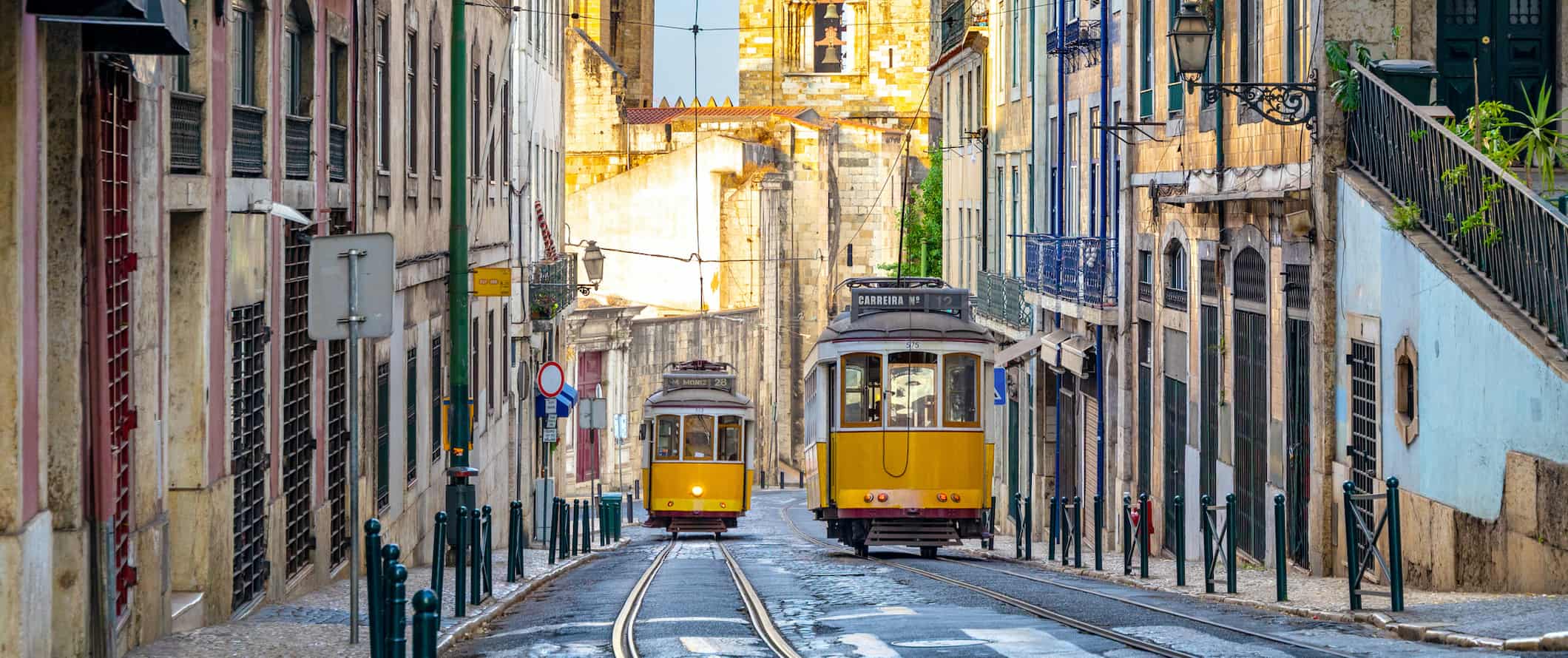
There are two tram lines in the city: the modern Siemens “Articulado” trams and the historic “Remodelado” trams. Trams cost 1.50 EUR.
The metro offers a fast way to get from one corner of the city to another. There are four lines and 56 stations. They are very accessible and the information and maps are provided in English so it’s easy to navigate. Prices are the same as the tram and bus.
Taxi – Taxis in Lisbon start at 3.50 EUR and increase 0.50 EUR for every kilometer traveled. Most drivers speak English but showing them the address on your smartphone will help. If you’re on a budget, skip the taxis. They get expensive fast!
Ridesharing – Uber is available in Lisbon but it’s not much cheaper than the taxis. Bolt and FreeNow are two other ridesharing apps that are usually cheaper than Uber, but I’d still skip ridesharing altogether if you’re on a budget.
Bike rental – If you’re an avid cyclist who likes a challenge, then biking in Lisbon can be fun. For the non-cyclist, it will likely be unpleasant. The city is filled with steep hills and cobblestone streets — hardly ideal for a leisurely ride. Bike rentals start at 10 EUR for a half-day and go up to 25 EUR for a full day. You can also try Gira, the city’s bike-sharing system (you can buy a 24-hour pass for just 2 EUR).
Car rental – You won’t need to rent a car to get around the city as public transportation is reliable and efficient. If you plan to go on a day trip, you can rent a car to have more flexibility. It will be more expensive than taking the bus or train but will give you more freedom. Expect to pay 30-40 EUR per day for a small rental car. Drivers need to be at least 21 years old.
When to Go to Lisbon
Peak season in Lisbon is during the summer months of June-August. Temperatures during that time soar to 25-30°C (77-86°F). This is also the busiest time to visit the city so expect crowds and slightly higher prices. The overall atmosphere during this time is lively and there are lots of places to swim or relax on the beach so it’s still worth visiting during peak season.
If you’re on a budget, the best time to visit Lisbon is during the shoulder season. April-May and September-October are still warm so you can enjoy the outdoors without as many crowds. Temperatures hover between 12-25°C (53-77°F) during these months. It may be a bit rainy, but you can still enjoy the city without much inconvenience.
Winter is from November to February. It gets cold, and tourist crowds thin out considerably. Temperatures vary but hover around 10°C (50°F). It’s still warmer than much of Europe, so if you’re on the continent and are looking to avoid the worst of the weather, head to Lisbon (or even further south to Faro).
How to Stay Safe in Lisbon
Lisbon is very safe for travelers — including solo female travelers. Violent attacks here are uncommon and petty crime is rare. Pickpocketing is the most common crime so just be aware of your surroundings when you’re in busy markets or when using public transportation and always keep your valuables secure and out of reach.
Young backpackers may be approached and offered drugs as Portugal has decriminalized drug use. However, selling drugs is not legal and there are still consequences so simply decline the offer politely but firmly and continue on.
You won’t find a lot of travel scams in the city but read this article on common travel scams to avoid if you’re worried about getting ripped off.
Solo female travelers should generally feel safe here, however, the standard precautions apply (always keep an eye on your drink when at the bar, never walk home alone intoxicated, etc.).
The emergency number in Lisbon is 112.
The most important piece of advice I can offer is to purchase good travel insurance. Travel insurance will protect you against illness, injury, theft, and cancellations. It’s comprehensive protection in case anything goes wrong. I never go on a trip without it as I’ve had to use it many times in the past. You can use the widget below to find the policy right for you:
Lisbon Travel Guide: The Best Booking Resources
These are my favorite companies to use when I travel. They consistently have the best deals, offer world-class customer service and great value, and overall, are better than their competitors. They are the companies I use the most and are always the starting point in my search for travel deals.
- Skyscanner – Skyscanner is my favorite flight search engine. They search small websites and budget airlines that larger search sites tend to miss. They are hands down the number one place to start.
- Hostelworld – This is the best hostel accommodation site out there with the largest inventory, best search interface, and widest availability.
- Booking.com – The best all around booking site that constantly provides the cheapest and lowest rates. They have the widest selection of budget accommodation. In all my tests, they’ve always had the cheapest rates out of all the booking websites.
- HostelPass – This new card gives you up to 20% off hostels throughout Europe. It’s a great way to save money. They’re constantly adding new hostels too. I’ve always wanted something like this and glad it finallt exists.
- Get Your Guide – Get Your Guide is a huge online marketplace for tours and excursions. They have tons of tour options available in cities all around the world, including everything from cooking classes, walking tours, street art lessons, and more!
- The Man in Seat 61 – This website is the ultimate guide to train travel anywhere in the world. They have the most comprehensive information on routes, times, prices, and train conditions. If you are planning a long train journey or some epic train trip, consult this site.
- Rome2Rio – This website allows you to see how to get from point A to point B the best and cheapest way possible. It will give you all the bus, train, plane, or boat routes that can get you there as well as how much they cost.
- FlixBus – Flixbus has routes between 20 European countries with prices starting as low 5 EUR! Their buses include WiFi, electrical outlets, a free checked bag.
- SafetyWing – Safety Wing offers convenient and affordable plans tailored to digital nomads and long-term travelers. They have cheap monthly plans, great customer service, and an easy-to-use claims process that makes it perfect for those on the road.
- LifeStraw – My go-to company for reusable water bottles with built-in filters so you can ensure your drinking water is always clean and safe.
- Unbound Merino – They make lightweight, durable, easy-to-clean travel clothing.
- Top Travel Credit Cards – Points are the best way to cut down travel expenses. Here’s my favorite point earning credit cards so you can get free travel!
- BlaBlaCar – BlaBlaCar is a ridesharing website that lets you share rides with vetted local drivers by pitching in for gas. You simply request a seat, they approve, and off you go! It’s a cheaper and more interesting way to travel than by bus or train!
Lisbon Travel Guide: Related Articles
Want more info? Check out all the articles I’ve written on backpacking/traveling Portugal and continue planning your trip:
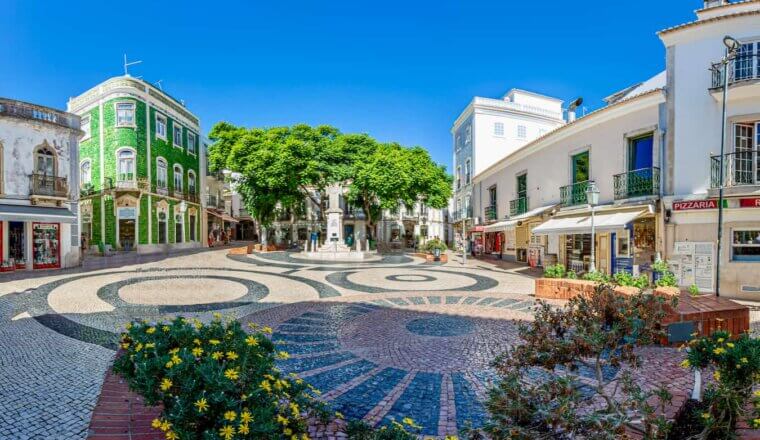
The 4 Best Hostels in Lagos, Portugal
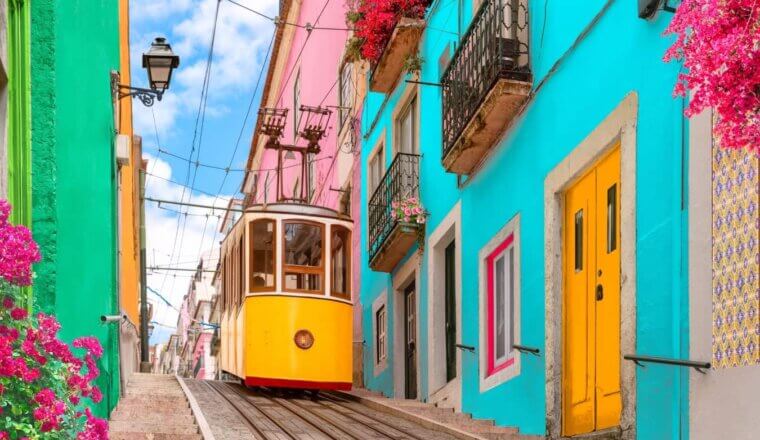
The Best Walking Tours in Lisbon
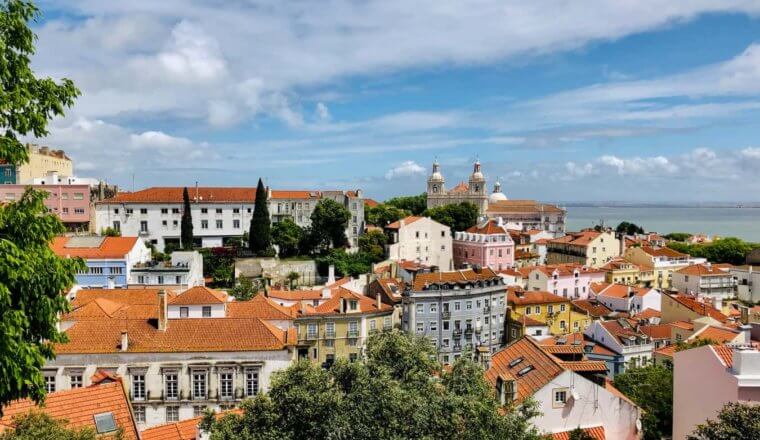
Where to Stay in Lisbon: The Best Neighborhoods for Your Visit
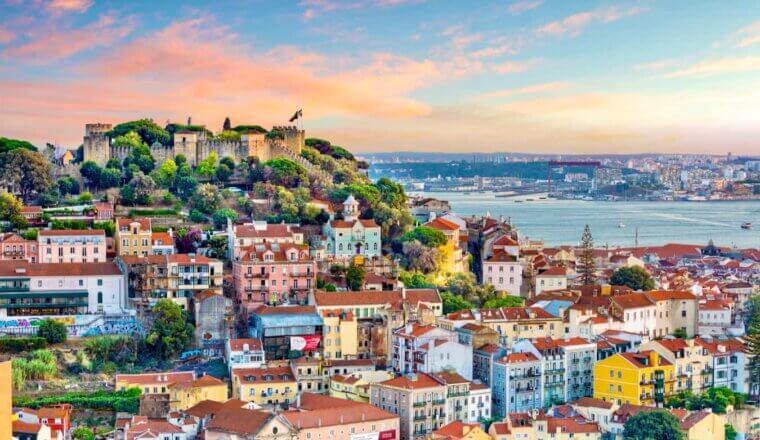
The 9 Best Hostels in Lisbon
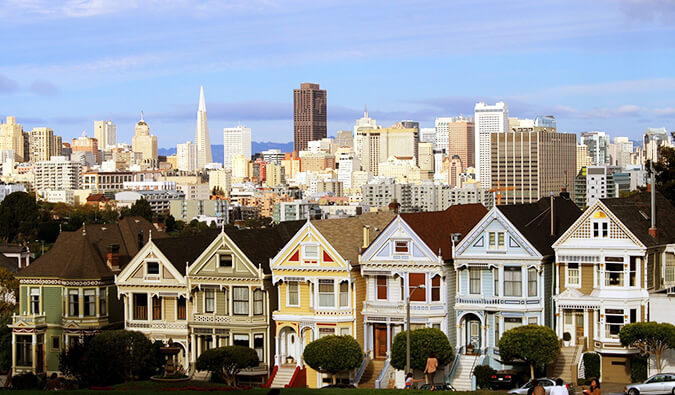
When Three Days Is Not Enough Time
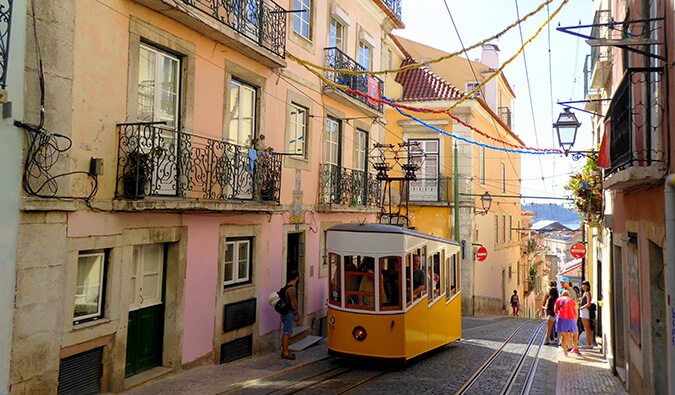
Lisbon: Even Better the Second Time
Get my best stuff sent straight to you, pin it on pinterest.
- Where To Stay
- Transportation
- Booking Resources
- Related Blogs
Subscribe here
Coming soon, subscribe here to be the first to know when we launch this, the absolute best lisbon, portugal getaway: a 5 day itinerary with must see stops.

Charismatic and charming Lisbon is a city that catches the attention of travellers in an understated way.
The region and surroundings of Lisbon are usually not the first places in Europe that one thinks of, but when you’re here, like a spell, people often find themselves enchanted by the plethora of things to do and see.
From the average 300 days of sunshine that Lisbon gets per year, to the rambunctious markets, historic architecture, emerging culinary scene and notorious nightlife - the capital city of Portugal is one not to miss out on, and to find yourself coming back to over and over again.
What’s even more under the radar to a lot of travellers are the adventures you can have surrounding Lisbon. This region - from Sintra, Berlenga Island to Arrabida Natural Park makes tantalizing day trips for anyone looking to get out in nature, mix things up from the city breaks, and soak up why this corner of Portugal is truly like a daydream. Curious? Follow me on Instagram and YouTube for more adventures!

Know Before You Go
A long favourite city getaway for Europeans during the winter and summer - Lisbon and the surrounding area seems to be perfect for a holiday any time of the year.
- No wonder why! During the winter months from November to February, Lisbon has the mildest winter out of any major European city, ranging between 8 and 10 °C - and that’s the lowest at night. For those sun-seekers during the usual grey European winters, Lisbon is the perfect place to be - with an average of 9 hours of sunlight in the winter.
- During the summer months from June to August, the temperature rises up to an average of 28 until it cools down in late September. This makes the beaches in Lisbon and the surrounding perfect for swimming for many months through to autumn.
- The shoulder season in Lisbon and the surrounding areas ranges from a balmy 18 °C to 22 °C. These months from March - May and from September to early November, makes a great time to explore the capital of Portugal without the large amount of crowds during the summer.

Day 1 - Lisbon: exploring Baixa, Chiado and Alfama neighbourhoods
Built on 7 hills by the Tagus River , wherever you are in Lisbon, it’ll always feel like there’s a view. That’s because your eyes will marvel at sights like the city’s matching orange tile rooftops, sweeping grand cathedrals or the colourful tiled art buildings - a true visual feast of a city.
Start your Lisbon trip off at Parque Eduardo VII , where if you stand at the very top of the well-manicured lawn, you’ll have a pretty good first impression of what the city is. The view looks over the Tagus River , and the many buildings perched on the hills of Lisbon. While you’re at the park, be sure to explore the Estufa Fria, an immaculate greenhouse that has an array of ponds, and various gardens that are filled with diverse flora and fauna.
From here you can either continue walking or biking down to Rossio Square , which is the heart of the capital city. Lisbon is known for its safe and well-connected cycling lanes that make biking an easy way to get around and see the city. If you decide to book a bike tour around Lisbon, you will see the city in a fun way at a comfortable pace. Once you’re at Rossio Square , you can have a drink at one of many old-world European cafes or just take in the architecture. The wavy pattern of the square’s cobblestones is dazzlingly hypnotic, just like the beauty of the two baroque fountains here. You’ll also spot the neoclassical Dona Maria II National Theater , which has watched over this atmospheric centre since the 1840s.
Make your way down Rua Augusta , a street made for leisure strolls since it’s completely pedestrian-friendly. This street is smack middle of the Baixa district, which is Lisbon’s downtown with grand classical buildings all around you to remind you of the deep heritage this city has. None truer of this is Commerce Square, or Praça do Comércio , which is a representation of the Portuguese empire’s reach and wealth at the height of the late 18th century. The iconic Arco da Rua Augusta guards the square but also has an observation platform at the top that gives you a great sight of Rue Augusta . Architecture lovers shouldn’t miss the Elevador de Santa Justa , a Gothic-sampled wrought-iron lift that still functions today that you can take up to the viewing platform and walkway.

For non-touristy things to do and see in Lisbon, check out our list here .
In the later part of your day, from Baixa district, we’ll explore the Chiado and Alfama neighbourhoods. You can do a walking tour of Lisbon through these neighbourhoods with a local guide that goes in-depth with each highlight stop of the city.
Chiado is Lisbon’s most glamorous neighbourhood, with well-preserved pristine buildings harking back to the late 1700s. This glitziness shimmers in the architecture in the neighbourhood too - with Basílica dos Mártires being one of the more gorgeous basilicas in the city. I don’t want to spoil too much, but if you step inside the baroque and neoclassical architecture, have a lookup! The ceiling paints the story and glories of Afonso Henriques, Portugal’s first king.
Amongst the many art galleries in this neighbourhood, the National Museum of Contemporary Art of Chiado stands out. The museum celebrates Portuguese artists, highlighting the country’s cultural and creative scene. If you have time and are an art enthusiast, don’t miss out on the wide range of collection that is on display from paintings to installations, photography and sculptures.
The 14th-century Convento do Carmo is a gothic ruin with arches underneath a clear sky due to the roof never being repaired. It’s a sight to behold, leaving you with a chillingly haunting feeling amongst the leftover disintegrated convent.
If you’re a book lover and have a love for old-world book stores, definitely check out Bertrand Bookstore while you’re in Chiado. When I mean old - I mean, they’re literally the oldest bookstore in the world with a Guinness World Record hanging in the door to prove it!

If you choose to do a walking tour of Lisbon , it’ll wrap up in Alfama, which coincides with this itinerary for the day. Alfama is Lisbon’s most historical neighbourhood - with civilisations stacked on top of each from the Romans, Visigoths, Moors and Germanic tribes. Lisbon is one Instaworthy city, but most feel the neighbourhood of Alfama is the most picturesque of all.
Get lost in the labyrinthine cobblestone alleys, looking up at the numerous pastel coloured and tile covered homes of Alfama. You can take tram 28 - yes, the iconic yellow trams that have become one of the symbols of Lisbon, into Alfama. Explore St. George's Castle , which can be seen from almost anywhere around Lisbon since it’s on such a high hill. Since we’re already so high up, a nearby walk away is the Portas do Sol Viewpoint . This is your classic terrace panorama of Lisbon - where you can see out to see the city’s most emblematic sights. From this viewpoint, with the cathedrals and water in the distance, you get the best of what makes Lisbon so beloved by locals and travellers alike!
The Lisbon Cathedral and the National Pantheon are other highlights of Alfama, two glorious architectural beauty contrasting yet complimenting the Capital city. The cathedral is gothic and almost 9 centuries old! While the all-white pantheon has a striking dome, that has a grand terrace crowning over the city.
Now for the romantics and sunset lovers (who doesn’t love a good sunset spot?) end your day at Santa Luzia Viewpoint . Consider this spot the city’s own public balcony, where you can stroll underneath classical columns that are wrapped in fully blossomed bougainvillea flowers. If you’re here at sundown, the view of the Tagus River and Lisbon will look like it's set in a blaze of soft orange hues. I know, cue the awws!
Where to Stay in Lisbon:
Budget - Famous Crows Lisbon Suites
Check the latest rates and the reviews on Booking.com
Mid-range - Rossio Garden Hotel
Luxury - Hotel da Baixa

Day 2 - Lisbon: exploring the Belem neighbourhood
The second day of Lisbon continues a whirlwind of the city’s best, this time in the neighbourhood of Belem. Dating back to the 15th and 16th century where Portuguese sailors ruled the seas, and explorers were funded to discover various trading routes around the world - Portugal and specifically Lisbon, became a massively wealthy empire. Belem, being right on the docks and shipyards reflects this adventurous past.
It’s also home to Pastéis de Belém , a famous and affordable cafe where the golden shimmering Pastel de nata custard tart was born. Biting into one of these tarts is a delight, whether you’re starting your day off with them or taking a travel break with this snack. The tart is made out of egg and sometimes is dusted with cinnamon, being up there now of what you think of when you think of Portuguese cuisine (including the bacalhau cod, piri piri chicken, and ginjinha - cherry liquor). If you’re curious about taking your tastebuds through more Portuguese delights, definitely check out a local food and wine walking tour of Lisbon .

While in Belem, you won’t be able to miss the imposing fort of Torre de Belem . The Moorish architecture of the watchtowers has become a unique architectural sight in Europe itself. Nearby, the Padrão dos Descobrimentos is a huge sculpted monument that memorializes the country’s history as explorers of the sea from the 15th century “Age of Discovery”. The influence of the Portuguese from this seafaring time is still seen around the world to this day - with former colonies like Macau cherishing their own version of the pastel de nata, to Brazil speaking Portuguese as their main language.
A close by walk is the Jerónimos Monastery, aka Mosteiro dos Jerónimos . It’s a massive ornate monastery where you can visit the chapel for free. Even just staring at the doors you’ll be impressed by the little details sculpted into the religious figures that guard the monastery. The Mosteiro dos Jerónimos is a UNESCO World Heritage Site and adds to the impressive regalness of Belem.
On the way back to the city’s centre, your final stop is LX Factory . Picture this, a big industrial site with factories that dates back to the mid 19th century, where everything was the hub for the textile industry. Now, it’s a hub for creatives - artists who have transformed the once-run down area into one of the most eclectic sites in Lisbon. There’s a cool bookstore, various cafes, local boutiques, and a wine shop. Welcome to where Lisbon’s cool crowd hang.
If you have some extra time, check out these other non-touristy things to explore in Lisbon here .
Budget - My Charm Lisbon Suites
Mid-range - Emporium Lisbon Suites
Luxury - TURIM Boulevard Hotel

Day 3 - Sintra’s Forest and Castles
After exploring Lisbon, it’s worth it not to miss out on a day trip to the UNESCO Cultural Landscape site of Sintra. This is the first bite into outside of the capital city, with a memorable impression that will have you see why this region is so gorgeous. Sintra is a village of romance and whimsical sights just right outside of Lisbon. Known for its fairytale-like gardens, forests that poets dream about, and architecture fit for princes and princesses.
These once opulent kingdoms have leftover ruby red castles and sunlight yellow palaces sitting on various hills of Sintra to explore. If you’re looking for an easy fun tour of Sintra’s forest and castle , you can even get pickup and drop-off from Lisbon (Sintra is only a 30-minute drive away).
Castelo dos Mouros is a hilltop Moorish fortress that stands out for its winding stone walkways, overlooking the sea. Trust us when we say even the fortresses in Game of Thrones got nothing on this place.

Nearby, the 19th-century Romanticist Pena Palace is built fittingly as a summer home for Portuguese royalty. The more you explore the palace grounds, the more unique splendours you’ll discover: viewpoints, windows that look out into the surrounding enchanting forests, fountains and walking trails that twist and turns decoratively everywhere.
Then there’s Quinta da Regaleira - which from the outside may look less eccentric with its Gothic facade than its neighbouring castles and palaces, but don’t underestimate this estate. Your mind will be blown away by the exquisite complexity and many worlds are held within this one UNESCO Heritage Site: a palace, fountains, a chapel, water-filled grottoes, deep wells, and lakes, just to name a few.
These are just some of the big names amongst the many other sights of Sintra that you’ll get to explore on the tour , or just by spending a whole day in this village.
Where to Stay in Sintra:
Budget - Casa do Arco
Mid-range - Arribas Sintra Hotel
Luxury - Casa Holstein Quinta de Sao Sebastiao Sintra

Day 4 - Berlenga Island
When you picture Portugal, you picture the pure nature of the blue sea and the endless coast with it. After all, most of the country is on the coast! A day trip to Berlenga Island from Lisbon to experience that wild side would be the perfect getaway.
Berlenga Grande is an island off the coast of Peniche, a quaint fishing village. To get there, you’ll have to take a boat, but the ride is already as scenic with lapping waves and shimmering waters, as the island itself. Now here’s the thing, to make sure that the island’s natural environment is well protected and remains unspoiled, only a maximum of 350 visitors are allowed to visit.
There you can take a hike through the reserve, and if you’re lucky, you’ll see puffins, which are endangered but a symbol of the nature reserve. Along with rare species like the puffin, you’ll see other animals during your hike, which adds to the Berlengas Archipelago ’s magic.

If you’re curious about an effortless pick-up and drop-off with activities like kayaking through the islands’ caves, definitely consider booking an adventure day tour for Berlenga Island. This will also guarantee you to be part of the daily max visitor cap for the island.
Where to Stay in close to Berlenga in Peniche:
Budget - Casa Berlengas a Vista
Mid-range - RIDE Surf Resort & Spa
Luxury - Kerala 49, Deluxe Flat in Historic Center

Day 5: Arrabida Natural Park
Don’t leave Lisbon without exploring the Arrabida region! It’s only a 30 minutes drive from the Capital city, yet it’s an enriching area whether you’re a wine lover (you’ll see plenty of Portuguese vineyards here) or an outdoor enthusiast for visiting Arrabida Natural Park .
The unparalleled natural beauty of Arrabida is unmatched in this area of Portugal, as you look out at its mountain ranges swooping down into the sandy beaches and turquoise waters. This is where the Lagoa de Albufeira aka Albufeira Lagoon is, a haven for windsurfers and those who want to enjoy the golden sandy beach. So if you’ve been craving beaches near Lisbon, this would be the perfect place for you.

Exploring Arrabida Natural Park isn’t like just any other regular park, as there are plenty of activities you can do from dolphin watching on a catamaran , or even just leisurely kayaking across a protected coast of the park , as you look up at rugged cliffs and explore various caves.
The nature of Arrabida National Park truly has a little something for everyone.
Where to Stay close to Arrabida:
Budget - Casa em Palmela - Setúbal
Mid-range - Porta da Arrábida Suites
Luxury - Arrábida Heritage @Portugal Luxury Retreat

Map of Lisbon and surrounding stops
For the each stop in the itinerary, see it plotted out on our map:

Let our AI assistant help plan your trip
Create a personalized plan and share it with your friends

Continue reading

Never run out of things to do! Sign up to our newsletter today, what are you waiting for?

The first slow travel guide
Antwerp - Belgium
Supported by


33+ Important Tips for Visiting Lisbon for the First Time
The secret is definitely out: visiting Lisbon, Portugal is an absolute delight!
While this sunny, colorful capital city may have been under the radar a decade or two ago, today it is deservedly popular with travelers near and far.
As beautiful as Lisbon is, though, there are definitely some quirks to keep in mind when visiting–which is why we’ve rounded up the best Lisbon travel tips to keep in mind as you plan your first trip to the “Queen of the Sea”.
As American ex-pats who have spent a year calling Lisbon home (and hosted many family and friends along the way), we have quite a bit of advice for traveling Lisbon well!
Here are our top tips for visiting Lisbon for the first time.
Table of Contents
Tips for Visiting Lisbon’s Top Attractions
Lisbon travel tips for getting around the city, tips for taking day trips from lisbon, tips for visiting lisbon’s restaurants + snack bars, other tips for your first trip to lisbon.

Some links in this post may be affiliate links. If you make a purchase through one of these links, we may earn a small commission at no extra cost to you. Please see our disclosure policy for more detail.
You don’t necessarily need to go into the Belém Tower.
As you’ve started planning your Lisbon travels, it’s practically guaranteed that you’ve come across photos of the famous Belém Tower along the way.
The tower is one of the most recognizable landmarks in Lisbon, a prime example of the Manueline architecture that the city is famous for, and is absolutely beautiful.
… but for travelers with only a short trip to Lisbon planned, there’s no reason to go inside.
While the exterior of the tower is definitely worth seeing (it’s gorgeous, free, and quick to visit), the interior is comparatively plain.
Getting to see the details of the tower up close is nice, but the rooms of the tower are empty, you can get equally stunning views from dozens of other viewpoints in Lisbon, and it is far too small to accommodate the number of visitors it gets each day.
If your visit goes as ours did, you’ll end up waiting in line to access each separate level of the tower–and none of them are really worth the wait.
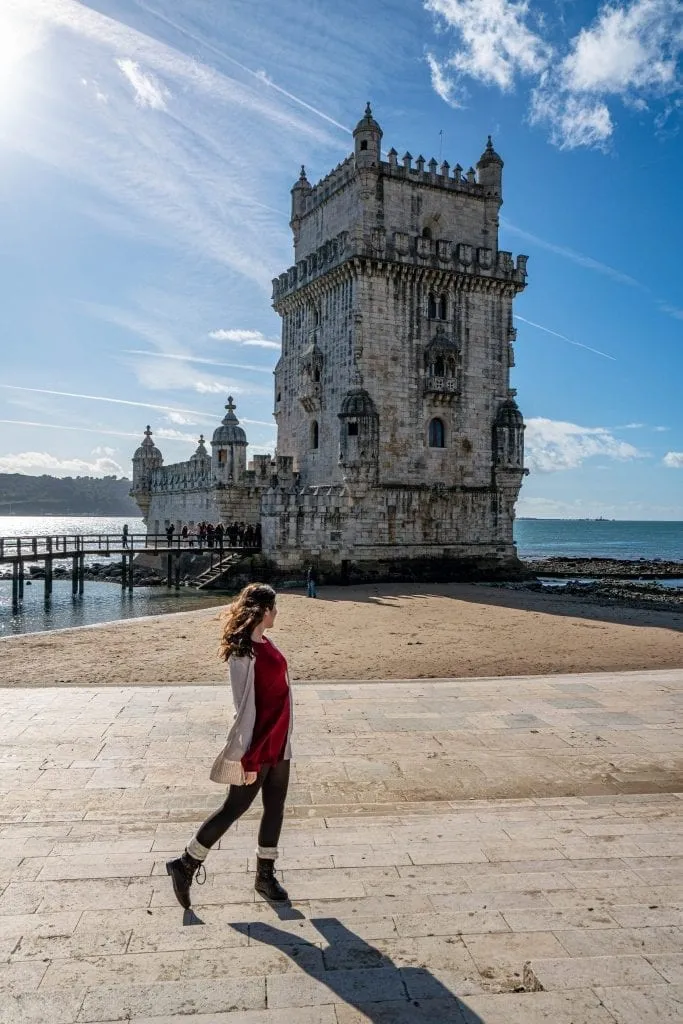
Buy tickets in advance for the most popular attractions.
The top attractions in Lisbon, including the Jerónimos Monastery and Castelo de São Jorge , get extremely crowded, and it will make your life much easier to purchase tickets in advance!
This Lisbon travel tip goes for nearby Sintra, too, especially at the iconic Pena Palace and the dreamy Quinta da Regaleira.
We tend to book most of our tickets for Lisbon in advance through Get Your Guide or Tiqets , both of which are reputable and easy to use.
Shop tickets and tours for visiting Lisbon today!
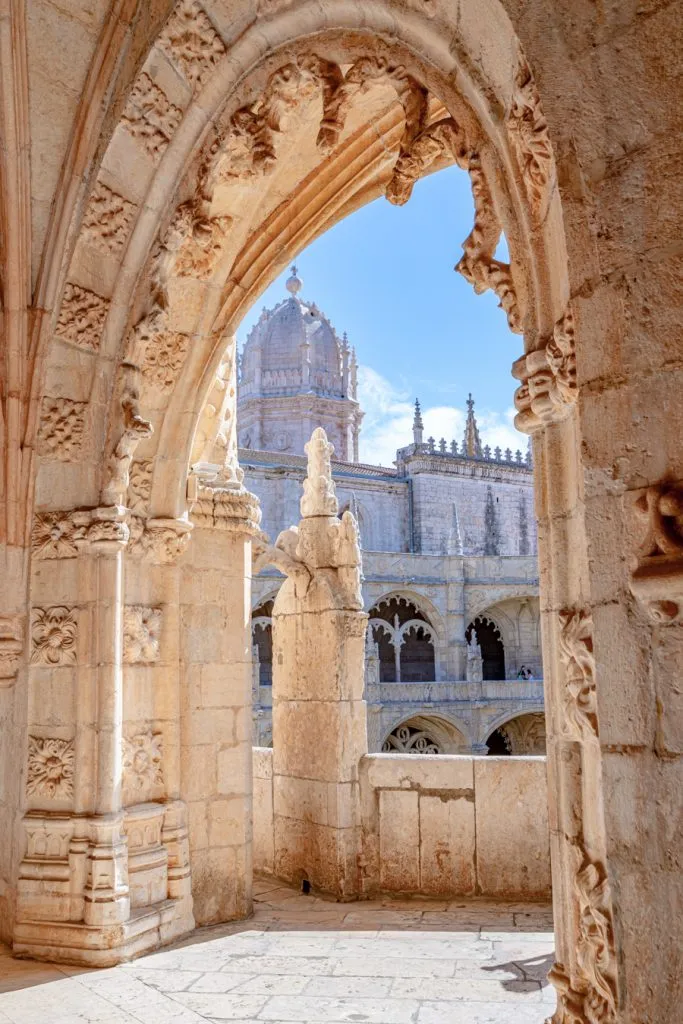
There’s no reason to wait in line for the Santa Justa Lift.
The striking Santa Justa Lift, designed and built by a student of Gustave Eiffel, is one of the most popular landmarks in the city.
Originally built as public transportation to connect Baixa to Chiado/Bairro Alto, today riding the lift is the definition of a tourist trap, drawing long lines at all hours of the day.
However, if you’re standing in the shady Largo di Carmo, facing the roofless church (which is absolutely worth visiting), you’ll notice a small street to the right that leads along the side of the church.
Follow it, and in less than a minute, you’ll find yourself at the top of the famous Santa Justa Lift!
You can walk out onto the lift for free at this point, and enjoy the exact same views that the visitors waiting in line down in Baixa are waiting for–but without cost or having to wait.
The view is beautiful, too, especially when standing out on the lift and facing Castelo de São Jorge.
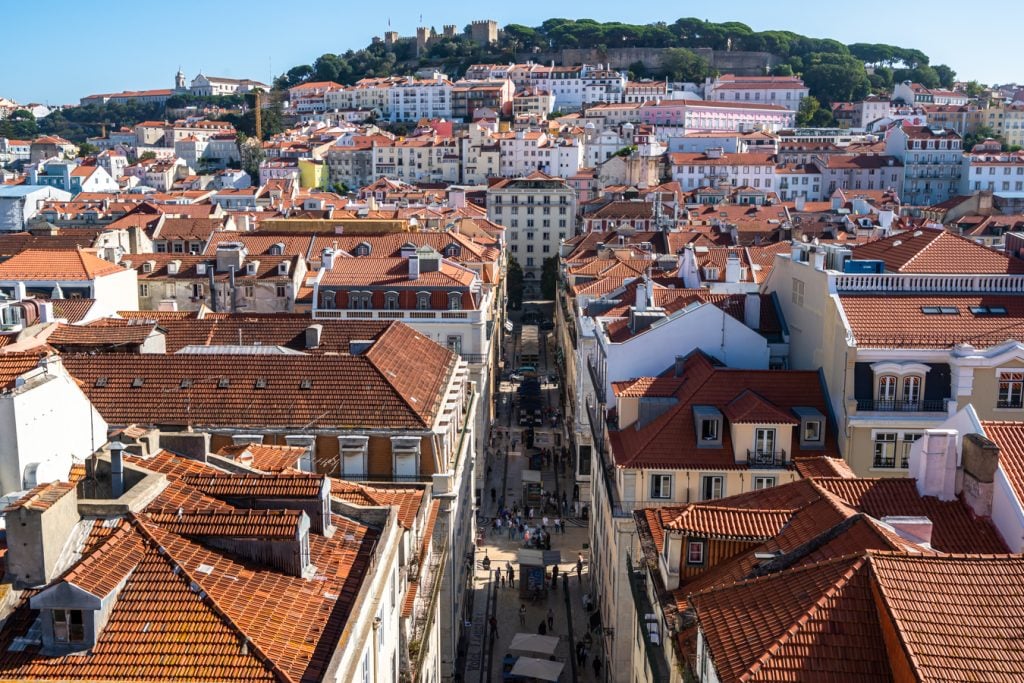
Lisbon’s hidden gems are truly worth the effort.
While the city’s top attractions definitely tend toward being very crowded today, there are hundreds of incredible things to do in Lisbon that draw a fraction of the visitors despite being well worth a visit.
A few of our favorites include the Monastery of São Vicente de Fora (beautiful azulejos and incredible views from the roof), the National Museum of the Azulejo (famous yet uncrowded as it’s a bit out of the way), the National Coach Museum , and the Calouste Gulbenkian Museum .
The sky is truly the limit when it comes to less-visited museums and monuments in Lisbon, though!
Other incredible options include the National Pantheon, the Ajuda Palace , and the garden of Quinta dos Azulejos.
You can read our guide to Lisbon’s secret spots here .
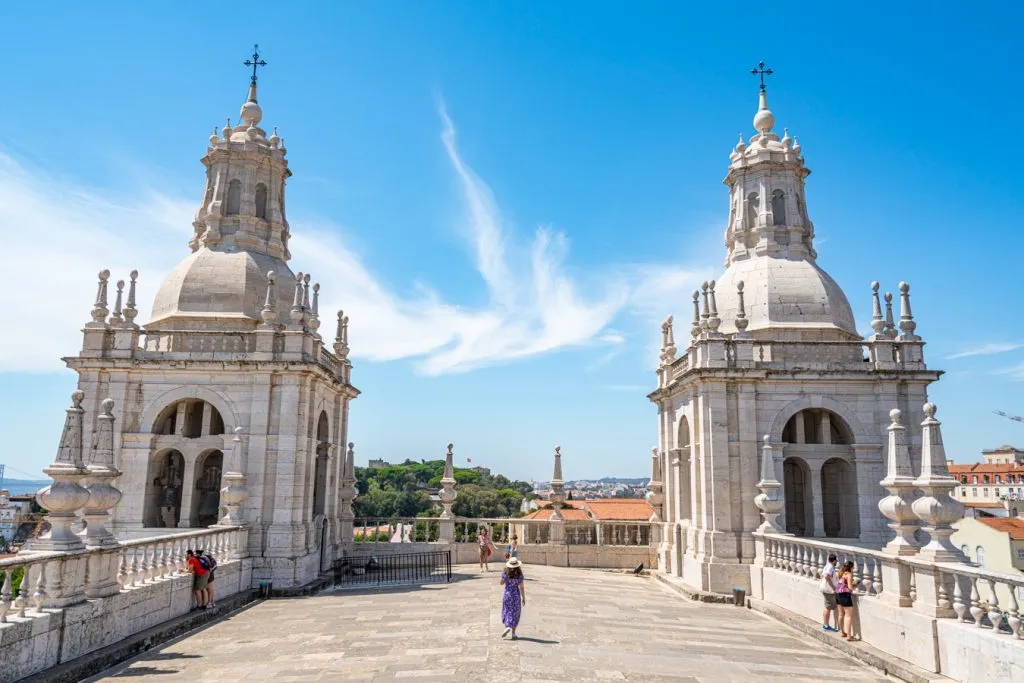
Don’t buy a Lisbon Card without planning your trip first.
Buying a Lisbon Card is a popular option for people visiting Lisbon for the first time, but we recommend not buying one until you plan your trip to Portugal in a bit more detail!
The biggest reason to buy the card has less to do with the attractions, and more to do with the ease of navigating Lisbon’s public transportation system.
With a Lisbon Card, you’ll be able to travel around with Lisbon’s buses, trams, metro, and trains (including the train to Sintra ) for one price.
This is definitely appealing, but how much actual cash value having a Lisbon Card is worth depends heavily on how much public transportation you plan to use (and whether you’re comfortable buying tickets in a more traditional way).

While the Lisbon attractions included with the card are certainly worth visiting, beyond the Jerónimos Monastery, most of them don’t typically feature on a first-timer’s Lisbon itinerary .
And, they’re not even all in Lisbon!
Alcobaça Monastery and Batalha Monastery, for example, are some of my favorite places in Portugal… and are located more than an hour outside the capital.
We’re certainly not saying that you shouldn’t buy the Lisbon Card –it can be a great fit for some travelers–but don’t assume it’s an obvious advantage, either.
Also, note that while you can purchase the card online, you’ll still have to pick up the physical card during your Lisbon travels before you can redeem it.
Check the Lisbon Card’s prices and inclusions now!
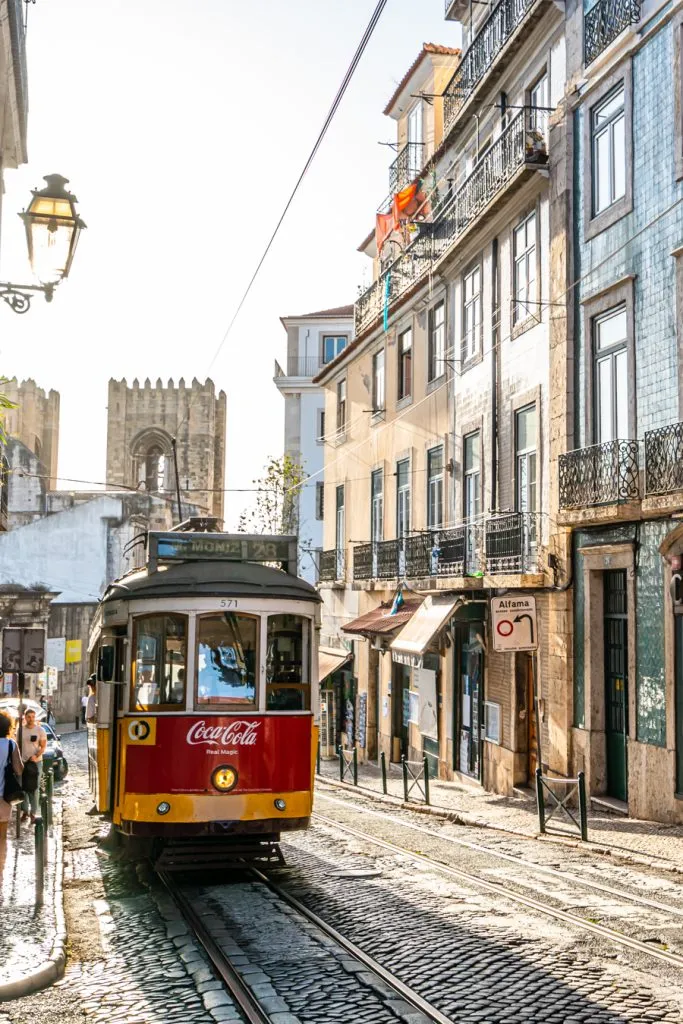
Group your sightseeing by neighborhood.
Many of the Lisbon neighborhoods that travelers like to visit on their first trip to the city are quite spread out from each other.
This is especially true for Belém, which feels completely separate from Lisbon’s center despite being home to some of the city’s most popular attractions.
When planning a trip to Lisbon, be sure to note which attractions are near each other and plan your days based on geography.
For example, planning a day in Lisbon that includes visiting the Castelo de São Jorge, the Jerónimos Monastery, and the Carmo Convent back-to-back is a frustrating strategy.
Our recommended 3 day Lisbon itinerary conquers the city neighborhood by neighborhood, making it easier to see more with less time!
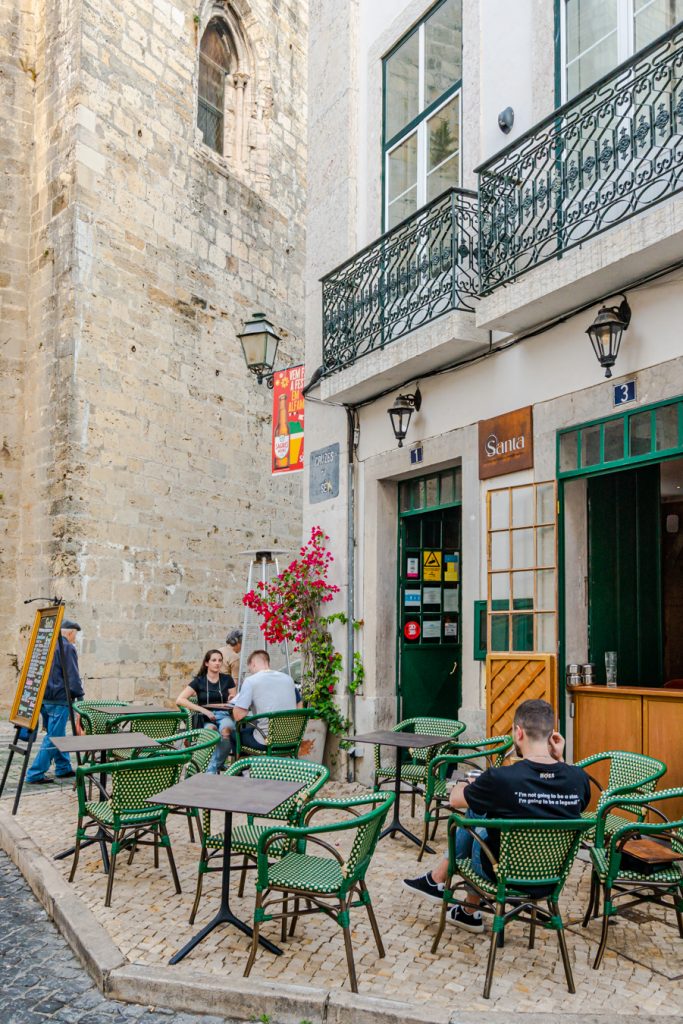
… and start at the highest point.
Climbing steep hills is an unavoidable fact of life when visiting Lisbon, but you can give your knees a break by starting at the highest point in any given neighborhood!
A couple of destinations that make great starting points to head downhill from include the Miradouro da Graça, the Miradouro de São Pedro de Alcantara (one of our favorites in the city), and the Castelo de São Jorge.
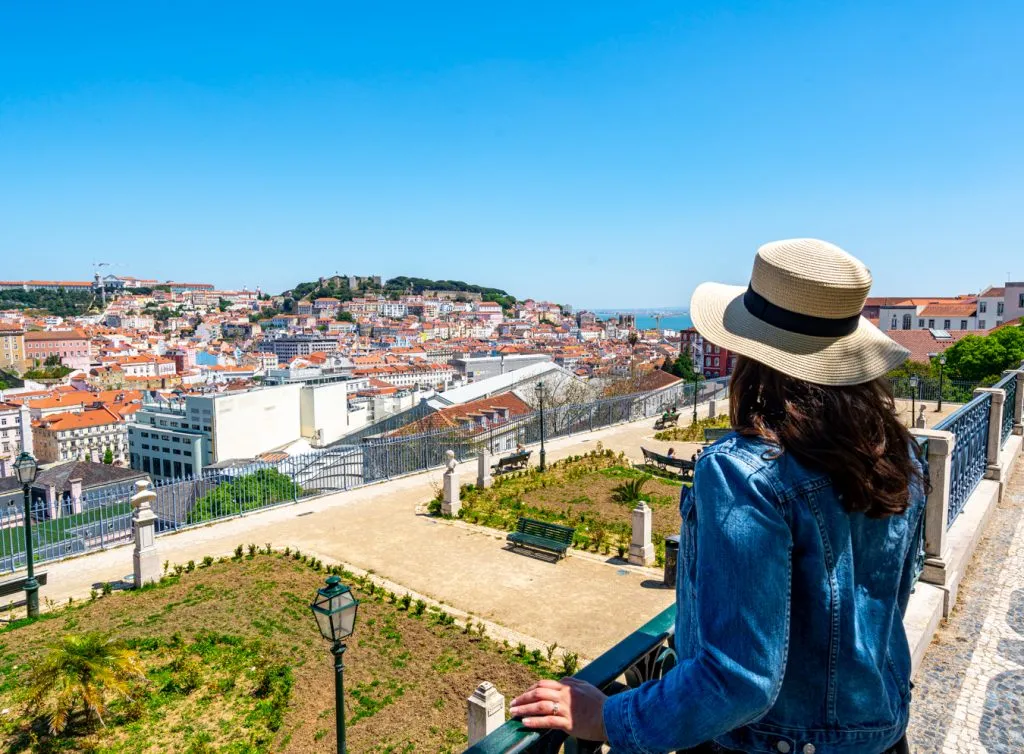
Don’t expect an interior when visiting Castelo de São Jorge.
Lisbon, and Portugal in general, is lousy with opulent palaces built and decorated to the hilt throughout the centuries… but the famous Castelo de São Jorge is not one of them.
Today, the castle is famous for its views and for the fact that you can stroll around the top of its ramparts, soaking in the views and imagining what once was as you do.
Though the hill that Castelo de São Jorge sits atop is incredibly important to the history of Portugal (to start with, the country was founded on this spot in 1143 when the Portuguese conquered the city from its Islamic rulers), the actual structure on the hill has been rebuilt many times.
That’s not to say that the castle isn’t worth visiting, but don’t expect details like throne rooms or furnishings here (there are, however, lots of peacocks).
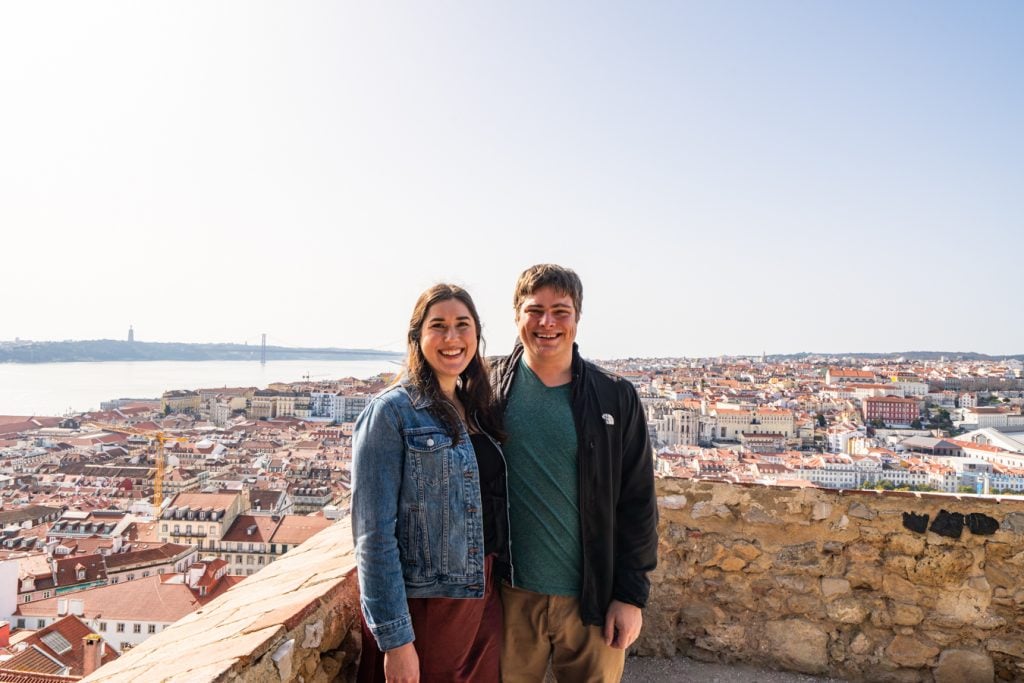
Picking a neighborhood and wandering is a great way to visit Lisbon.
While targeted sightseeing is a must if you want to experience the best things to do in Lisbon in a short amount of time, be sure to leave plenty of time in your schedule for wandering, too!
Lisbon’s many neighborhoods are a delight to explore on foot.
Beautiful areas like Alfama, Chiado, Bairro Alto, Belém , Cais do Sodré, and Baixa are lovely, and you’ll no doubt experience them when visiting Lisbon.
If you want to go a bit further afield to wander, though, consider also sampling Campo de Ourique (don’t miss the beautiful Prazeres Cemetery), Estrela (the Jardim da Estrela will forever be one of our favorite places in Lisbon, and the basilica is stunning too), Arroios, Príncipe Real, and Graça.
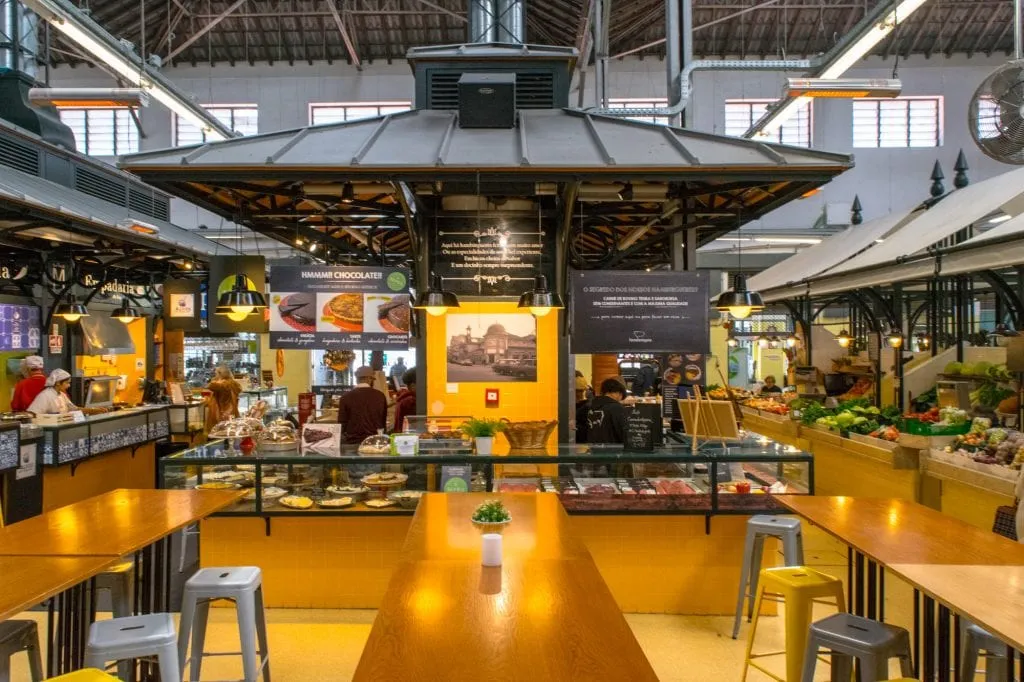
A sailboat cruise on the Tagus is a great travel experience in Lisbon.
The views of Lisbon from the Tagus are wonderful, and there’s nothing quite like experiencing the city from the water.
Lisbon’s history and culture are deeply tied to the Tejo and to the wide open sea that lies beyond it, and relaxing on a sailboat is a fantastic addition to any visit to Lisbon.
Plus, it’s simply lots of fun, and more affordable than you might expect!
Most Tagus River cruises leave from Belém, and you can easily add a cruise to your time there.
Personally, we’re partial to sailboat cruises (as opposed to large tourist boats), and if you can arrange your Lisbon trip so that you can enjoy the Tagus at sunset, all the better.
Book your Lisbon sailboat cruise today!

Most Lisbon churches are free to visit, so be sure to step inside!
While the Lisbon Cathedral and the Carmo Convent (though that one is a museum rather than a working church today) have modest entry fees, virtually every other church in Lisbon is free and easy to enter.
That even includes the stunning Church of Santa Maria de Belém that is attached to the popular Jerónimos Monastery (which holds the tomb of Vasco da Gama, among others).
Some of my favorite churches in Lisbon to visit include the Church of São Domingos, the Church of São Roque (a must for anyone who enjoys over-the-top opulent churches), and St. Anthony’s Church (don’t miss the crypt).
The Lisbon Cathedral is a bit controversial among travelers: historically important and rebuilt several times, the interior is much plainer than many expect, especially considering it is one of the only churches in Lisbon to charge an entry fee.
It’s beautiful, but very different in style to most in the city–if you’re on the fence about it or short on time, you can skip it.
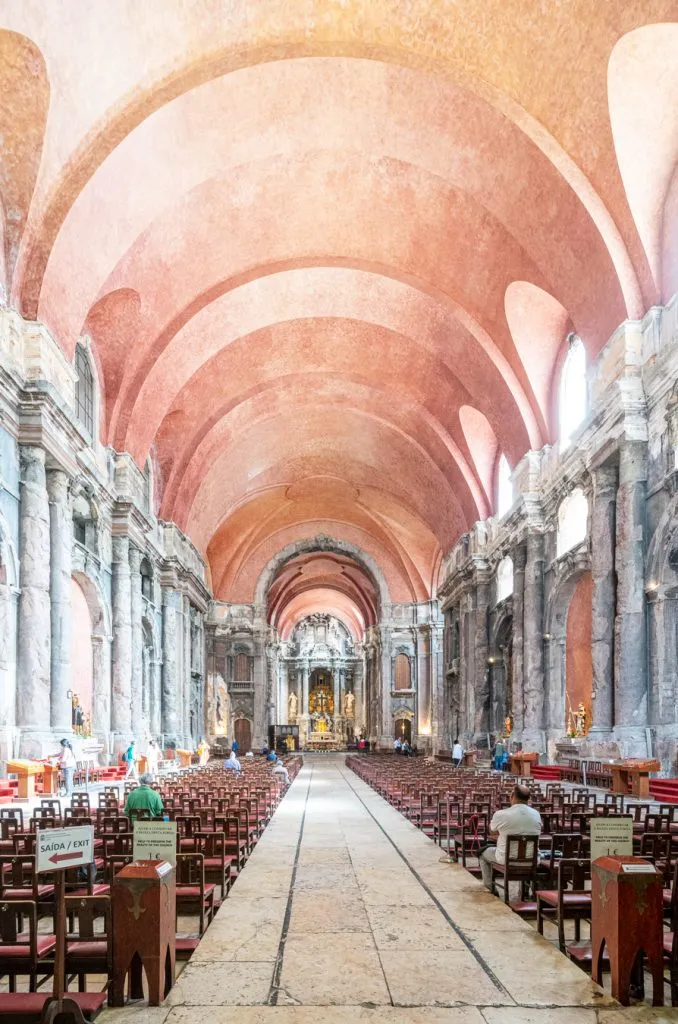
Don’t expect to be able to walk everywhere.
While Lisbon’s various neighborhoods tend to be very walkable in their own right, the city as a whole is fairly dispersed.
You’ll need transportation other than your own feet to travel between many neighborhoods–and luckily, Lisbon has plenty of options!
Lisbon’s taxis are generally plentiful and very easy to use, trams of course are popular, and the metro goes to a fair number of places, too (including the airport, though taking a taxi into the city is faster).
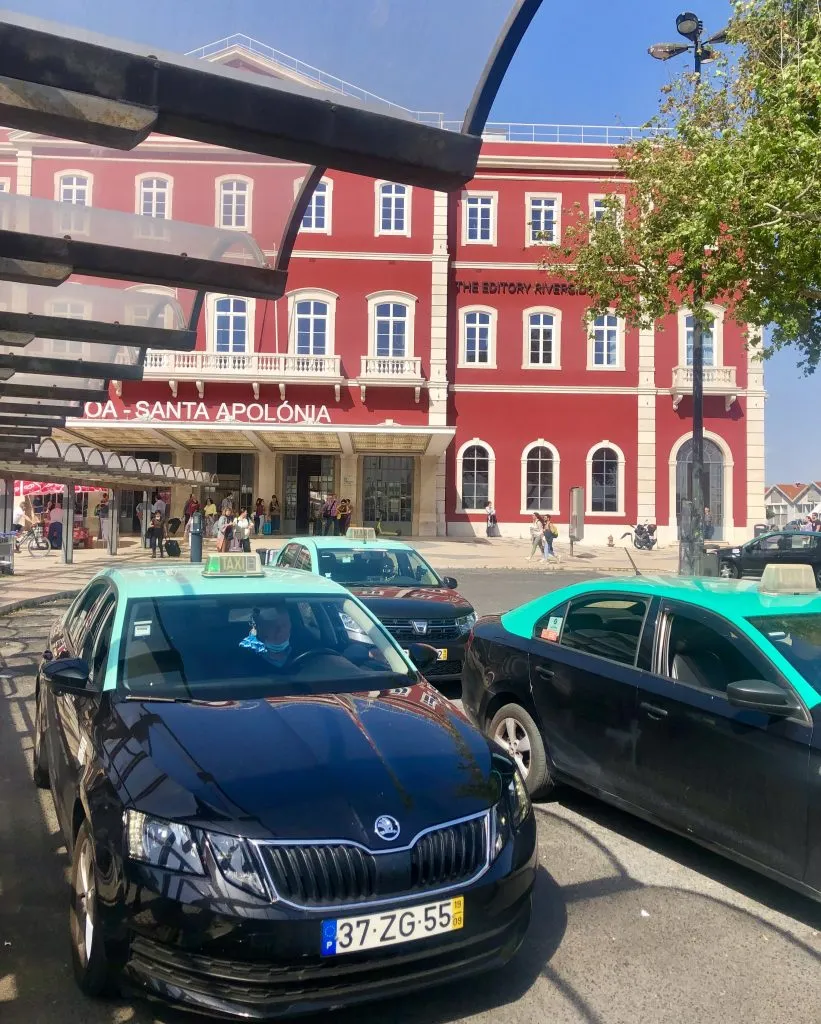
We’re not exaggerating about the hills.
You will absolutely get a workout when visiting Lisbon for the first time and sampling the city’s major sights!
Opt for very comfortable, sturdy shoes with a grip on them, and be prepared to work for your views.
If you’d like to avoid climbing many hills, structure your days carefully and budget for plenty of taxis (rates start at 3.50 and we regularly travel across the city for under 10 Euro).
Lisbon’s funiculars, Bica, Glória, and Lavra (the last being the least touristy) can also help out with the steep climbs in a few places.
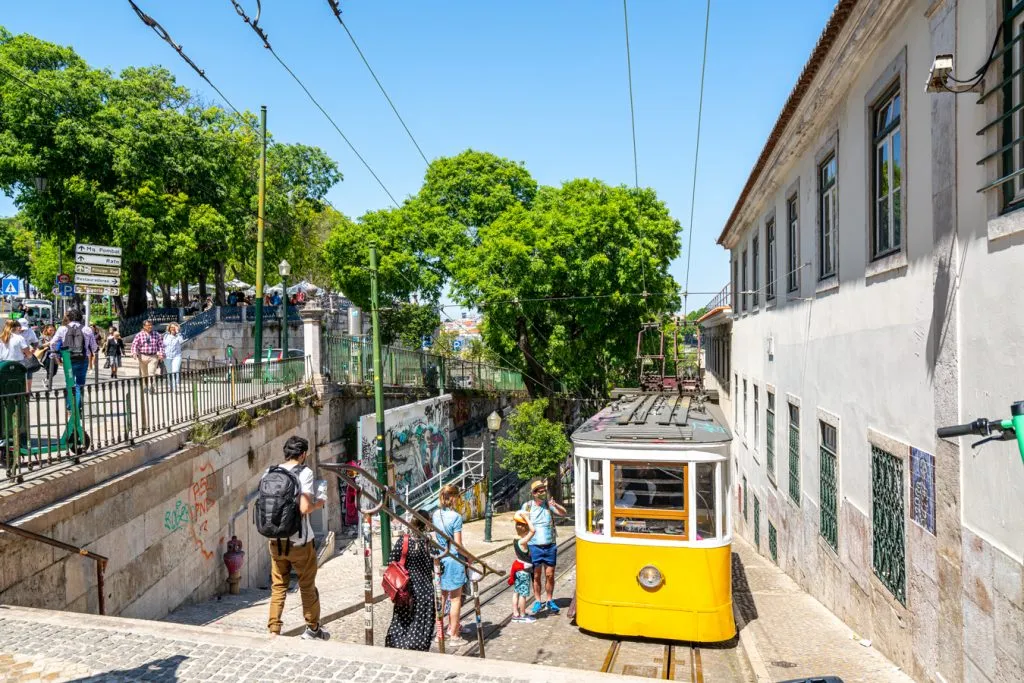
The fastest way between Baixa and Chiado is through H&M.
Funiculars aren’t the only way to shave a climb off your route!
The multi-story H&M store on Rua do Carmo has a series of escalators that make for an excellent shortcut between the neighborhoods of Baixa and Chiado, each of which is home to some of the top things to do in Lisbon.
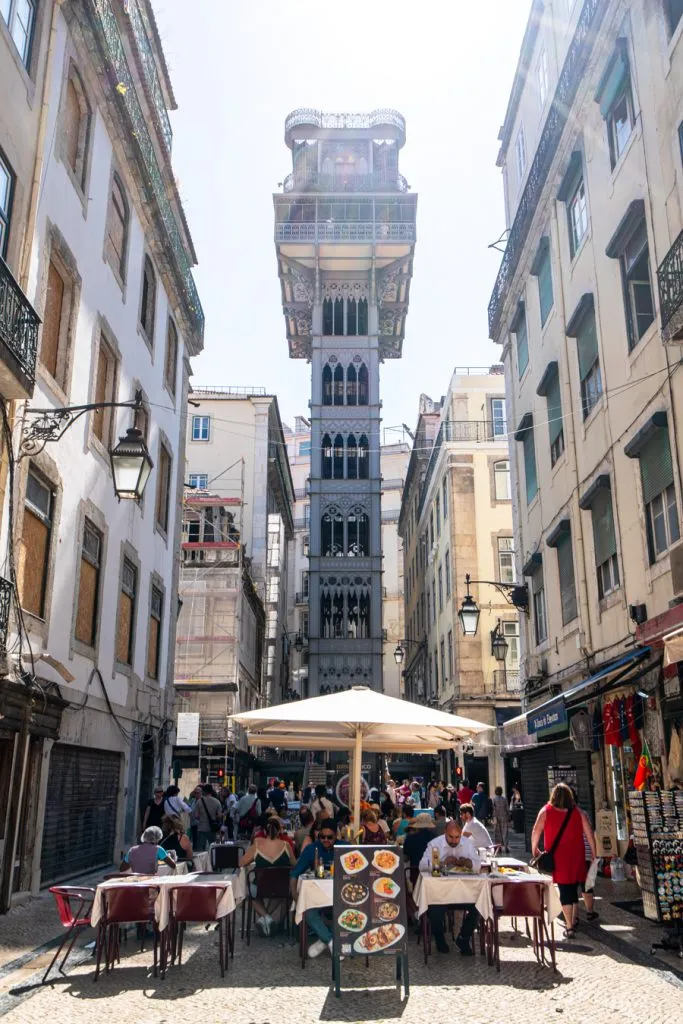
Tram 28 is not necessarily the best way to get around the city.
Long ago, someone wrote that riding Lisbon’s classic Tram 28 was a cheap, easy, and local way to see the best of the city.
This was undoubtedly great advice at the time, but it’s long outdated.
True, the Tram 28 route only costs 3 Euro (or is included with a Lisbon Card ), and trundles right past many of Lisbon’s top landmarks, including past the Praça do Comércio, through Alfama, right by top viewpoints like the Miradouro de Santa Luzia, and more.
On the other hand, it’s ridiculously crowded, the best views of the tram are actually from the outside, and it’s a bit of a magnet for pickpockets these days.
If you love trams, it may be worth riding for the experience–but if you just want to get across Lisbon, there are plenty of other ways to do so.
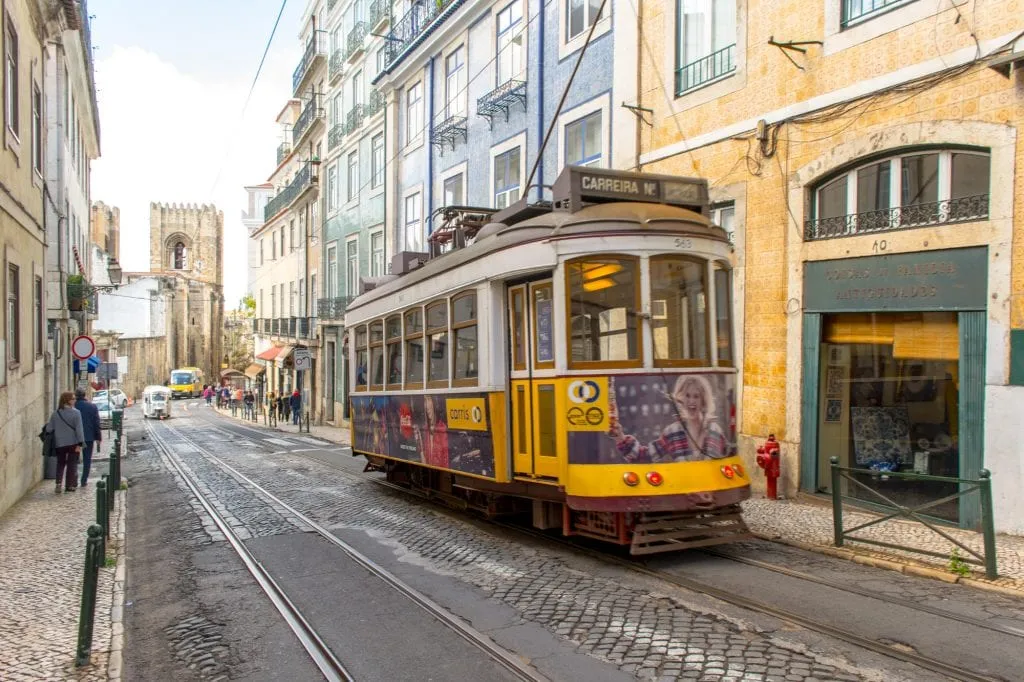
Taxis are the fastest way to get to the city center from the airport.
There’s a well-organized taxi stand right outside of the arrivals hall at the airport, and it’s the fastest way into the city.
Riding the metro is also doable and more budget-friendly, but it takes quite a bit longer.
Unlike some cities, there is no set fare for a taxi ride from the Lisbon Airport (technically named the Humberto Delgado Airport or Portela Airport) to the city center, however, the fare should run roughly 15 to 20 Euro.
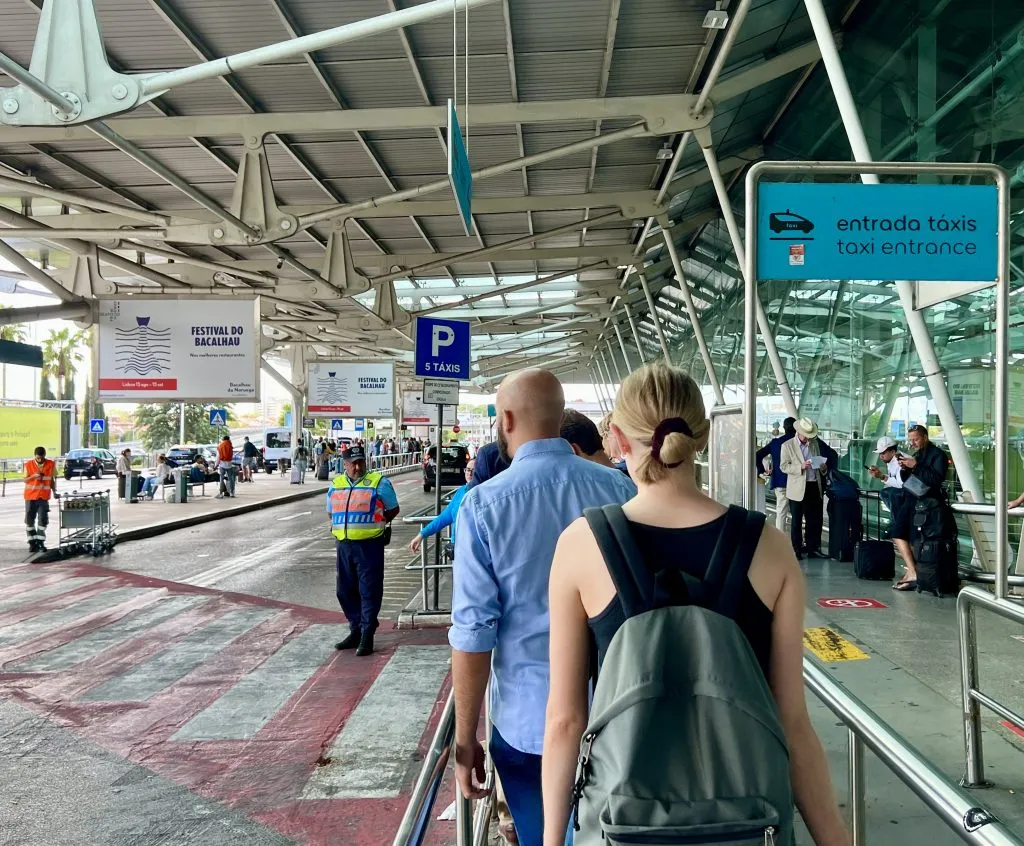
Download FreeNow for calling taxis.
FreeNow isn’t specific to Lisbon, but we use it here all the time!
Think of this app as Uber for official taxi rides.
It’s popular in many cities across Europe and comes in very handy both in Portugal and beyond.
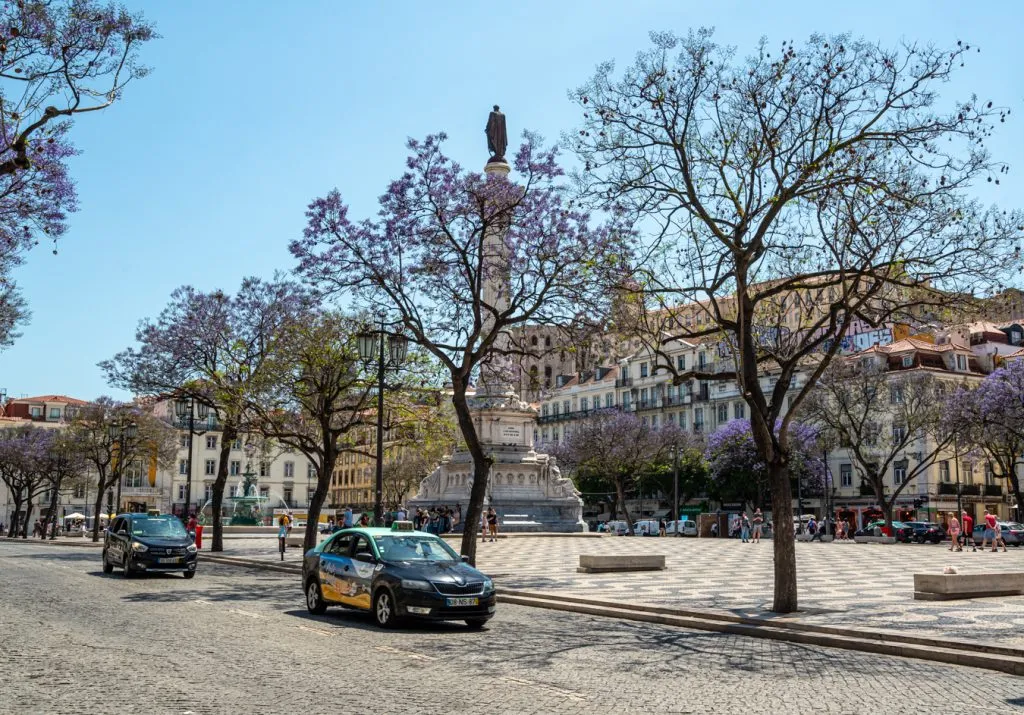
Sintra is wonderful, but it’s not Lisbon’s only day trip option.
When you’re planning a trip to Lisbon, you’ll no doubt hear about a thousand times that you have to take a day trip to Sintra.
Located less than an hour outside of Lisbon, Sintra is a beautiful place, filled with interesting and sometimes downright bizarre palaces.
Once a retreat for wealthy people ranging from Portuguese royalty to British aristocrats to an American socialite, Sintra’s palaces are well worth visiting.
… but they’re also very crowded, and far from the only day trip worth taking from Lisbon!
Honestly, I believe that Lisbon has better day trip options than the vast majority of European cities because there is simply so much variety!
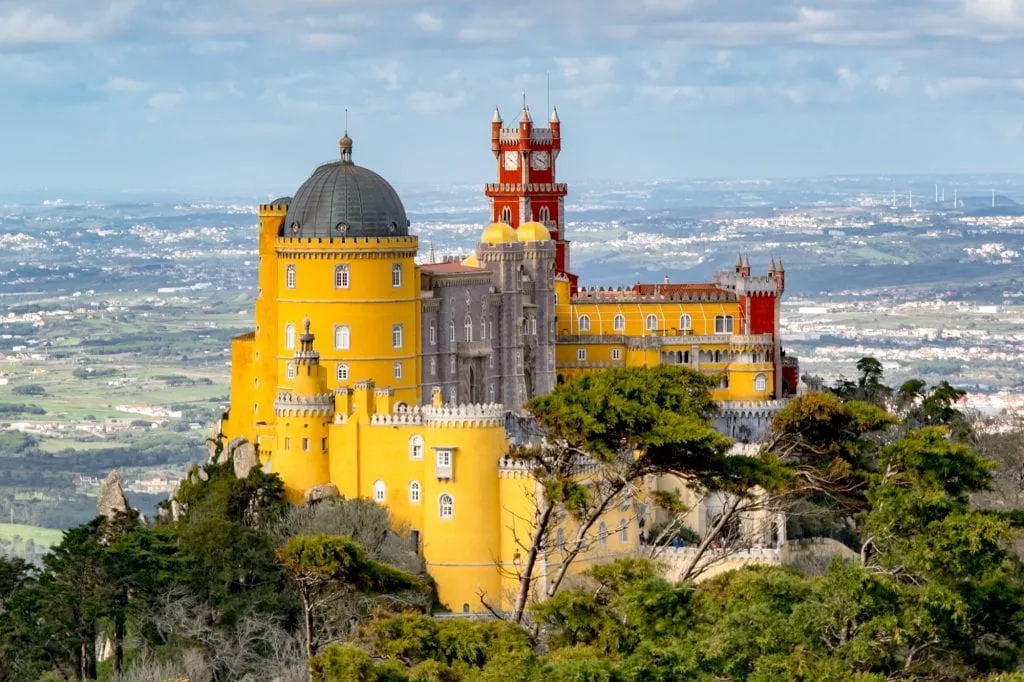
Want a beach town? Go to Cascais.
A stunning hike along the coast? Arrabida Nature Park.
The most beautiful monasteries you’ve ever seen? Alcobaça Monastery, Batalha Monastery, and Tomar’s Convent of Christ are waiting.
A medieval town to explore? Go walk the walls of Óbidos .
I could keep going, but essentially, don’t default to Sintra when planning a trip to Lisbon if another kind of day trip appeals to you more.
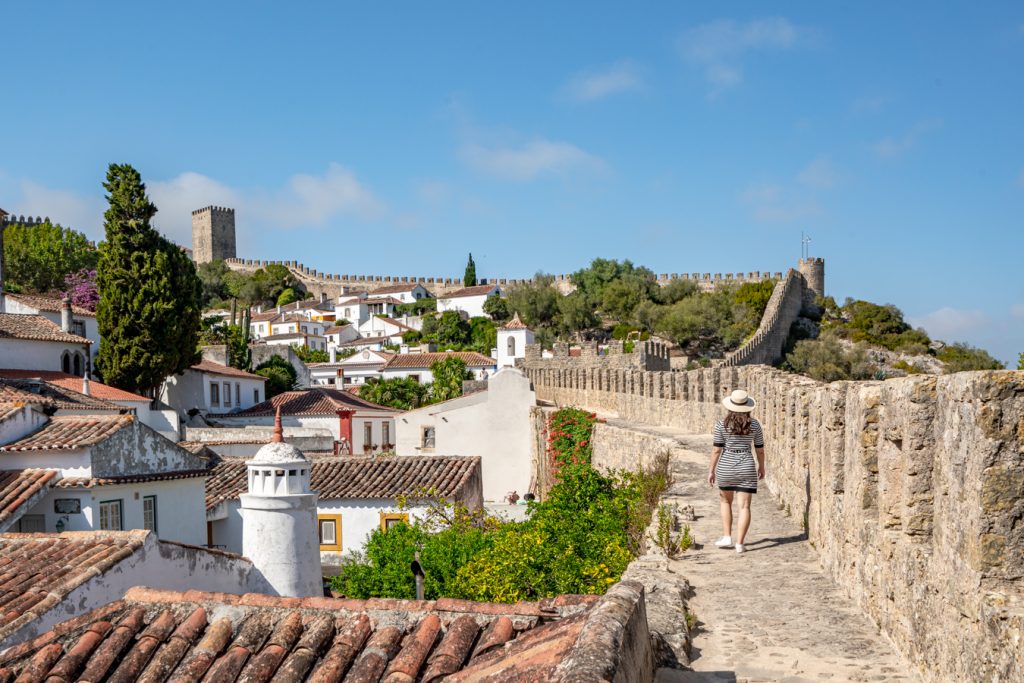
Lisbon has more than one train station, so double-check which one you need.
If you’re planning to travel away from Lisbon by train, whether on a day trip or further afield, be sure to check which station you need to leave from!
For example, most trains running from Lisbon to Porto leave from Santa Apolónia Station, while trains to Sintra leave from Rossio Station and trains to Cascais leave from the Cais do Sodre Station.
None of these stations are particularly far from each other, but you don’t want to end up heading to the wrong one during your Lisbon travels!
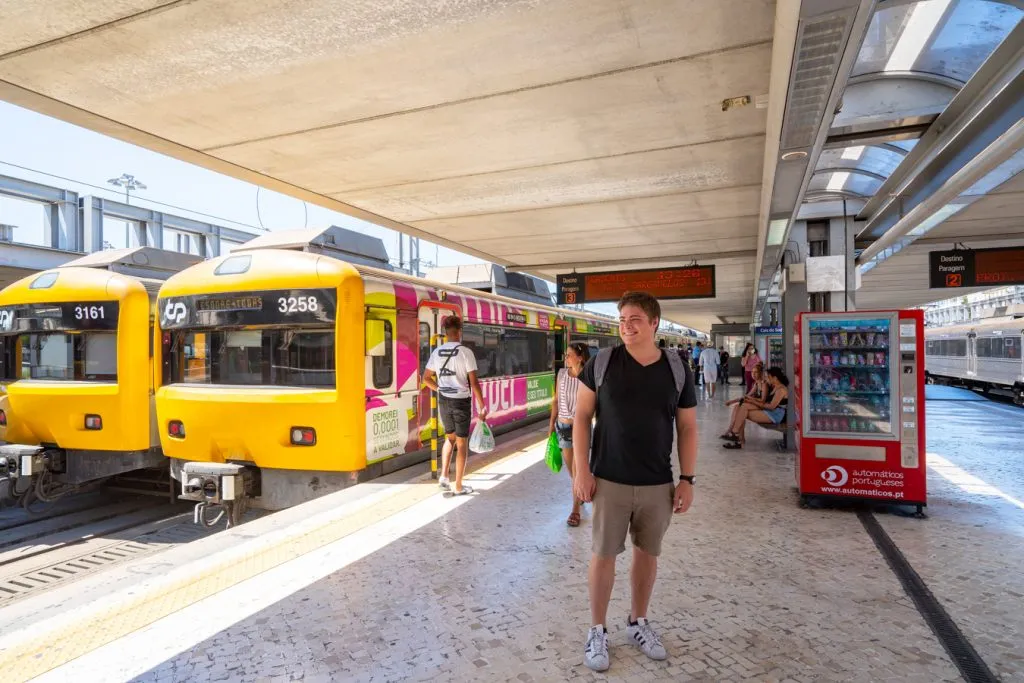
Trains are excellent, but taxis are often faster.
For many of Lisbon’s nearby day trips, a great compromise–especially when traveling with a group–between the comfortable but often slower trains versus the hassle of parking a rental car can be to take taxis.
You’ll spend a bit more, but you’ll often save quite a bit of time, too!
For nearby spots like Cascais and Sintra, we’ll often take the train on the way to our destination, and then call a taxi or Uber to go home when we’re ready.
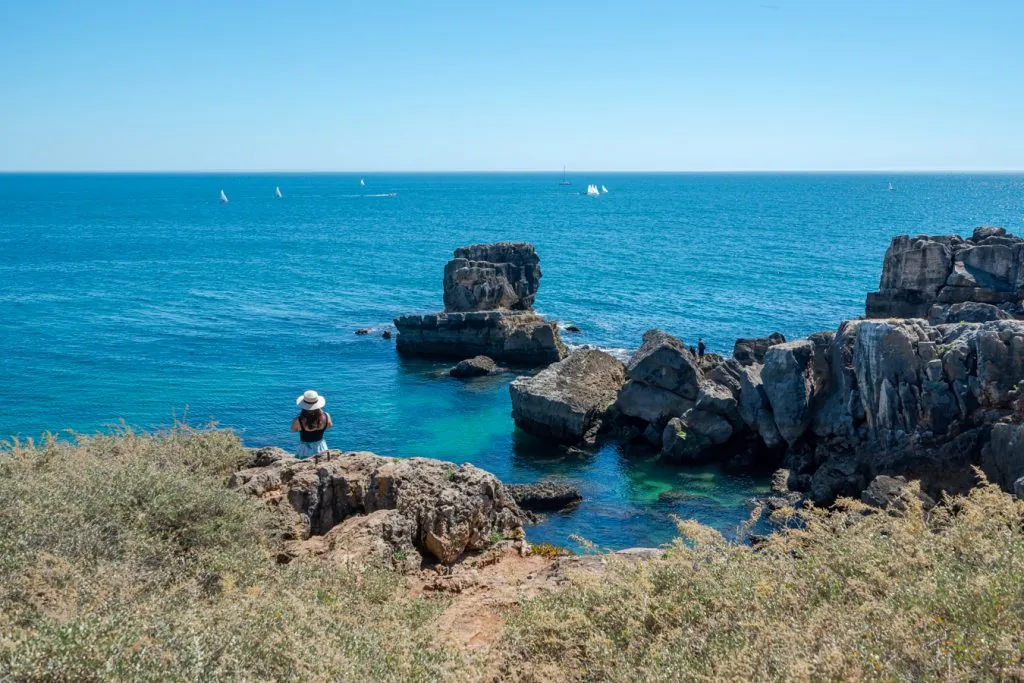
Not all trains have a/c, and they often trap heat.
… and when the trains do have a/c, it isn’t necessarily strong enough to cool the trains down to a comfortable temperature!
Lisbon tends to have fairly mild weather, so this isn’t often a problem, but if you happen to be visiting during a heat spell in the summer, keep it in mind when planning day trips.
On hot, sunny days, it can be hotter inside a running train than it is outside.
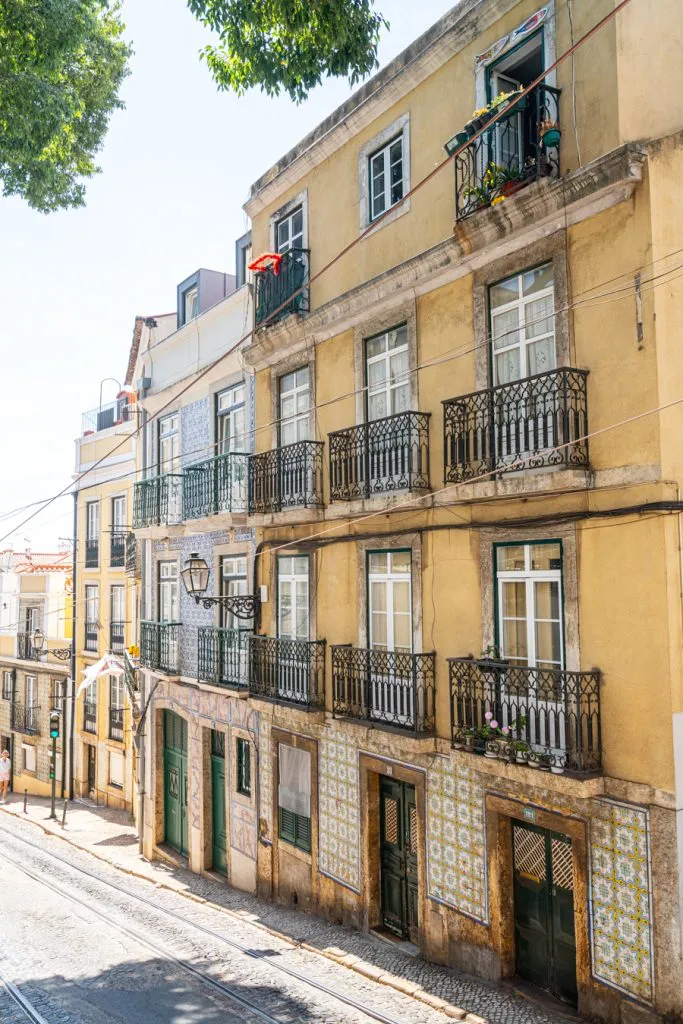
Don’t plan a day trip to Porto.
We know that trying to decide whether to visit Lisbon or Porto is a hard choice–and we love them both.
Resist the temptation to plan a day trip between them, though!
Even on a high-speed train, the 2 cities are simply too far apart to be good day trips from each other, especially because there are dozens of other worthy places to visit within an hour or 2 of each city.
(That being said, we have received enough questions about this that we have put together a guide on how to take a day trip to Porto from Lisbon for travelers who are determined to go!)

There aren’t beaches within walking distance of Lisbon’s center, but you can reach them.
Despite being located temptingly close to the water, there aren’t beaches in Lisbon’s city center (technically there’s a tiny patch of sand in front of Praça do Comércio at low tide, but it doesn’t really qualify as a beach).
You can reach the many beautiful beaches near Lisbon fairly easily, though!
Costa da Caparica, Estoril, Sintra, and Cascais all have wonderful beaches to choose from.
For a large, tried and true beach very close to Lisbon, Praia de Carcavelos is a local favorite.
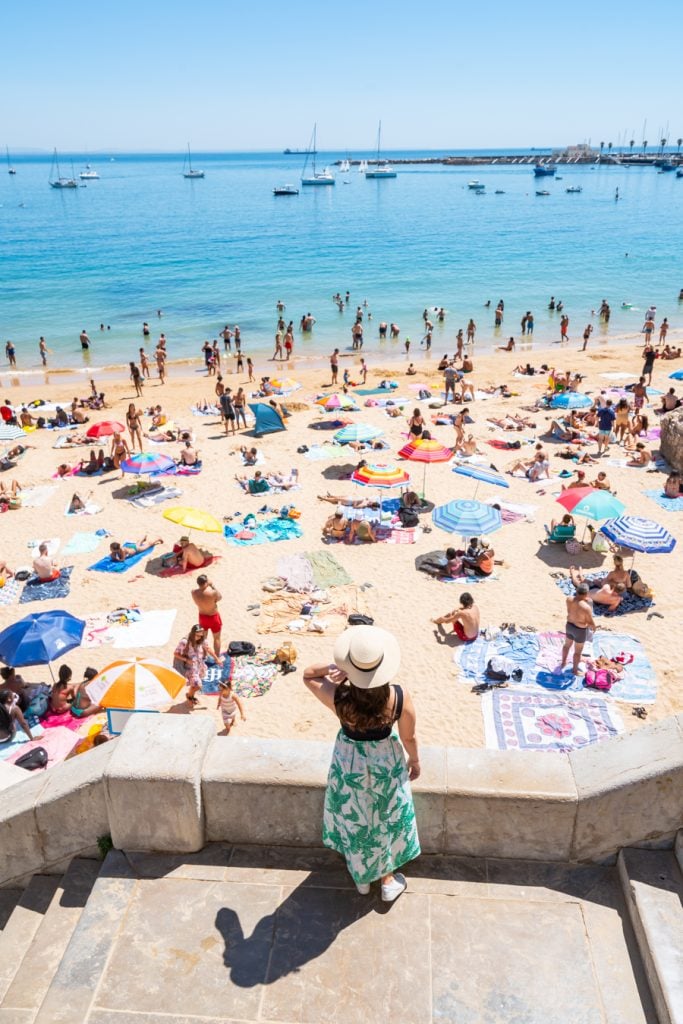
A food tour is absolutely worth the effort when visiting Lisbon.
We’re big proponents of food tours around the world: combining traditional local food with a chance to take a walking tour of a city is a fantastic way to get acquainted with a new place!
We’ve taken a few Lisbon food tours over the years, all wonderful, but on your first trip to Lisbon, there’s none that I recommend more highly than this food and wine tour .
With a convenient starting point that is very close to the Church of São Domingos, this food tour is filling, delicious, and informative.
Best of all, it focuses primarily on introducing you to classic Lisbon cuisine, which will help you with ordering in restaurants for the rest of your time in Portugal.
Perhaps the biggest endorsement we can offer is that we have returned to several of the included establishments since, including bringing our friends and family to some of them when they visit Lisbon!
Book your Lisbon food tour today!

Don’t eat a francesinha in Lisbon if you’re also visiting Porto.
There’s probably no more (in)famous Portuguese sandwich than the francesinha, which is essentially what happens when you take a croque-monseiur and ask “you know, how can we make this dramatically more unhealthy?”
Bread, ham, sausage, steak, more sausage, cheese, more bread, all smothered in a tomato and beer sauce: these are the general ingredients behind the francesinha.
The sandwich is generally served with fries and sometimes topped with a fried egg–and yes, it’s quite gluttonous.
Is it worth trying when in Portugal? Sure, once in a very long while.
If you’re also heading to Porto, though, skip the francesinha while in Lisbon.
While you can find them on menus here, the sandwich was invented and is much more common in Porto–you’ll find plenty of delicious options up there!

Be cautious with port (and ginjinha ).
Port is delicious, well worth sampling while in Portugal, and very strong.
At 20% alcohol (as opposed to around 12% on standard wine drunk in the USA), it is very easy to overindulge in port’s sweet taste without realizing it, even if you’re used to drinking.
Keep an eye out as you indulge in Portugal!
This goes for ginjinha , too (around 18% alcohol content), but as ginjinha is served in tiny cups and is treated more like a spirit, it’s not quite as easy to overdo as port is.

The key to appreciating pastéis de nata is eating them all.
More or less every bakery in Portugal has its own taking on the iconic pastel de nata , and trying a wide variety is a must when visiting Lisbon!
Some of the most popular bakeries include Pastelaria Santo António, Manteigaria, Confeitaria Nacional, Fábrica da Nata, and of course, the iconic and original Pastéis de Belém.
Everyone has their own favorites, and they can change from day to day, but you won’t go wrong with a pastel de nata (or 2, who’s counting?) from any of these spots.
Don’t forget to sprinkle the top with cinnamon and/or powdered sugar at least once!
Everyone has their own opinion on the sprinkling, too, but during your first trip to Lisbon, we’d recommend trying a bite each way.

… but at Pastéis de Belém in particular, consider getting a table.
The iconic Pastéis de Belém is known for its extremely long lines, but here’s the thing: the line for table service is generally much shorter than the one for takeaway orders!
And, as a bonus, it’s more fun to eat in the dining room!
The interior is spacious, allows you to order a drink, and the building itself is also fun to walk through (you may even catch a glimpse of people hard at work in the kitchen cooking up an endless number of pastéis de nata ).
Alternatively, if you are visiting Lisbon for a longer period of time and aren’t squeezing lots of attractions into each day, consider heading to Pastéis de Belém on Mondays, when the nearby Jerónimos Monastery is closed and therefore the Belém neighborhood as a whole is much quieter.
We once waited less than 5 minutes for a box of pastéis de nata to takeaway when visiting on a Monday!

Make reservations for dinner.
When it comes to dinner, Lisbon is a city that loves its reservations.
If you have your eye on eating in a particular place, be sure to make a reservation in advance!
Generally, reserving a table the day before or even during lunch service the day that you plan to eat dinner there is fine.
However, if you have somewhere particularly popular in mind or if you’re heading out on a weekend, consider booking a bit further in advance.
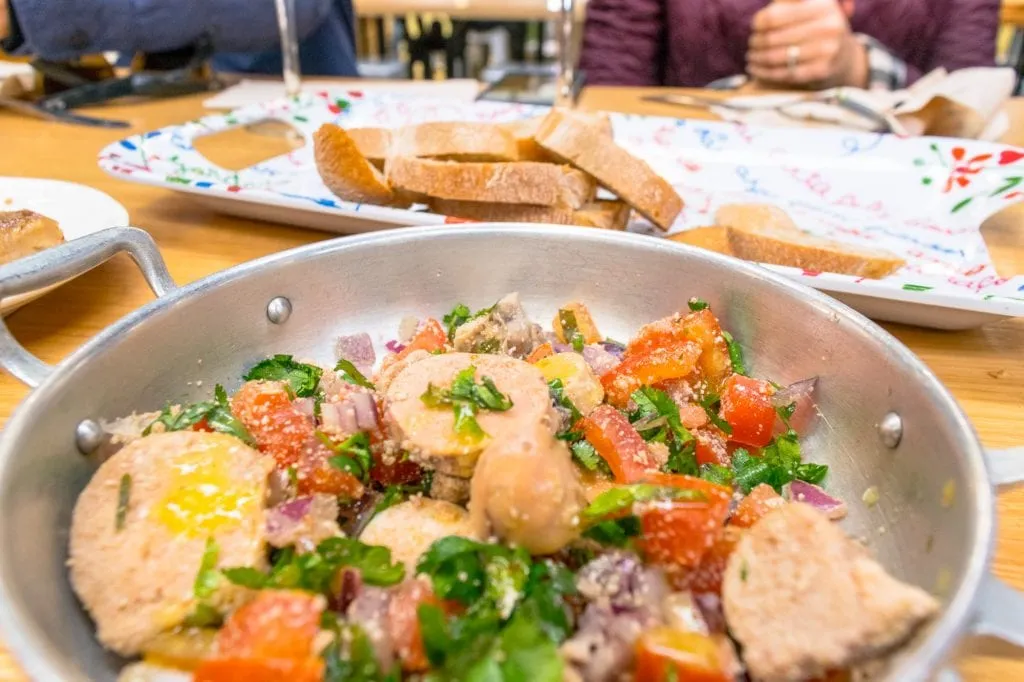
… and don’t plan to eat early.
People in Lisbon don’t eat as late as, say, those in Madrid , but they still tend toward eating on the late side!
Most restaurants open for dinner around 7:00 PM or 7:30 PM, and they won’t really start to fill up until after 8:00 PM.
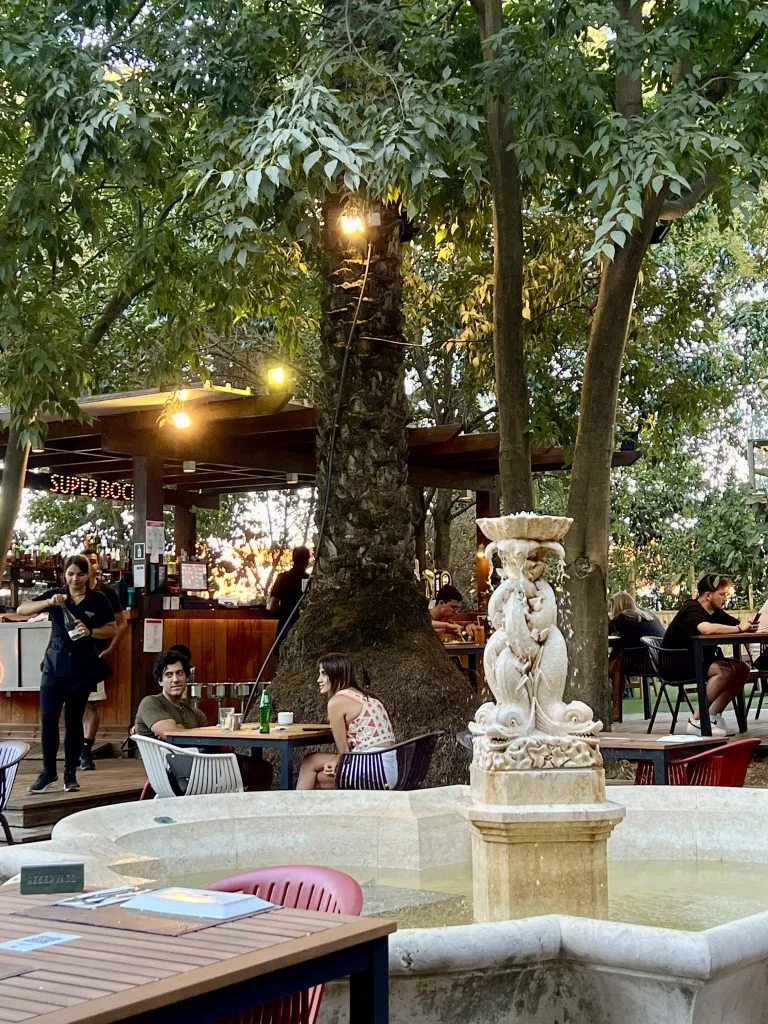
Bring very sturdy shoes.
Not only does walking in Lisbon require climbing lots of hills, but it’s also a bit hard on your feet in other ways.
The distinctive Portuguese pavement (or calçada portuguesa ) that you’ll see throughout the city offers its challenges: these walkways are both beautiful and a bit of a hazard in the rain.
Here’s the thing… they’re incredibly slippery when wet, especially if they happen to have fallen leaves sitting on them.
Watch your step, especially on hills, and opt for shoes with some grip on them!
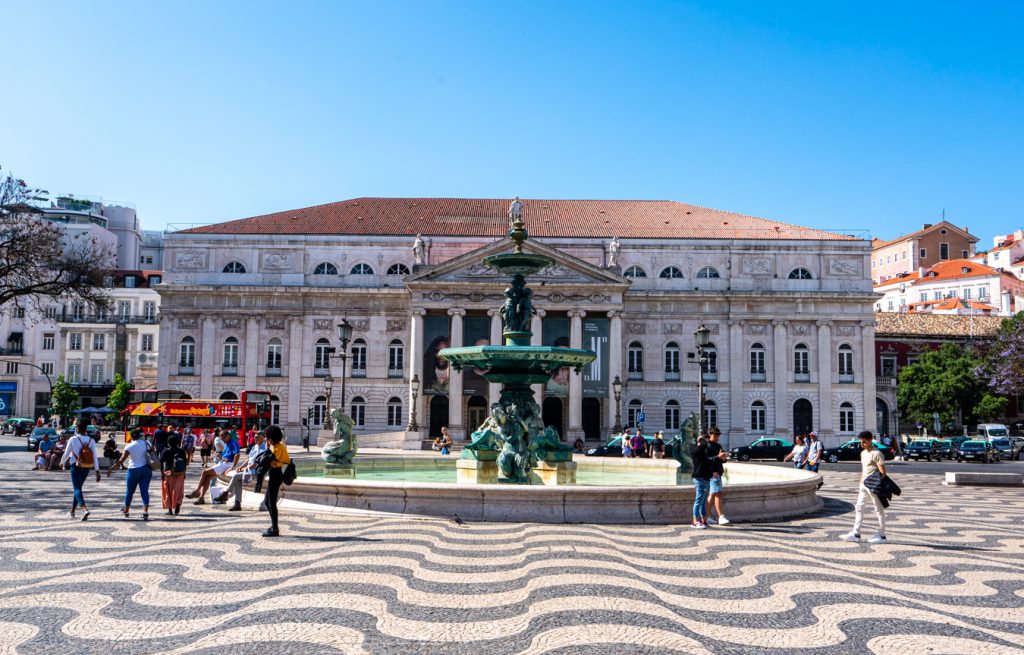
When it doubt, take a ticket.
In Portugal, it’s very common to use a ticket-based system rather than a traditional line/queue in order to serve customers.
If you see several people standing around in a shop, look around for a ticket machine: that’s how you wait your turn.
You’ll see this everywhere from train stations to butcher shops to banks when visiting Lisbon, Portugal.
Don’t stay in Bairro Alto or Cais do Sodré unless you’re looking for nightlife.
Bairro Alto and Cais do Sodré are popular, centrally located neighborhoods with plenty of hotels and hostels… and they’re also the center of much of Lisbon’s nightlife.
If your value peace and quiet after dark, these are not the right neighborhoods for you to stay in!
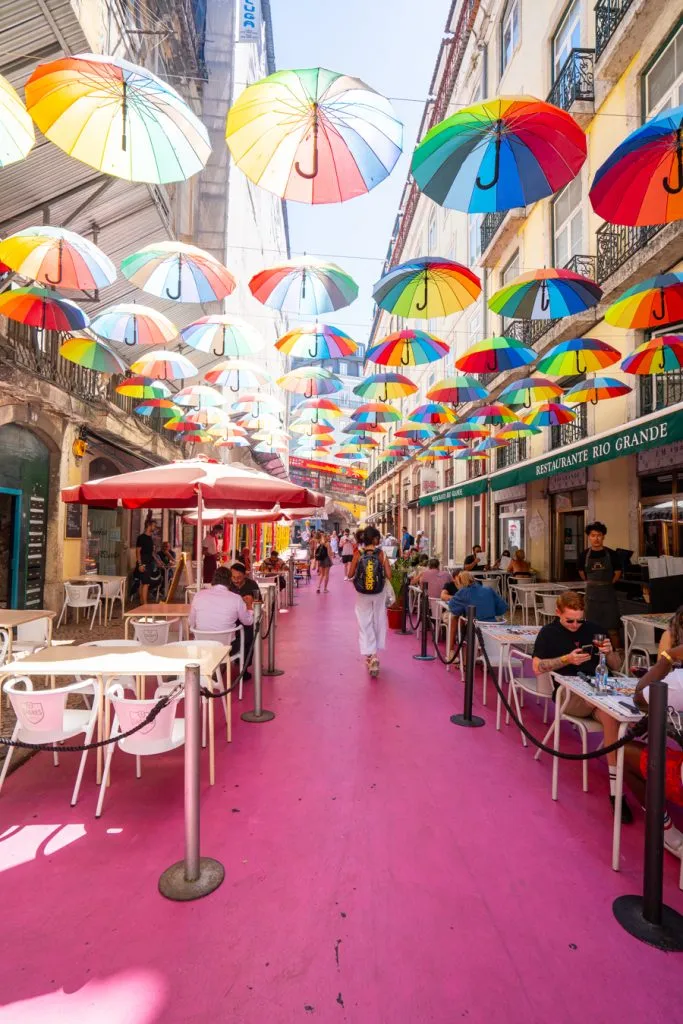
Make note of whether your hotel has air conditioning and/or heat.
Lisbon’s typically mild climate means that not all hotels (especially budget hotels) have air conditioning or heat–but you may want it!
That’s not solely because of temperature control, either.
For example, Lisbon struggles with dampness, mildew, and mold in many of its buildings over the winter months.
It’s not a huge problem for visitors, but if you’re concerned about dampness in your room or you have allergies, it’s best to keep it in mind when deciding where to stay in Lisbon.
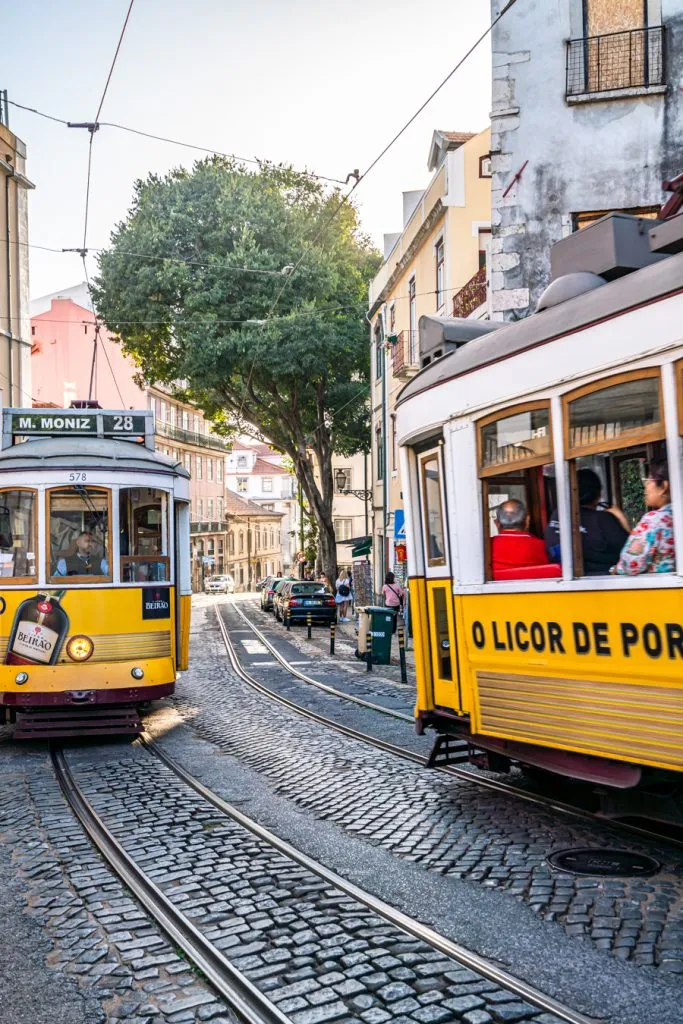
Learn a few Portuguese phrases before visiting Lisbon.
While you’ll find plenty of English speakers in the city, it’s still a good idea to learn a few Portuguese phrases before your trip to Lisbon!
Not only is it polite, but it can also be helpful (in our experience, taxi drivers, for example, rarely speak English in Lisbon).
A simple por favor (please) and obrigado/obrigada (thank you from a male speaker/thank you from a female speaker) can go a long way when visiting Lisbon!

About Kate Storm

In May 2016, I left my suburban life in the USA and became a full-time traveler. Since then, I have visited 50+ countries on 5 continents and lived in Portugal, developing a special love of traveling in Europe (especially Italy) along the way. Today, along with my husband Jeremy and dog Ranger, I’m working toward my eventual goal of splitting my life between Europe and the USA.
8 thoughts on “33+ Important Tips for Visiting Lisbon for the First Time”
Nicely done, I appreciate you have some uniques tips here compared to other blogs (the one about being careful on the Portugese pavement was very helpful). Thanks!
Thanks, Justin! Hope you have a great time in Lisbon. 🙂
One of the best blogs out there. Thank you for the wealth of information.
That’s great to hear, thank you! Hope you have a great time in Lisbon 🙂
What a wonderful source of information — thank you! My girlfriend and I are planning a trip to Lisbon in March. It’s our first time there and we’re wondering what part of the city is best for our accommodation. We plan to do lots of walking and would like to be pretty central. I spotted something interesting in the old part of the city and wonder if that might be a reasonable location. Any advice would be SO appreciated!
Thanks so much, Susanna!
As far as where to stay, there are lots of good options. We go over the neighborhoods in a bit more detail on the “where to stay” section of our itinerary posts: https://www.ourescapeclause.com/3-days-in-lisbon-itinerary/
Short answer: Baixa is by far the most accessible (central, lots of transport options, easy to get around), but it is also the most unapologetically touristy area. Alfama, the more traditional old town, is beautiful and central but not quite as convenient transport-wise due to the steep hills. Chiado is great if you want something close but not *too* close to the action, and Bairro Alto is best if you’re planning to join in on the nightlife (ie, don’t mind noise).
Hope you guys have a wonderful trip!
Thank you so much for all your helpful articles about Lisbon! By the way, do you know if we can get a bus from Oriente to Fatima? Since we’re going on a holiday, how do we book tickets in advance? Thank you!
As far as I know, buses to Fatima leave from the Sete Rios train station, so you’ll first need to travel from Oriente to Sete Rios before hopping on the bus.
You can book bus tickets in advance here: http://www.rede-expressos.pt (this is the Rede Expressos bus company website, which has an English version).
Hope you have a wonderful trip!
Leave a Comment Cancel reply
- Skip to primary navigation
- Skip to main content
- Skip to primary sidebar
The Hangry Backpacker
Go Alone. Get Lost. Eat.
Solo Travel in Lisbon
April 2, 2020 By Hangry Backpacker Leave a Comment
As the capital and largest city in Portugal, Lisbon is the perfect place for solo travel wandering to find a comprehensive sample of Portuguese culture. The streets of Lisbon are famously beautiful, but the city’s notoriety as a picturesque and cheap destination also brings millions of tourists annually.

This guide will help you check off all the top attractions in Lisbon, but it will also help curious travelers see more of the city. Solo travel is the best way to explore Lisbon, but there is still plenty to see and do when traveling with others.
Highlights of Lisbon
The real highlight of travel in Lisbon is the city itself. Lisbon doesn’t have a single, iconic landmark that attracts tourists. Aside from the century-old, bright yellow trams climbing the hills, there is not a stationary landmark which people associate with the city.
In many ways, the broad attraction of Lisbon is a bonus for travelers. Rather than clamoring their way to the front of the line for a single landmark, tourists in Lisbon come to experience more. Freely wandering the narrow, hilly streets is the best way to experience the city, and that is what makes solo travel in Lisbon the best way to explore this city.
Despite lacking a single point of interest, there are plenty of specific attractions to check out in Lisbon. And there are some to be skipped, too. These are a few of the most popular (and a few of my favorite) things to see and do in Lisbon:
Castelo de Sao Jorge
If there is a single, immobile attraction that draws the most attention, it would be the fortress of Lisbon, Castelo de Sao Jorge. This medieval hilltop castle is one of the main tourist attractions in all of Portugal and is visible from across the city (provided there aren’t any hills obstructing the view).
Castelo de Sao Jorge, ‘Saint George Castle’ in English, is more impressive from afar than it is up close. The medieval walls have a powerful appearance, but there isn’t much to see within the complex itself.

The Sao Jorge hilltop complex consists of a large courtyard, a museum, a cafe, ruins of a palace, more ruins and, of course, the castle. Oh, and there are several peacocks roaming about. The outer walls, fortress walls and towers are notably well-preserved/renovated, but that’s about it.
The best part of visiting Castelo de Sao Jorge is the view. The walls and towers of the fortress provide excellent views across Lisbon. The courtyard area has nice views of the Tagus River estuary, and it’s a nice area to find a bench and appreciate a shaded view of Lisbon.
Historically, Castelo de Sao Jorge is incredibly important. For practical purposes of visiting, however, it leaves a lot to be desired. Traveling to Lisbon and skipping the castle isn’t sacrificing much. The view may be good, but the €10 admission can be better spent elsewhere.
Belem Tower
The Belem Tower is another famous landmark of Lisbon. The 500-year-old tower is historically significant as the ceremonial launching point for many Portuguese explorations. The 100-foot-tall structure is pretty, but that’s where the positives of Belem Tower end.
Lisbon’s famous Belem Tower is another unimpressive attraction in Lisbon. It might be nice to explore if there weren’t so many people, but the tower is full of tourists and not very large. Even as a solo traveler in Lisbon, there is no way to effectively navigate and avoid the crowds.
To make the prospect of visiting Belem Tower even more bleak, it’s out of the way for tourists. Walking to the tower is a dull hour-and-a-half trek, and even public transportation takes a solid 30 minutes.
As it is, Belem Tower is essentially a dressed-up stack of old bricks. Wasting time in line to spend €6 in a small, crowded tower is not worth the effort. Solo travel in Lisbon is better spent getting lost in the old, pretty neighborhoods.
Santa Justa Lift
The Santa Justa Lift, or Elevador de Santa Justa, is just that – it’s an elevator. It’s certainly one of the prettiest elevators I’ve ever seen, but why would you ever want to waste time standing in line and then pay to go up an elevator?
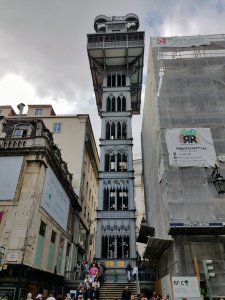
The purpose of the Santa Justa Lift is another combatant to the terrain of Lisbon. Today, it is little more than a tourist attraction. Although Castelo de Sao Jorge leaves a lot to be desired, at least it offers more than a view. Lisbon’s famous elevator, on the other hand, is a total waste of time. There are far too many free hilltop views without the need to stand in a line.
Get Lost in Alfama
Alfama is the oldest and most famous neighborhood of Lisbon. The neighborhood is home to many of Lisbon’s notable attractions. The most attractive feature of Lisbon is the city itself, and nowhere is this more evident than Alfama.
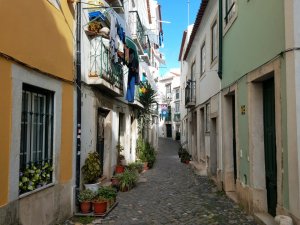
Many of the famous, identifiable scenes of Lisbon are, in fact, scenes of Alfama. This is certainly the most photogenic portion of the city, and, at times, there are crowds and tour groups to prove it. But Alfama is also one of the best places to explore for solo travel in Lisbon.
Despite the popularity and crowds in Alfama, it is surprisingly easy to get lost and find yourself alone on a quiet street. The neighborhood isn’t particularly expansive, but the wild conglomeration and mish-mash of streets means it’s easy to escape the masses of tourists. And the hilly terrain provides even more nooks and crannies to explore.
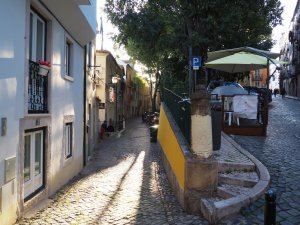
The primary drawback to Alfama is the tour groups. Like I said, it is easy to escape the crowds for more peaceful scenes, but any sense of charm or quaintness disappears when a tour group comes rolling through. These experiences strengthen my belief that solo travel is the best way to see Lisbon. The freedom of wandering alone allows you to take the time to get lost and thoroughly probe into the labyrinth of Alfama.
The Lisbon Tram
The Lisbon Tram is, today, the most iconic tourist landmark in the city. Photos of the yellow trams squeezing through the narrow streets of Lisbon have drawn a lot of attention in recent years. The trams are undoubtedly a photogenic feature of the city, and whomever is in charge of marketing tourism in Lisbon has done well promoting the scene.
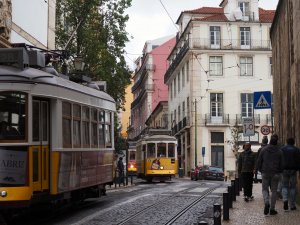
The origin of trams in Lisbon goes back to the 1800s. Today, they are largely for the benefit of tourists. The Lisbon Metro is a better choice for most locals and anyone that wants to see parts of the city far from the tourist areas.
Tram line 28 is the most famous line. Line 28 is the one that always seems to be packed full of tourists. It runs up the hills of Alfama, depositing tourists at famous stops, and modeling for photos along the way. Tram 28 is also a great way to expand your travel boundaries in Lisbon. It doesn’t traverse the city to the same extent as the metro, but it is a great way to see a large chunk of Lisbon easily, cheaply (€3) and comfortably.

Lisbon’s trams are attractive and practical. The city’s hills are a nuisance at times, and the tram is an easy way to ascend (almost) to the tops with ease. Although my preferred method of solo travel is almost always walking, riding the trams in Lisbon is kinda fun.
Mercado de Santa Clara
Shopping is not my favorite way to spend time. In fact, this is generally a thoroughly effective way to put me in a sour mood. Backpacking is different, though, especially in countries with interesting (and often tumultuous) histories. Flea markets often have a lot of peculiar stuff from these countries’ storied histories.
For me, as a novitiate numismatist, Portuguese history means interesting coins at flea markets – that is, coins of countries and colonies that no longer exist.

I thoroughly enjoy flea markets. One of the best things about solo travel in Lisbon is wandering through Mercado de Santa Clara. I don’t draw much attention by myself, and I feel like haggling is easier when alone.

In the shadow of Panteao Nacional (National Pantheon, a large church), Mercado de Santa Clara is a disorganized flea market in Lisbon. Like most flea markets, there’s plenty of junk. And there are a lot of head-scratching items, too. Who sells a large sink at a flea market?
For the most part, however, Mercado de Santa Clara is a normal flea market. In addition to all of the junk, there are local artists, clothes and smaller kitchenware, among other usual flea market goods. Flea markets are always fun places to wander, especially in countries away from home. It’s a first-hand look at life’s random things and how they differ around the world.
Mercado de Santa Clara is open two days a week, Tuesdays and Saturdays from 9 AM to 6 PM. The flea market attracts tourists but is still a local event.
Carmo Convent
It doesn’t take long in Lisbon to hear references to the massive and devastating earthquake of 1755. The earthquake caused fires, tsunamis and tens of thousands of deaths. Almost all of Lisbon was destroyed, including many famous landmarks. The rebuilding of Lisbon changed the appearance of the city, with wider streets and new, earthquake-resistant architecture.
Very little surface evidence remains of the 1755 Lisbon earthquake. The exception to that is the ruined church of Carmo Convent.
The remains of the Carmo Convent church look like a victim of modern-day bombing. The roof is gone, and all that remains are the walls and the pillars. The ruins are an interesting site to see, and when not too busy, the scene is a little eerie. Although a frightening reminder of the power and impending destruction of an earthquake, the convent is a cool place to visit and even has a decent view.
The Best Views in Lisbon
The hills of Lisbon provide more than winded travelers. They lead to viewpoints. Each viewpoint is unique, and finding unexpected viewpoints are a benefit of solo travel in Lisbon. As I climbed the hills in no particular direction, random plazas, parks and gaps in buildings appeared with excellent views of the surrounding city.
The best part of visiting Castelo de Sao Jorge is the view. The views from the fortress walls are some of the best in Lisbon. Visitors can look down upon the neighborhood of Alfama, the estuary of the Tagus river and across the river mouth to the city of Almada.

The drawback to the view at Castelo de Sao Jorge is that it costs €10 for entrance to the fortress. If you visit in the evening, and during the right season, the castle is an excellent place to watch the sunset in Lisbon. I cannot, however, in the spirit of backpacking, suggest that this view is worth €10.
Miradouro das Portas do Sol
This viewpoint is part of a popular little plaza in Alfama. It looks and functions as a sort of public observation deck, but there are also locals playing music and selling art (good luck trying to buy something).
Miradouro das Portas do Sol is free and has decent views of the surrounding neighborhood. This is a good spot to take a few minutes to catch your breath while wandering the hills of Alfama.
Miradouro de Santa Luzia
Miradouro de Santa Luzia is a short walk from Portas do Sol. Santa Luzia, though, is a little more comfortable. This viewpoint is attached to a small garden, and the ledge is ideal for taking a seat to really soak in the view.

Miradouro de Santa Luzia is one of my favorite viewpoints in Lisbon. It’s free, the surrounding garden is pleasant and the view is great. It can get a little crowded, though.
Miradouro da Graca
Miradouro da Graca has a nice panoramic view of Lisbon. The viewpoint is an excellent place to catch a sunset and has great views of the city center below. Miradouro da Graca also has the best views of the castle, especially when it shines at night.
Another paid view is found at the top of Elevador de Santa Justa. The unique view comes with a price tag and long lines. It’s a waste of time. There are comparable views nearby that are free, or, at the very least, cheaper. Find any nearby hill or balcony and there are equally impressive views.
Miradouro da Senhora do Monte
Miradouro da Senhora do Monte is probably the best viewpoint in Lisbon. It has panorama views across the city, including the fortress hill and even out to the Tagus River.
Miradouro da Senhora do Monte is usually not too busy, but crowds may gather around sunset in the high season. It is just out of the way enough to be off of most tourist radars.
Get Lost – Solo Travel Wandering in Lisbon
It’s easy to get off the tourist trail when you travel solo in Lisbon. Per usual, this is an exceedingly difficult thing to do if you’re traveling in a group. If you’re backpacking, traveling alone or if you have any free time outside of a strict group schedule, it’s easy to escape the tourist crowds without wandering all the way to the outskirts of the city.
Here are some of my favorite spots in Lisbon to wander off and enjoy a local, less touristy side of the city:
Jardim da Estrela
Estrela Garden, Jardim da Estrela, is a fascinating park in the Estrela neighborhood. The neighborhood is close to popular tourist areas but far enough away that not many visitors are willing to make the 20-minute walk.
Jardim da Estrela is like the empire park of Portugal. It is a small park full of plants (and even a few birds) that are native to parts of the once-extensive Portuguese empire. It’s like walking through an exhibition of Portuguese natural history, with trees, flowers and plants that are wholly out of place. The various species hail from India, South America, Africa and the Far East.

If you’re willing to make the walk – or simply take a tram that stops right in front of the park – there is a stunning cathedral directly across the street.
Junta de Freguesia de Campo de Ourique
Junta de Freguesia de Campo de Ourique is a neighborhood co-op, a kind of community center. While most neighborhoods/districts of Lisbon have some kind of official community center, this one in Campo de Ourique stands out.
Junta de Freguesia de Campo de Ourique is more than the home of neighborhood meetings, choir practice and crafting classes. It is a popular local hangout. Residents of the neighborhood, both young and old, gather here to socialize, eat and drink.
For travelers in Lisbon hoping to find a touch of authenticity among the tourist facade, there is no place better than this neighborhood co-op. Junta de Freguesia de Campo de Ourique is not like the community centers or co-ops with which I am familiar (in the United States). For one, they’re is a fully functional bar and restaurant. It doesn’t seem to be shrouded in politics (though I do not read or speak Portuguese), and people actually frequent the place. To me, it seems like a cool place to hang out.
Visiting Junta de Freguesia de Campo de Ourique is best as a solo travel experience in Lisbon. Personally, I wouldn’t want to encroach on their local scene with more than one or two outsiders. It is not, however, a private space, and the building is open to the public.
Neighborhoods
There are a few neighborhoods near the tourist center of Lisbon which are primarily local and infrequently visited by tourists. The following neighborhoods are great for solo travel wanderings in Lisbon to get off the beaten path without straying too far:
- Campo de Ourique – “newer” central neighborhood, great to wander with fantastic food everywhere
- Santo Antonio – near tourist center and many hotels, but there are plenty of alluring side streets
- Estrela – hilly, winding and photogenic streets with old buildings, almost like Alfama without the tourists
- Anywhere – Lisbon is a beautiful, safe city. Wandering in any direction is sure to lead to pretty buildings, local life and good food.
Eating & Drinking in Lisbon
Lisbon has an interesting culinary scene. The Portuguese empire that once had possessions in South America, Africa, India and China brought a tremendous variety of flavors back to Lisbon. These various spices, plants and cooking styles are evident in modern Portuguese cuisine.

For a thorough rundown of what and where to eat in Lisbon, check out the Hangry Backpacker’s guide to eating and drinking in Lisbon .
Other Tips for Visiting Lisbon
English is everywhere.
Don’t worry about being fluent in Portuguese. Surprisingly, English is widely spoken in Lisbon. Coming from Spain, where I was equally surprised (and pleased, personally) at how little English is spoken, it’s odd to find a place where it seems like almost everyone speaks English.
For better or worse, Portugal’s economy is highly dependent on tourism. The result is that many people in Lisbon, Porto and other popular tourist destinations in the country have a high proficiency in English.
On one hand, as a native English speaker, it makes travel easier in Portugal. On the other hand, I don’t travel to foreign countries to speak my own language. However, hearing English spoken helps in determining whether or not a place/area is touristy.
Not everyone in Portugal speaks English. Younger people tend to be more fluent. Otherwise, it largely depends on the sector in which the individual works. Those who interact with tourists are more likely to have a working knowledge of English.
As always when traveling, it’s good to know a few basic phrases. Portuguese and Spanish share words, but they are not the same. Although I picked up a few extra words, basic words like yes/no (sim/nao), thank you (obrigado/a), hello (ola) and beer (cerveja) were enough for me.
Watch Your Step
The worst part about Lisbon is the sidewalks. These damn sidewalks are a hazard (at least for me). I’ve had better traction on a slip n’ slide.
The sidewalks of Lisbon are pretty. Personally, perhaps it’s the practical American in me, I look at Lisbon’s sidewalks and see a serious waste of money and man-hours. Then again, they’re pretty and probably one of those little things most tourists love.
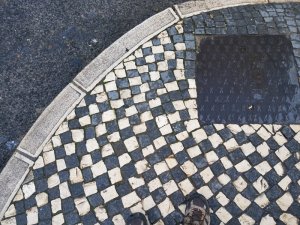
The sidewalks in Lisbon are made of limestone, which is not a tacky surface. Adding in wear and tear from millions of footsteps, the sidewalks in Lisbon are smooth and shiny. When rain enters the equation, the sidewalks in Lisbon are an absolute hazard. The hills only make it worse. Somehow, locals are conditioned to the slick surfaces and have no issues whatsoever, rain or shine.
I’m a large human, and I’m certainly not known for my agility and balance, but walking is what I do when I travel. Lisbon is a joy to walk around when it’s sunny and dry. It’s a different story when it rains. Walk carefully.
The Hills of Lisbon
I’ve alluded to the hills of Lisbon several times already. The terrain of the city is a factor to consider when visiting, especially for solo travel in Lisbon that involves a lot of walking.
Lisbon is hilly. Even when using the trams to combat the city’s hills, walking is inevitable. For travelers averse to hills, it may be best to skip Lisbon. If you can power through the winding inclines of Lisbon, the reward is worth the effort.
The best way to take on the terrain of Lisbon is to let curiosity lead the way. Most of the city is not in a grid layout. The hills of older parts of the city are covered in a cluster of streets, alleys and narrow passages that twist and turn through the neighborhoods. If a particular side street looks enticing, take a detour.
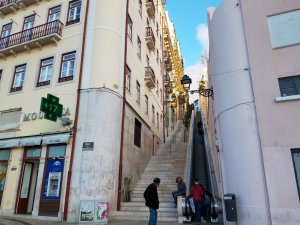
The hills of Lisbon are better enjoyed slowly exploring rather than rushing straight to the top. Travel is not a race. Take your time. Get lost. See More.
I love walking around when I travel. It’s the best way to explore a destination and thoroughly take in the surroundings. Walking up and down hills is not my preference, though. I’m a flatlander by nature. Fortunately, the hills of Lisbon make the city a unique destination and provide visitors with spectacular views and scenes.
Ignore the Drug Dealers
Portugal has infamously liberal laws regarding drug use. Whether or not that is the reason there are so many sketchy people trying to sell drugs is a debate for someone else. As a traveler, it’s annoying.
This may be one of the drawbacks of solo travel in Lisbon, or perhaps it is merely a part of being a backpacker in my 20s. For my part, I can honestly say that more people attempted to sell me drugs in Lisbon than anywhere else in the world. And that includes American music festivals!
The drug dealers in Lisbon are brazen, to say the least. They sell everything from weed to heroin. The good news is, however, that they are generally harmless and easy to deal with (no pun intended).
Most of the drug peddlers in Lisbon will leave you alone if you decline or ignore them. If you appear interested at all, perhaps even if you’re merely caught off guard, they may offer a time or two more and attempt to talk to you. Keep walking. These sketchy dudes aren’t going to waste their time on most people.
If, for some idiotic reason, you decide that enhancing your travels sound like fun, know that you’re making a mistake. A backpacker at my hostel in Porto bought a bag of weed off the street. He was really pissed when his €20 got him a bag of green cooking herbs.
I don’t understand the allure of drugs abroad. If you want to do something stupid, do so in the comfort of your own home home. Or go to Amsterdam! As a general rule in the tourist areas of Lisbon, ignore anyone that approaches you.
Getting Around – Transportation in Lisbon
Getting around Lisbon is easy enough. Everything is pretty straightforward. From a safety standpoint, Lisbon is quite safe for pedestrians and safe for individuals roaming at night (who practice normal caution).
Walking/Biking
Walking is an adequate way for most tourists to travel around Lisbon. In the touristy areas, everything is close together. Travelers of average fitness can walk to most of the popular landmarks in Lisbon with relative ease. The only real challenges are the hills and slippery Lisbon sidewalks.
Lisbon is not a bike-friendly city, at least not for tourists. I don’t recall seeing a single bike lane in the older, touristy part of the city. And even if there are bike lanes, the terrain would make bicycling a less-than-pleasant experience.
The Famous Lisbon Tram
I’m pretty sure the famous Lisbon tram is only there for tourists. It’s photogenic, iconic and, especially today, an important feature of Lisbon. Examining the routes, it seems to be the case even more so. Aside from helping lazy tourists or physically disabled persons, the tram is useless.

The Lisbon tram can take tourists to Belem, Estrela, Ourique and up the steep hills of the city’s old neighborhoods such as Alfama. Otherwise, there is little need to use the tram, but it’s a fun way to see the city if you find a relatively empty car. Most of the time, the tram is crowded with long lines.
Practical Public Transportation in Lisbon
Lisbon has an extensive metro system. The Lisbon Metro, reaching far into the suburbs and areas where tourists never go, is the practical mode of transport for most locals.
For tourists, the metro is an easy way to reach the various train/bus stations or the airport. The metro also connects to the outskirts of the city and landmarks that are farther from the city center. At €1.50, it’s not as cheap as the subways in other cities, but it is still a cheap and easy way to get around Lisbon.
Lisbon’s airport, Humberto Delgado Airport, is not too far from the city center. It’s easy and cheap to take the metro (Red Line) to your accommodation. For most tourists in Lisbon, take the Red Line and transfer to the Green Line (toward Cais de Sodre) at Alameda station. The next few stops are near most tourist hostels, hotels and guesthouses.
The city bus from the airport is another option but takes considerably longer. Uber is cheap and it takes about 20 minutes (depending on traffic) to reach the city center from Lisbon Airport.
There are tons of cheap flights into Lisbon Airport from across Europe. From North America, it is generally more expensive with a few exceptions. There are regular deals from Toronto, JFK, Boston and a few other larger international airports.
Transport Elsewhere in Portugal
Onward travel (within Portugal) from Lisbon is more complicated. Once you’re on the bus or train, it’s easy, but figuring out the details is slightly more involved. I found the language barrier to be a challenge at many bus/train stations throughout Portugal, but that’s the easy part.
There are several bus and train stations in Lisbon. Which station travelers need to go to depends where the next destination is and what company is going there. There’s no simple answer. Fortunately, Portugal is not very large, and Lisbon is fairly connected to the entire country.
Schedules change often, so the best advice for solo travel in Lisbon is to inquire at the station; or find a schedule online, and arrive at a station considerably early.
Lisbon – The Time to Travel is Now
Lisbon has quickly become a major tourist destination in the last several years. Once an afterthought, the whole of Portugal is now on traveler bucket lists around the world. Images from neighborhoods like Alfama draw the attention of prospective travelers, and the relatively cheap cost of travel in Portugal seals the deal.
Currently, Alfama has plenty of tourist restaurants and souvenir shops. As a whole, the neighborhood has maintained its local identity, and most of the buildings are owned and occupied by locals. In a popular and picturesque setting like this, it’s only a matter of time before the entire area is commercialized and loses its local appeal.
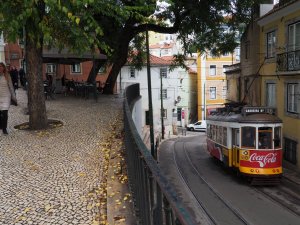
On the one hand, it will be great for local residents to see a payday. Conversely, the very reason tourists are attracted to Alfama – the overall charm and attraction of Lisbon, in general – will dissipate with these changes.
The perfect example is a short walk away. The entire area (and more), from Santa Justa elevator to the river, sucks. It’s completely overrun with souvenir shops, disgustingly overpriced tourist restaurants and selfie-snapping bozos. It’s pretty, but there is no sense of authenticity here.
Eventually, Alfama is likely to follow suit and become another area to fall victim to tourism. In the meantime, a great majority of Lisbon is holding out, and, for now, Alfama remains a cool place to wander. The best thing to do is travel to Portugal and explore the streets of Lisbon as soon as possible.
Reader Interactions
Leave a reply cancel reply.
Your email address will not be published. Required fields are marked *
Notify me of follow-up comments by email.
Notify me of new posts by email.
This site uses Akismet to reduce spam. Learn how your comment data is processed .
Before Footer
Lisbon Solo Travel Guide

Planning a solo trip to Lisbon ? Here’s everything you need to know for your visit:
QUICK FACTS
- The capital city of Portugal, with a population of around 550,000 .
- This global city is recognized for its influence in finance, commerce, arts and culture.
- Located on the western Iberian Peninsula on the Atlantic Ocean and Tagus River.
- The second oldest capital after Athens, Lisbon was first settled by the Phoenicians in 1200 B.C. Steeped in history, Lisbon predates modern European capitals such as London, Paris and Rome by hundreds of years.
- Nicknames: City of the Seven Hills, The White City, Lisboa
PRACTICAL INFORMATION
- Currency: Euro (EUR).
- Spoken languages: Portuguese and English .
- Best time to visit: from May to October for the popular climate that is also the mildest in all of Europe, with the warmest summers and gentlest winters.
- Arriving via airport: Lisbon Portela Airport (LIS) is connected to downtown Lisbon with a ride aboard the Aerobus costing €3.50 one-way or by metro for €1.40. Taxis charge €10-€15.
WHERE TO STAY
- Best hostel for solo travelers: Home Lisbon Hostel . Why not try one of the best hostels in the world? Exceptionally clean rooms and facilities (serviced daily), close to the action, and known for its cozy atmosphere. “Mama’s dinners” are a perfect way to meet other travelers. Book ahead, as this one sells out fast!
- Baixa marks the centre of the city and stretches from Praça Dom Pedro IV to Praça do Comércio, the two major squares. The area is popular for its 18 th century architecture, open-air cafés and range of accommodation, which includes everything from upmarket hotels to hostels.
- Chiado is the heart of Lisbon and is a hive of activity with a range of accommodation options.
- Pena is quieter at night, yet still close to the centre of the city.

GETTING AROUND
- Most of Lisbon’s main attractions are located within walking distance .
- The Lisboa City Card combines free or discounted entry at over 80 museums and attractions with free use of the public transportation system. Get the 24-hour card for €18.50, the 48-hour for €31.50 and the 72-hour for €39.
- Carris operates the bus and tram services. Tickets cost €1.40 per ride of €6 for a validity of up to 24 hours. Tickets are available to purchase from drivers on board all tram, bus and metro services. A single fare on a bus purchased using a Viva Viagem (rechargeable) ticket cost 1.80 EUR (the same ticket purchased directly from a driver will set you back 2.85 EUR).
- There are 55 metro stations covered by four subway lines across the city. Tickets cost €1.40.
- Taxis are an inexpensive way to cross the city and reach the outlying neighborhoods. Call 21 812 9275 or 21 811 1100 to book.
- Tram : tram #28 runs through old town and is a great way to view the city. A ride is 1.05 EUR.
- There are several funiculars that operate within Lisbon. A typical fare is 3.50 EUR.
- Ferries that connect Lisbon to the suburbs across the Tojo river operate daily. Fares start from 1.15 EUR.
LISBON NIGHTLIFE
- Drinking age is 18 , and last call is 3 AM (discos and clubs sometimes stay open until 6 AM).
- Chiado is popular among the after-work crowd looking for an easy drink and lively chatter.
- Bairro Alto is the epicenter of Lisbon’s nightlife thanks to a vibrant bar scene. You will find the best Fado houses in Alfama and Bairro Alto. There are also some smaller places near Lapa and S. Jorge worth checking out.
- Docas or Santo Amaro Docks has a lively atmosphere helped by sophisticated bars and nightclubs.
- Looking for general bar recommendations ? Cerveteca Lisboa (craft beer), Dois Corvos Cervejeira (craft beer), Fábrica da Musa (craft beer), Cinco Lounge (cozy cocktails), Fama d’Alfama (drinks with Fado music), Foxtrot (cocktails), Outro Lado (cozy bar)
- Cocktails with a view : Sky Bar Oriente ($$$), Level Eight Rooftop ($$), Java Rooftop ($$), Ponto Final ($$ – waterfront views from Almada)
- Looking for a sports bar ? If there’s a game on, any bar with a TV will do! Mignon Sports Bar is a particularly loved location.
- Looking for techno clubs? LuxFrágil and Ministerium Club are your best bets. Warning: there’s a strict door policy, and they won’t let you in if you look like a tourist.
UNIQUE LANDMARKS TO VISIT
- Jerónimos Monastery is one of the most prominent symbols of Portugal’s power during the Age of Discovery, built by Hieronymites.
- 25 de Abril Bridge connects Lisbon to the municipality of Almada located on the left bank of the Tejo River. It is one of Portugal’s longest suspension bridges, inaugurated in 1966.
- Castle of São Jorge is located at the top of the tallest of the 7 hills over which the historic centre is draped. The Moorish fortress is visible from long distances and provides uninterrupted views of the city and its countryside.
- Belèm Tower (Torre de Belèm) was built in the 16th century to defend Lisbon harbour, and makes for an imposing gateway to the city. The Manueline fortress is now a UNESCO World Heritage Site.
- Are you into marine life? Check out Oceanário de Lisboa , one of the largest aquariums in Europe. A sight to behold.
INTERESTING WALKS
- Tip : weather in Lisbon is known to rapidly change from sunny to windy and wet. It pays to carry an umbrella and an outer layer, especially in spring, autumn and winter. It is very dry in the summer months.
- Take advantage of the free walking tours in Lisbon. It’s a great way to see the sights and meet other solo travelers, too!
- Avenida da Liberdade was built in the style of the Champs-Elysees in Paris and is the main artery of the city, an elegant tree-lined stretch that epitomizes Lisbon’s character.
- Rossio Square is the liveliest stop in the city, a meeting place for leisurely lunches at any of its excellent cafés and their outdoor seating and the perfect place from which to admire the grand architecture.
- While walking to Alfama from Baixa, stop at the Portas do Sol that opens up to the vast scenery of Lisbon’s rooftops.
- Rua Augusta is the main pedestrian street and the shopping mecca in the city.
- Follow the tracks of the famous 28 tram as you walk through the old town to downtown.
- Wander around Lisbon Botanical Garden and admire the hundreds of plants and bizarre hanging trees that have been planted here for centuries. This collection of plants was created by a former king of Portugal, who wanted a garden filled with every plant on Earth.
- Need to rest your feet? Stop for coffee at Baobá Café Bica and just enjoy the city walk by.
- If you have an extra day in the city, go for a day trip to beautiful, historic Sintra (a short train ride away). Just remember to wear a hat and sunscreen on hot days!
LOCAL WISDOM
- The Portuguese are known for their sweet tooths – Lisboans are no exception! Try pastéis de nata (a sumptuous custard tart) and tarte de maçã (a melt-in-your-mouth apple tart) for an introduction to their favourite pastries.
- Try to guess the secret ingredient as you wipe sugar and cinnamon from your lips after polishing off a Belèm custard tart from Pastèis de Belèm .
- The elétrico 28 is Lisbon’s legendary vintage tram that crosses the city accompanied by the insistent chime of bells used to warn pedestrians of its approach.
- Looking for great restaurants in Lisbon that locals love? Quick recommendations: A Licorista ($), Zé dos Cornos ($), Pinóquio ($$), Bastardo ($$), Sala de Corte ($$$), Ramiro ($$$), Seen Lisboa ($$$$ – cocktails and sushi, epic views of the city)
- Where to find good cheap eats : head to Rua das Gáveas for cheap traditional dishes. You can also check out Chiado . Most restaurants will have a dish of the day and you will find this is often cheaper and fresher than other dishes on the menu. Look for the small coffee shops and restaurants crowded with locals for good cheap, homestyle cooking. Be aware that if you choose to eat in a restaurant playing Fado music you will often pay more than the food is worth – remember it is the music you are paying for!
- Dangerous areas : pickpockets are known to operate aboard the tram lines and in crowded public places so belongings should always be secured. Otherwise, Lisbon is very safe.
Recommended trip duration: 2-3 days
- Porto, Portugal
- Funchal, Portugal
- Lagos, Portugal
- Madrid, Spain
- Barcelona, Spain
Leave a Reply Cancel reply
Your email address will not be published. Required fields are marked *
Save my name, email, and website in this browser for the next time I comment.
- Skip to primary navigation
- Skip to main content
- Skip to footer
Get fresh, hand-crafted updates and news from the Casual Travelist delivered straight to your email.

Casual Travelist
Travel and food, with a dash of adventure
25 Tips for Your First Trip to Lisbon, Portugal
By Brianna | April 18, 2018
Sharing is caring!
- Facebook 333
- Twitter 148
- Pinterest 5118
Lisbon, Portugal seems to be on everyone’s travel radar these days. Europe’s second oldest capital is equal parts grit and grandeur with both a timeless appeal and modern allure. Lisbon has centuries of history and tradition but is also fiercely independent with a creative streak which makes it one of the most captivating cities in Europe. With so much to see, do and eat planning to travel to Lisbon can be a little daunting, but armed with these tips you can make your first trip to Lisbon one to remember.

This post contains affiliate links, when you make a purchase or book a hotel through these links the Casual Travelist receives a small commission that helps support this site at no additional cost to you.
1.Arriving to Lisbon
The Lisbon Portela Airport is Portugal’s main international hub and is well serviced by over 30 airlines. For the most direct way to reach your hotel taxis and Uber are plentiful and costs apporoximately 15 Euro. The most affordable ways to get to Lisbon’s city center are the Metro ( a 25 minute trip on the red line connecting through Saldanha station) or by bus with multiple bus routes serving the city. Check Lisbon Airport’s site for the lastest route information. Visitors from the EU, Britain, Canada and the US do not need a visa, check Visit Portugal for the latest entry requirements.

2.Transportation in Lisbon
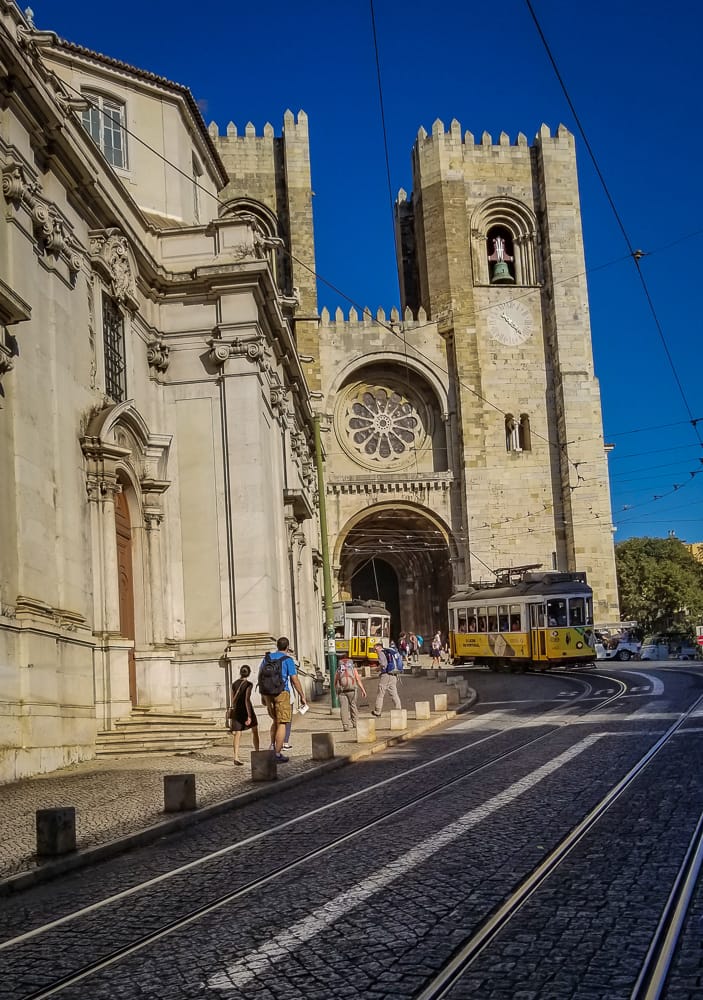
Public transportation in Lisbon is decent but not as good as other European capitals. The VivaViagem card is reusable (and offers discounted fares vs. single fare tickets) and can be used for trams, buses, trains and the metro. Taxis, tuk-tuks and Uber are also widely available.
3. Money in Portugal
As part of the EU Lisbon uses the Euro, but compared to other European capitals your money goes far here making Lisbon a great destination for the budget traveler. ATMs are plentiful and most businesses accept credit cards. Beer or a glass of wine can be had for as little as 2 Euro, a quick sandwich for less than 5 Euro, casual menu del dia for 8 Euro and sit down dinners from 15 Euro.
4.Weather in Lisbon
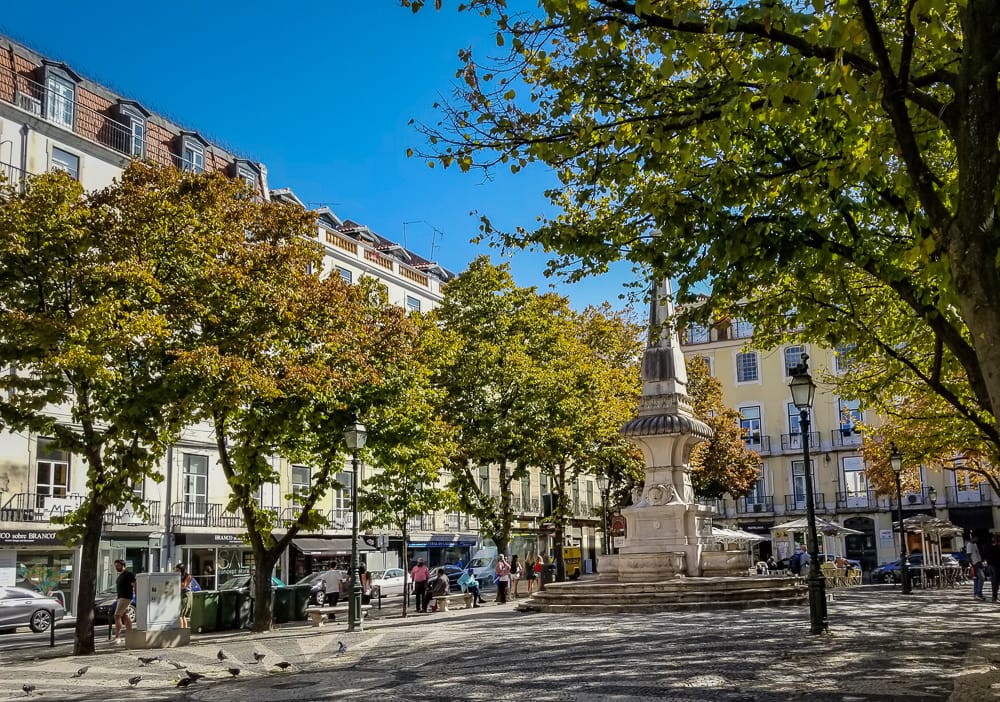
Weather in Lisbon is fairly moderate with warm summers and cooler,wetter winters. Average high temperatures from June-August range from 80-90 degrees F (25-30 degrees C) while daytime temps in December-February average around 55 degrees F ( 13 degrees C) but are typically wetter than other times of the year. Spring and autumns are glorious with sunny days and average temperatures in the 70s F (22-26 degrees C).
5. Accommodations in Lisbon
Lisbon has a wide range of accommodations from budget hostels to boutique inns and luxury hotels. Renting an apartment is an increasingly popular option but with the popularity of Lisbon as a travel destination many apartment owners are opting to rent through short term sites like Airbnb instead of the traditional long term rental. This unfortunately has priced a lot of locals out of the center of Lisbon.
>Hostels in Lisbon
>Boutique Hotels in Lisbon
>Luxury Hotels in Lisbon
6. Lisbon has hills. Seven of them.

Like Rome, Lisbon is a city of seven hills and no matter which direction you go it feels like you are always walking up. While I am more than happy to walk these hills (mainly so I can justify eating all the pastel de nata), the people of Lisbon have developed a few easier ways to traverse these steep hills including its famous trams and even an elevator in the middle of the city ( I’ll have more on these shortly).
Itinerary for Four Days in Lisbon
7. Make sure to wear good shoes

Lisbon’s sidewalk mosaic tiles are gorgeous but also quite slick. Be sure to wear shoes with good tread to avoid taking a spill.
8.Lisbon trams
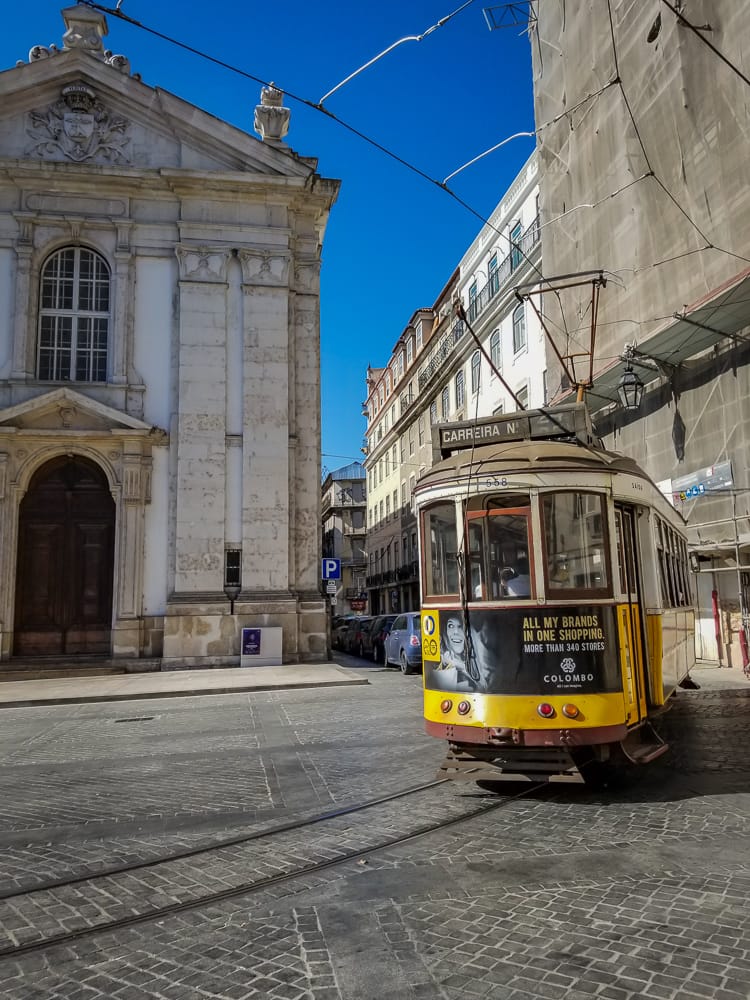
Perhaps no other image is more associated with Lisbon than a yellow tram climbing the cobblestoned hills past historic tiled buildings (I may or may not have taken over 100 pictures of trams during my visit). Trams are a part of Lisbon’s public transport and can be a great way to get from point A to point B. Tram #28 is especially popular with tourists as it goes pasts several of Lisbon’s most popular sights however it can be quite crowded with wait times to board at over an hour. Tram #28’s popularity with tourists has also made it quite popular with pickpockets as well.
9. For the best views in Lisbon follow signs for Miraduoros
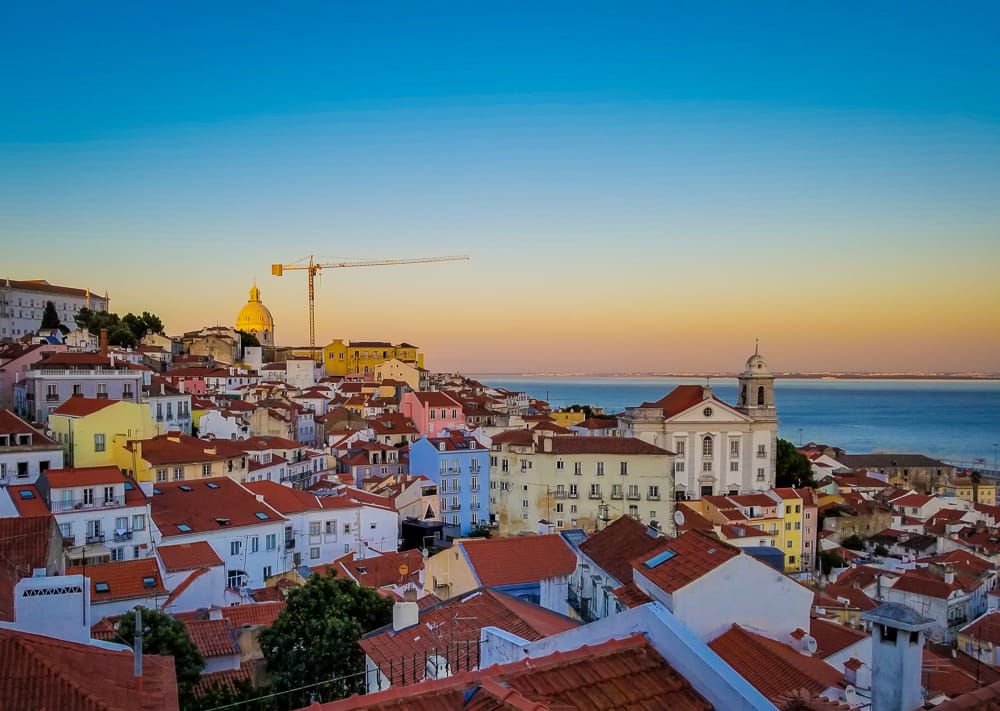
If you see a sign leading the way to a Miraduoro it would be a good idea to follow where it goes. These scenic overlooks can be found throughout Lisbon. For views overlooking the red tiled roofs of the Alfama district and the Tejo River head to Miraduoro Portas do Sol; or check out the Miraduoro de Sao Pedro de Alcantara near Barrio Alto for great views and people watching.
10. Take in Lisbon’s beautiful sunset views

More than any other city I’ve been to it seems like much of Lisbon was built solely for taking in amazing sunset views. Join the locals and end your day taking in some of the best sunsets in Europe.
Lisbon Neighborhoods
The Alfama district is a beautiful maze of cobblestone alleys, cozy squares, terracotta tiled roofs and surprises around every corner. Lisbon’s oldest and most traditional neighborhood was untouched by the earthquake of 1755 and today you’re still likely to the sounds of fado echoing through the alleys as you pass ladies hanging their laundry out to dry but you’ll also find Lisbon’s creative spirit on display in the form of colorful street art. The Alfama District is home to the 11th century Sao Jorge Castle and the Se Cathedral, which has been serving Lisbon’s catholic population since 1150.

12. Barrio Alto
A quiet residential neighborhood by day the Barrio Alto comes alive once the sun goes down. Bistros, bars and clubs keep the Barrio Alto buzzing late into the night.
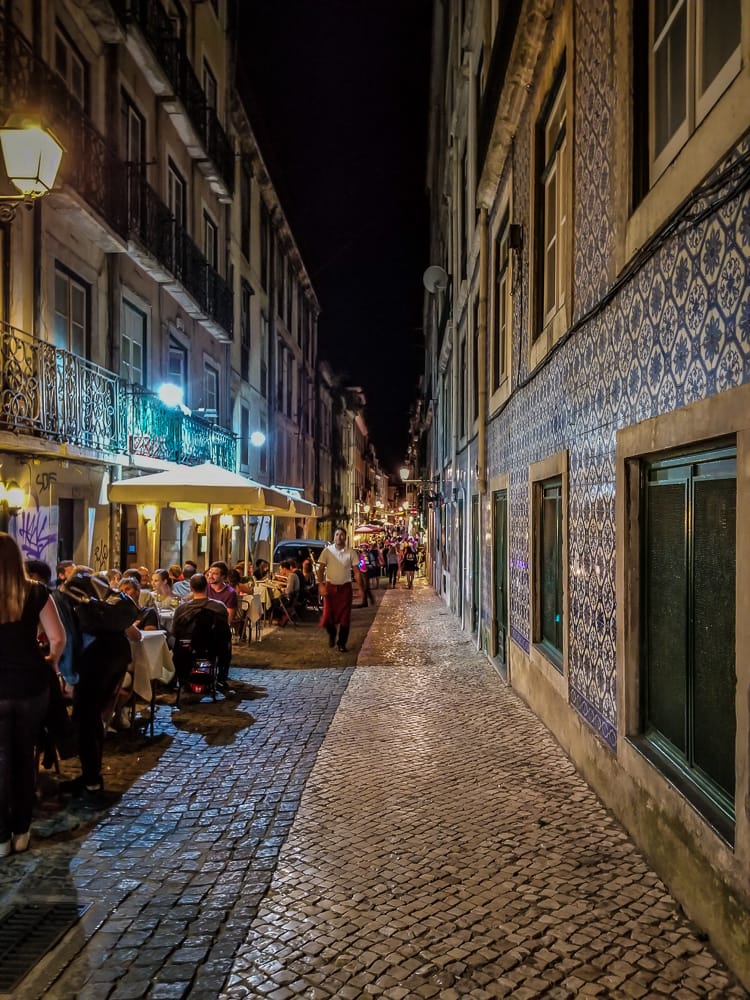
13. Cais do Sodre
Once a seedy area frequented by hard-drinking sailors Cais do Sodre is now home to trendy bars and cafes. Be sure to stop by the Time Out Market and the Mercado da Ribiera to taste the best of Lisbon’s contemporary and traditional flavors.
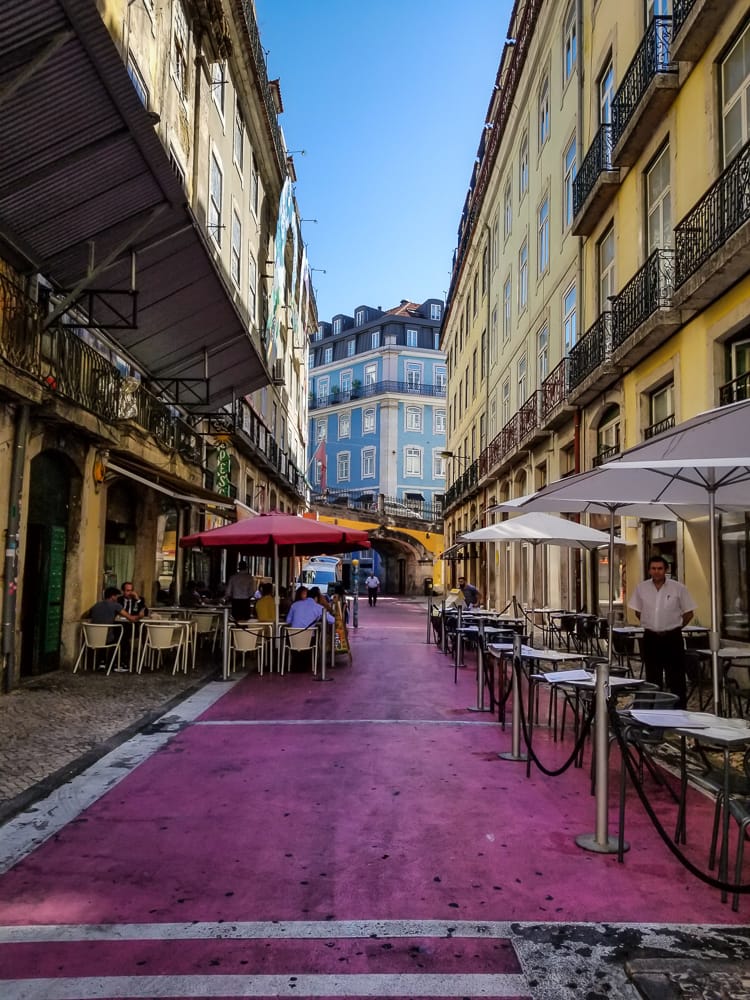
To the west of downtown Lisbon lies Belem, once the port area for Lisbon and departure point for Portuguese explorers during the Age of Exploration. A visit to Belem is one of the top things to do in Lisbon . The Tower of Belem (which in my opinion would make an excellent Game of Thrones filming location) has been seeing off explorers since the 16th century. Nearby the Mosteiro dos Jeronimos is an intricate Unesco World Heritage site with fantastical architecturl details. Belem is also home to Lisbon’s museum district including the contemporary MAAT ( Museum for Art, Architecture and Technology).
To reach Belem take the train or tram 15E from Cais do Sodre.

15.Chiado/Baixia
Located between Barrio Alto and Alfama the neighborhoods of Chiado and Baixia are Lisbon’s upscale neighborhoods. Chiado is artistic, with grand cafes, chic art galleries and a proud literary history. This is also where you’ll find some of Lisbon’s most beautiful architecture including the stunning Carmo Convent, a medieval convent that was destroyed in the earthquake of 1755 whose facade is beautiful and timeless. Baixia is home to wide leafy boulevards lined with tony boutiques and the Elevator de Santa Justa, a wrought iron lift that connects Chiado and Baixia. A popular tourist attraction, waits to ride the elevator can be over an hour. Snap a picture and go on your way.
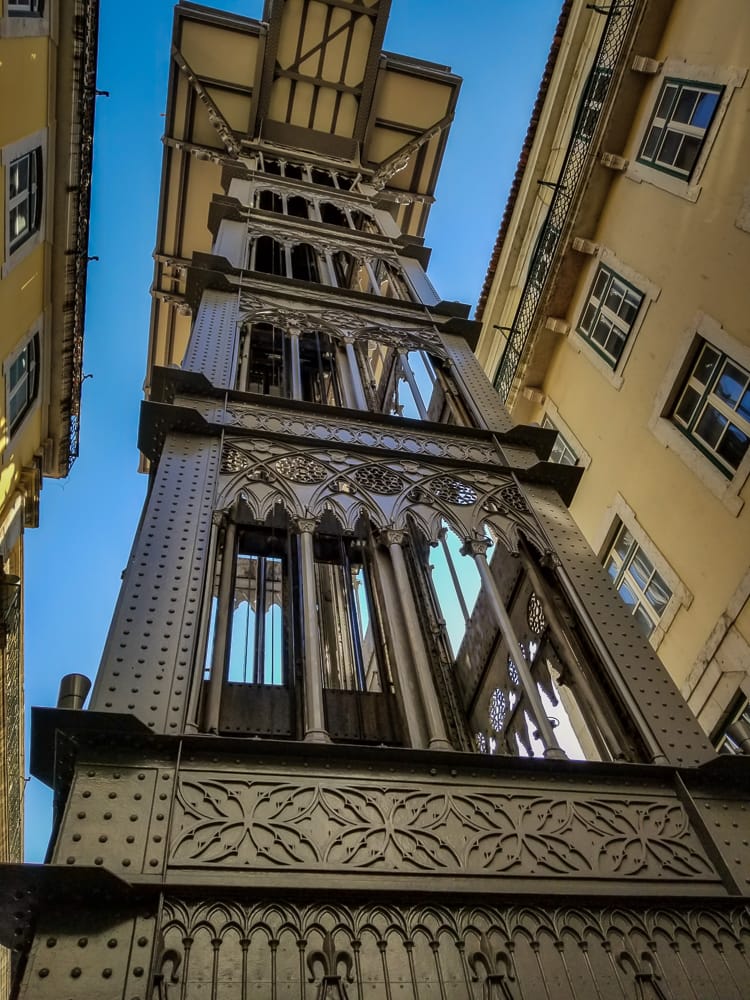
Food and Drink in Lisbon
16.food in lisbon.
With a focus on simple, fresh ingredients food in Lisbon may be the most underrated cuisine in Europe. With miles of coastline along the Atlantic Ocean Lisbon is a seafood lovers paradise (more on that below); but carnivores should be sure to sample porco preto , Portugal’s beloved black pork. These Iberian pigs eat a diet of acorns from the cork oak trees that thrive in the Alentejo countryside producing pork with a distinctly nutty taste. Also not to be missed is presunto , a silky dry-cured ham that in my opinion is better than Spain’s jamon iberico. Caldo Verde is a simple but comforting classic Portuguese kale soup. I believe a food tour is a great way to get to know a city and its cuisine in a short amount of time, join one of the culinary walking tours with Backstreet Eats.
What to eat in Lisbon
17. those appetizers aren’t free.
It’s common for waiters to bring out a little plate of nibbles (known as couvert ) at the beginning of the meal that usually includes olives, bread and cheese but be aware it’s not a freebie. To avoid being charged politely send the plate of goodies back untouched.

From simply grilled sardine and freshly fried octopus to hundreds of ways to prepare cod (bacalhau) Lisbon is without a doubt one of the best cities for seafood lovers. Lisbon also elevates canned seafood to an art form. Colorful tins contain oil packed sardines, tuna, mackerel and smoked eel that is worlds above that sad can of tuna sitting in your pantry and make for a great souvenir to get in Lisbon .
19. Eat all the pastel de nata (and other pastries)

When you’re in Lisbon you really need to make it your mission to eat as much pastel de nata as humanly possible. This creamy, egg yolk-based custard tart is ubiquitous throughout Lisbon. The guide books will tell you to go to Pasteis de Belem, which has been serving up flaky tarts since 1837 but can also have up to a two hour wait. Instead get your tart fix at Manteigaria, a cozy art deco pasteleria in the Barrio Alto neighborhood. Aside from pastel de nata you will find bakeries on every corner filled with a diverse variety of Portuguese pastries. Be sure to pair your sweet treat with a cup of coffee or bica (espresso), which is excellent thanks in part to Portugal’s close relationship with Brazil.
20. What to drink in Lisbon

You’re likely familiar with port, the sweet fortified wine from the north of Portugal, but Lisbon has a wide variety of great wine thanks to its proximity to the Alentejo. Whether you enjoy a glass with lunch or head to one of Lisbon’s many wine bars after the sun goes down wine is Lisbon is plentiful, affordable and above all very good.
The other drink you must try in Lisbon is ginjinha, a sweet liqueur made from sour cherries. Served straight or in a chocolate cup (my favorite), ginjinha can be found in the many kiosks that dot Lisbon.
The soulful melodies of fado are Lisbon’s version of the blues. Songs full of meloncholy and heartache sung with the masterful strums of a 12-string guitar are the soundtrack to Lisbon. Head to a tasca for authenic fado, Povo Lisboa in Cais do Sodre and Tasca do Chico in Barrio Alto are local favorites.
22.Safety in Lisbon
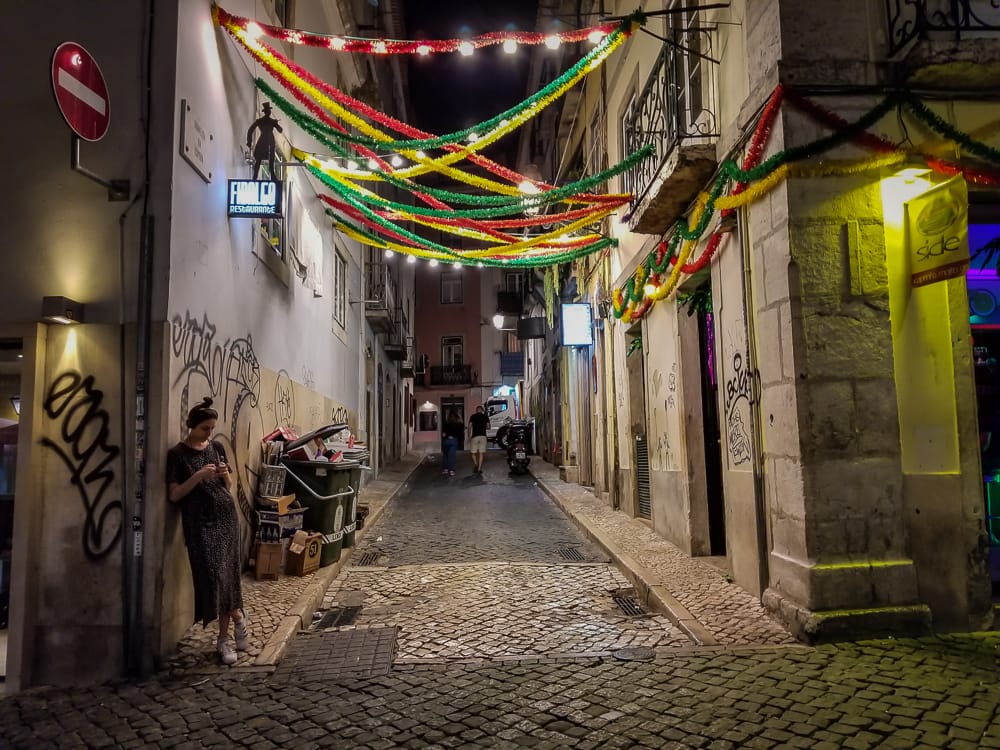
Portugal has a fairly low crime rate but it’s advised to take the usual precautions as you would in any big city. Pick-pocketing and petty theft can be common in trams, particularly the touristy tram #28.
Day trips from Lisbon

Cascais is the closest beach town to downtown Lisbon . A 30 minute train ride from the Cais do Sodre train station this charming town offers sun drenched beaches, dramatic cliffside views of the Atlantic Ocean, whitewashed homes and perpetual sunshine. I was contemplating a move here 10 minutes after arriving.
>Hotels in Cascais
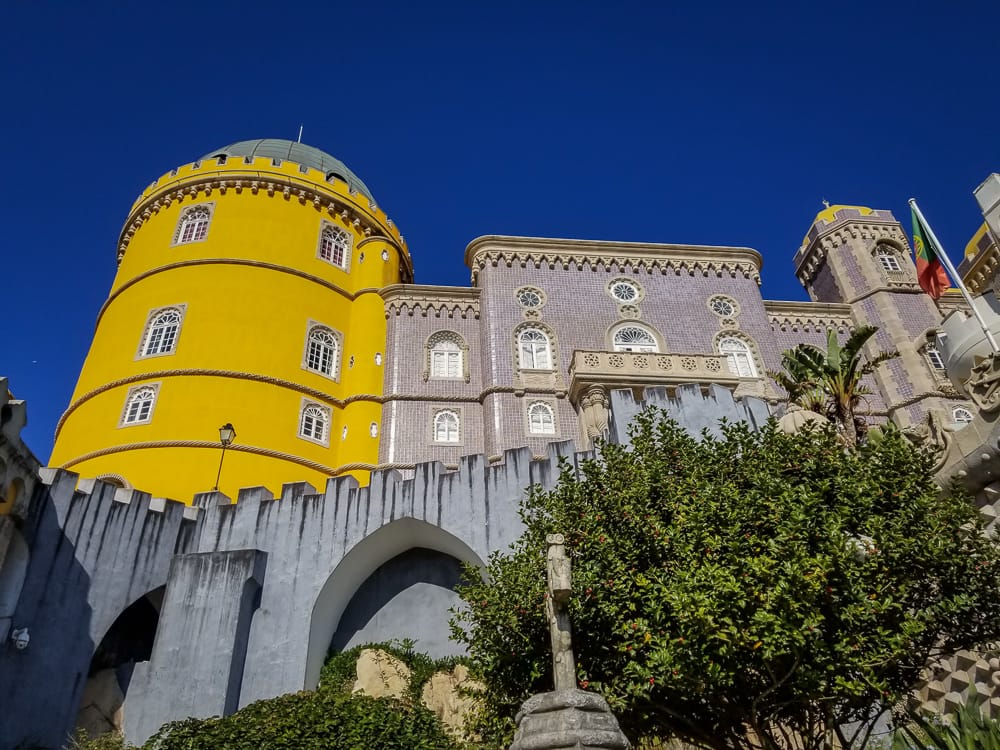
If you take only one day trip from Lisbon make it Sintra . The main draw in Sintra is the colorful fairytale castle of Pena Palace , but this Unesco World Heritage Site also boasts the medieval Moorish Castle and the whimsical home and gardens of Quinta de Regaliera .Trains to Sintra leave from Lisbon’s Rossio train station every half hour and the journey takes around 40 minutes.
>Hotels in Sintra
Evora is the heart of the Alentejo, Portugal’s largest wine and agricultural region. Explore Roman ruins and the Chapel of Bones (a church decorated with hundreds of bones from human skeletons) or taste your way through the nearby vineyards. Evora is about a 90 minute train or bus ride from Lisbon.
Hotels in Evora
More Lisbon and Portugal Inspiration
The Perfect Weekend in Lisbon
Amazing Scenic Lisbon Viewpoints
UNESCO World Heritage Sites in Portugal
What to See in Lisbon in Two Days
Planning a trip to Lisbon? Pin this post for later!

About the Author
Freelance travel writer and blogger who seeks out laid back luxury. Focus on culinary, adventure and nature travel. [READ ALL ARTICLES]
3 Meals: Where to Eat in Washington DC

Chasing Waterfalls: Discovering Tallulah Falls in North Georgia
Reader interactions, leave a comment cancel reply.
Helpful comments include feedback on the recipe or changes you made.
Get new posts and travel tips delivered right to your inbox!
This site uses Akismet to reduce spam. Learn how your comment data is processed .
Tamara says
April 19, 2018 at 8:09 am
Great tips, thank you! Perfect timing as I am headed there next week.
April 19, 2018 at 12:04 pm
#17 took us by surprise on our first trip! We learned quickly though! Great tips!
Esther says
April 20, 2018 at 12:41 pm
I agree with all of these! Visited Lisbon twice and couldn’t get enough. I also recommend Lux, an old textile factory now home to many independent shops and great restaurants and clubs. For a day on the beach I recommend Sesimbra over Cascais, it’s a lot less crowded and touristy. #WeekendWanderlust
April 20, 2018 at 1:47 pm
Amazing tips! I will definitely need them for when I go in the near future. Pinned.
Brianna says
April 27, 2018 at 9:41 pm
Goblinette says
April 20, 2018 at 5:37 pm
Great tips. Haven’t been in LIsbon yet, but it looks lovely.
April 27, 2018 at 9:42 pm
I loved Lisbon and can’t wait to go back!
April 20, 2018 at 5:42 pm
MMMM. Pastel de Nata is my favourite! Great resource!
April 27, 2018 at 9:43 pm
Pastel de nata is the best!
Obligatory Traveler says
April 20, 2018 at 9:37 pm
Great Post. Thanks for including so much great information, especially information about transportation. Since we usually don’t rent cars, it’s good to know the reliability of the public transportation. It’s also nice to know about the wait time for Tram #28 to meter expectations. The food and drinks look delicious. #WeekendWanderlust
April 27, 2018 at 9:45 pm
I hope you find this post helpful if you make it to Lisbon.
Sandi Kowalyshyn says
May 27, 2019 at 9:20 am
Hi Brianna! Can you tell me if it is safe to wear my diamond Jewelry in Lisbon?
Thanks! Sandi
Simone says
April 21, 2018 at 4:47 am
As I’ll be in Portugal during my van trip in September, I’ll definitely use all this infos once in Lisbon. Great pictures!
Can’t wait to see your adventures!
Rhonda Albom says
April 21, 2018 at 8:23 am
I skipped Lisbon when I travelled through Portugal years ago and have regretted it. You seem to have put all the basic travel information about Lisbon together in one spot. This is one resource that I will use when I return to see Lisbon.
Amanda Grace says
April 21, 2018 at 10:57 am
Yessss. This is exactly what I needed!!! Thank you for sharing.
April 27, 2018 at 9:48 pm
You will love Portugal!
Nicole says
April 21, 2018 at 11:24 am
This is a great post. I think that you cover many practical issues that travellers need to know in order arrive and move around the city easily. We spent days in Sintra a few years back and loved it there. We will definitely need to go back to Lisbon to explore more.
April 27, 2018 at 9:49 pm
Isn’t Sintra just magical?
Annie Soul says
April 21, 2018 at 1:16 pm
Great tips! I’m really looking forward to checking out some of the districts and food 🙂 thanks for the info!
April 27, 2018 at 9:50 pm
Any district or food pique your fancy?
Marcus and Mel says
April 21, 2018 at 1:19 pm
A great detailed and useful list. We were there last Spring and loved the place. You definitely need good shoes with all those hills and the pretty pavements are quite slippery, especially when wet. The Time Out Market offers a range of food suitable for all tastes. We really enjoyed our trip to Sintra, make sure you go early.
April 27, 2018 at 9:52 pm
Glad you enjoyed this post, I want to go back!
Lorial Roballo says
April 21, 2018 at 1:44 pm
Ugh I love Lisbon. I visited here in 2016 and it one of my op places to travel to in Europe. That view from the Miraduoro is absolute perfection and even though you get a GREAT instagram photo. It just isn’t the same from real life. Pastéis de Belém was hands down the best pastry that I’ve had during my time in Europe. And I wish I could find it here in St. Louis. Maybe I can I just haven’t checked. Great article and wonderful photos! 🙂
April 27, 2018 at 9:54 pm
Thank you! Perhaps it’s time for a return trip?
April 21, 2018 at 8:53 pm
Thank you very much for this post, I’m actually just starting to plan my trip to Portugal and this post is the first to be saved into my Portugal folder. I’m looking to go in July, flying into Porto and heading North before heading south and of course I will be spending quite some time in Lisbon. Friends of mine have told me i will fall in love with it, and from just reading through this post I can see why. It’s good to know that appetisers are not free, and good advice on the footwear for the slippery streets – I’ll be honest after reading through this I’m most looking forward to trying my first pastel de nata with a Bica 😀 – I can’t wait to get out there 😀 😀
April 27, 2018 at 9:55 pm
I can’t wait to see how your trip goes!
April 22, 2018 at 4:02 am
This is a really great list! Hoping I’ll get to go to Lisbon soon so definitely saving this 🙂 #WeekendWanderlust
April 27, 2018 at 9:57 pm
Thanks a bunch!
Fiona Maclean says
April 22, 2018 at 9:47 am
Although I’ve travelled around Portugal a lot, I haven’t been to Lisbon since I was 30. In fact, it was for my 30th birthday! I went with my boyfriend in search of fado and ended up drinking far too many tequila slammers…I definitely needed some of your tips to keep me focussed. I’m planning to go back this year so I’ll be bookmarking this and using some of your great tips on where to go (Belem for instance) and what to eat (black pork!)
April 27, 2018 at 9:59 pm
Stick to port and ginja this time;)
April 22, 2018 at 12:13 pm
I remember arriving in Lisbon and thinking we can walk all over— oh wait, we could but it is hilly so you are right— you need to wear comfy shoes. We bought the tram card and that kinda saved our lives. Lisbon is pretty but its a lot of exercise— well I guess we just eat and walk it off. We also enjoyed the day trips outside Lisbon.
April 27, 2018 at 10:01 pm
Like I said, I didn’t mind all the walking so I could eat more 🙂
Dorene says
April 22, 2018 at 5:34 pm
Could the sky have been more blue than during your visit to Lisbon? 🙂 I so look forward to getting there, and this is the perfect post for me – lots of great tips and navigation before arrival. I like your detail of the neighborhoods – good to know where to go. Alfama will definitely be on my list. Good to know about the friendly appetizer plates, I would have definitely fallen for that. Bookmarked for future visit.
April 27, 2018 at 10:02 pm
Alfama is absolutely beautiful, great choice!
Efthimis Kragaris says
April 23, 2018 at 7:52 am
Great guide. Hopefully I will visit Lisbon this year. Can’t wait to enjoy some great Portuguese wine while listening to fados and watch the sunset view from the various miradouros. The tiles and the trams are also so instagrammable!
Michelle says
April 23, 2018 at 12:20 pm
I haven’t been to Lisbon yet, so these tips will come in handy when we get there. I didn’t realize the city was so hilly!
Kathleen says
April 23, 2018 at 3:30 pm
Such great tips. I’ve just recently become interested in visiting Portugal, although I never would have turned it down before. Lisbon is so beautiful and picturesque. I really love the tiled walls and sidewalks. The little tarts look like some we had in China. I wonder if they are similar. The ones in China are a sweet egg tart, not tasting like egg at all.
April 27, 2018 at 10:04 pm
Portugal’s food culture spread around the world so I’m guessing the tarts would be very similar.
Siddhartha Joshi says
April 23, 2018 at 11:36 pm
Lisbon is such a dream destination for me, and sadly I haven’t been there at all despite going to Europe so often. Thanks to your lovely guide I am even more inspired 🙂
Thanks for including handy tips also like pick-pocketing in trams and so on…very useful for planning and being mindful 🙂
Indrani says
April 24, 2018 at 12:23 am
I agree with you on – the yellow trams are a symbol of Lisbon. The Elevator de Santa Justa surprised me. Seeing the queue I took just a pic 😛 🙂 Enjoyed reading the post, it was like revisiting.
Medha Verma says
April 24, 2018 at 6:43 am
What a beautifully detailed post! Thanks for the advice on wearing good shoes for those street walks and I am happy to know that it’s a budget destination. Also, it seems like the VivaViagem card is a good investment for those who want to travel in a budget way, using public transportation. Alfama district’s street art looks great!
Julie McCool says
April 25, 2018 at 8:49 am
Excellent round-up of tips. I love the mix of practical info and travel inspiration (those sunsets look amazing). I stayed in Sintra but only passed through Lisbon, so it’s time for another trip to Portugal.
Miranda| Migration Expert UK says
May 7, 2018 at 11:00 pm
Great blog post with lots of useful information about Lisbon! Thanks so much for sharing.
May 10, 2018 at 12:37 pm
Great tips Brianna, thanks very much! I am planning to visit Lisbon for the first time soon, these will come handy.
June 13, 2018 at 8:36 pm
Hopefully you get to Lisbon sooner rather than later!
Sarah Montgomery says
May 13, 2018 at 6:23 am
We’re heading over to Lisbon for the summer and your article was really insightful. It’s great to know that public transport would be easily available as we’re not looking to rent a car. I’m especially looking forward to watching over the stunning views and munching on pastel de nata. Loved the read.
June 13, 2018 at 8:39 pm
I’m glad you found it helpful!
Tina Wright says
May 14, 2018 at 6:05 am
Thanks for such an informative blog. Perfect for our 48 hours in Lisbon next month. So glad I found you, makes my planning easier.
June 13, 2018 at 8:40 pm
You will have a fantastic time in Lisbon!
Matthew Ali says
May 17, 2018 at 5:06 pm
Wonderful post – you covered almost every aspect for a trip to Lisbon. I’ve been there 2 years ago and it is one of the best places to visit in Portugal.
June 13, 2018 at 8:42 pm
I absolutely loved Lisbon and can’t wait to go back!
KB Burt says
November 1, 2018 at 8:24 pm
Ooh, it brings it all back! I haven’t been since 2010 but I loved it. I was quite ill and had to spend a good portion of my ten days on the hotel rooftop in Baixa and it could not have been a better place to recuperate (I’m a city girl and not good at beaches). The people were so nice and helpful, genuinely and I couldn’t agree more about the food! It’s a great place for dietary restrictions as well as you can get such simply cooked, delicious food. One piece of advice I got there was to be careful where there are signs warning against pickpockets – apparently lots of people check their wallet as soon as they see it and it’s a big help to pickpockets hanging around! 🙂
February 20, 2019 at 5:09 pm
Lisbon used to be a nice place to visit but it changed completely over the past 5 years. Now it’s just an artificial and stressful city packed with tourists everywhere. It became the perfect place to have coffee at Starbucks, have fast-food at international food chains or expensive dinners at the latest Butanese restaurant, cross thousands of useless souvenir shops full of made in China products, queue for anything slightly interesting while pickpockets do their job, squeeze and bump into other tourists in overcrowded side walks and not being able to meet and talk to a single Portuguese resident with a non-tourist job. It also became a very expensive city with dinner costing 40 euros/person and hotels averaging 100 euros/night. If you want to experience the Portuguese culture and gastronomy for 1/3 of those prices then run away from Lisbon as fast as you can. I hate to say this but overtourism killed Lisbon and its authenticity. I’d recommend other places in Portugal that are still not that popular such as Braga/Guimaraes/Geres/Coimbra/Aveiro in the North, Sintra/Guincho/Cascais/Evora/Sesimbra/Arrabida/Comporta close to Lisbon or Costa Vicentina/Algarve (Lagos, Tavira, Vilamoura) in the South.
Michela says
April 21, 2019 at 4:23 am
I have been to Lisbon a couple of times, and just realised that it’s a long time ago! This post is inspiring and very detailed, that make me want to go back to Portugal and Lisbon, hopefully soon again. Thanks for sharing!
September 6, 2020 at 2:49 am
This is a great list of tips, we totally agree with the amazing food in Lisbon, however we would recommend that you try to find the smaller cafes and restaurants, where you will here the locals, this will often mean that the food is made for local tastes and not for tourists. But yes, where ever you go to in Lisbon, try a pastel de Nata, like the Bacalhao, every baker, has a slight twist on the recipe, which means you never get the same one twice, which means that you have to try every one you see.
Sarah Patel says
January 15, 2024 at 6:57 am
Hey Brianna!
I really enjoyed reading your post, it is very complete!
I am planning a trip to Lisbon, and I really wanted to make a stop at Évora, since I am passionate about history, and I do enjoy drinking a glass of wine from time to time.
A friend of mine, who’s been there a few times, suggested I booked a guided tour , but I am still looking for more options, collecting as much of information as I can so I can make an informed decision.
Based on your experience, what would you recommend?
Thanks again for this great post!
Sarah Patel
[…] out the best tips for a trip to Lisbon […]
[…] RELATED: 25 tips for your first trip to Lisbon […]
[…] Seville, we flew to Lisbon to eat some […]
[…] Get 25 tips for your first trip to Lisbon from my friend Brianna […]
[…] And here’s a great resource for all you need to know about traveling to Lisbon for the first time. […]
[…] visitors head to the Algarve one of Portugal’s most charming beach towns is just minutes from downtown Lisbon. When I mentioned my plans to travel to Cascais to a Lisbon local a knowing smile lit his face as […]
[…] rainbow castle looks out over all the land. The palaces of Sintra are less than an hour away from Lisbon but feels worlds away. Portuguese and British nobility have long been swayed by Sintra’s […]
[…] 25 Tips for Your First Trip to Lisbon, Portugal […]
[…] Check out our recommendations for the best Portuguese food tours, cooking classes, and wine tours. With tours from Lisbon and Porto, these tours cover Alentejo, Minho, and everything in between. Or, for first-time visitors to Lisbon, check out these top Portugal travel tips. […]
[…] is really a great city and I would encourage you to read Brianna’s post on 25 tips for your first visit […]
[…] centuries of tradition and an independent creative spirit, Lisbon has become one of the world’s most fascinating cities. Europe’s second oldest capital […]
[…] Belem is home to the most famous attractions like Monastery of Jerónimos, Tower of Belem or even the contemporary art museum Coleção Berardo. And, obviously, you can’t miss the Pastel de Belem in its original pastry. But there’s so much more to Lisbon… […]
[…] For more tips on where Lisbon locals like to eat and drink, click here. See also: 25 Tips for Your First Trip to Lisbon […]
[…] is 640 km long all the way from the capital Lisbon and stretches 240 km from Porto, Portugal. This means that you need 23 to 25 days for the whole […]
[…] article from us here at Wyld Family Travel has you inspired to visit Portugal and stay in Lisbon. There are so many things to do in Lisbon that will have you entertained for your stay in the […]
- Privacy Policy
- Slow Travel
- South Korea
- Travel Stories

About the Destination
In the autumn of 2022, I got a job offer for a position in Lisbon, Portugal. And with that, I decided to change my life completely, leave my small Swiss town and move abroad to a country I’ve never even been to..
I spent the next year and 5 months making new friends, travelling a little around the country and learning a lot about the Portuguese culture and myself. During my time in Lisbon, I lived in a hostel and two different apartments (one of them with 6 guys, lol). And I can tell you that apartment hunting in Lisbon was a pain, especially on a local salary.
The weather in Portugal can be amazing, and I experienced a beautiful spring and summer in the city. But I also learned how priceless and important a fan but also a heater are when you live in Portuguese buildings. I drank countless glasses of wine and Caipirinhas and tried many restaurants. Lisbon definitely has and always will have a special place in my heart.
Slow Travel in Lisbon, Portugal
Some facts about portugal, the great lisbon earthquake.
Lisbon is one of the oldest cities in the world and used to be a central location for trade and commerce. However, in 1755, the city suffered from a big earthquake followed by fires and a Tsunami that destroyed the city almost completely. Besides the buildings, libraries and palaces that were destroyed, artworks and paintings that were lost, the disaster also took many lives. The earthquake, which is often referred to as “the Great Lisbon Earthquake” is a big part of Lisbon’s history. But it’s remarkable to see the areas that were rebuilt after this disaster and how the city is flourishing.
No matter where you go in Portugal, you will often see painted tiles. Doesn’t matter if it’s inside or outside, on the ground or the walls, you can find tiles everywhere. Some tiles have more simple patterns while others portray incredibly detailed pictures. One of my favourite artworks, which is a must-see, is the 22 thousand tiles at the São Bento Train Station in Porto, which were all painted by one person, Jorge Colaço.
Travel Stories from Portugal
My two favourite things about portugal, 1. the slow life.
Coming from a country like Switzerland, where everyone is always stressed and busy, the slow life in Portugal was a welcome change of scenery for me. I adore how the Portuguese are in love with life and that they take time to just enjoy it. No matter if that’s drinking an espresso in the sun or dancing until the sun comes up, they find joy everywhere.
2. The Wines
Through my time in Portugal, I got to taste a few different wines (including the famous “green wine” or “Vinho Verde” as the Portuguese call it). There’s just something about having a chilled glass of white or green wine while sitting on a rooftop in Lisbon and enjoying the good weather.
- 48 Hours In
48 Hours in… Lisbon
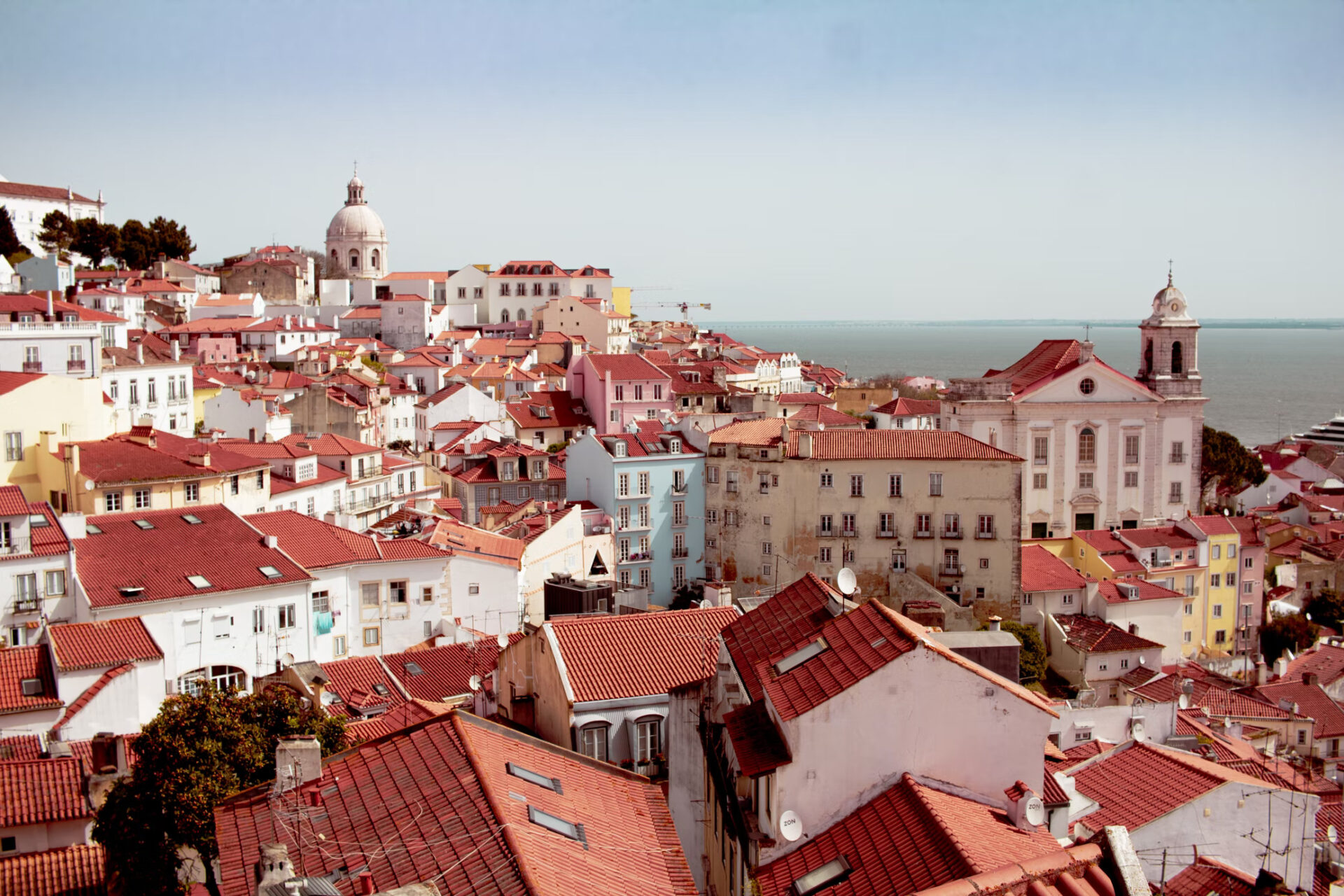
Lisbon – Top Tips
With its eternal golden hues, mosaic-adorned streets with clattering trams and a mouth watering foodie scene, Lisbon is one of our favourite cities to visit. Our co-founder James recently returned from a two-week Portuguese adventure (with a hefty pasteis de nata tally in tow), so what better time than now to bring you our top tips for a 48 hour stint in one of Europe’s oldest and most sun-kissed cities.
– Book all restaurants in advance. The best ones are often the smallest and you’ll need a booking to guarantee a table.
– Take it slow, Lisboa style and don’t worry about ‘completing’ the city in a weekend. You can always return, you’ll be searching for flights on your homeward journey!
– Have some extra time to play with? Lisbon’s surroundings are easily doable in a day. Visit Sintra’s pastel-hued manors and exotic gardens, Cascais or Ericeira to test your surfing skills and the Lx Factory in the otherwise quiet neighborhood of Alcântara. The latter is one of Lisbon’s coolest spots, filled with restaurants, galleries, boutique shops and snap-worthy street art.
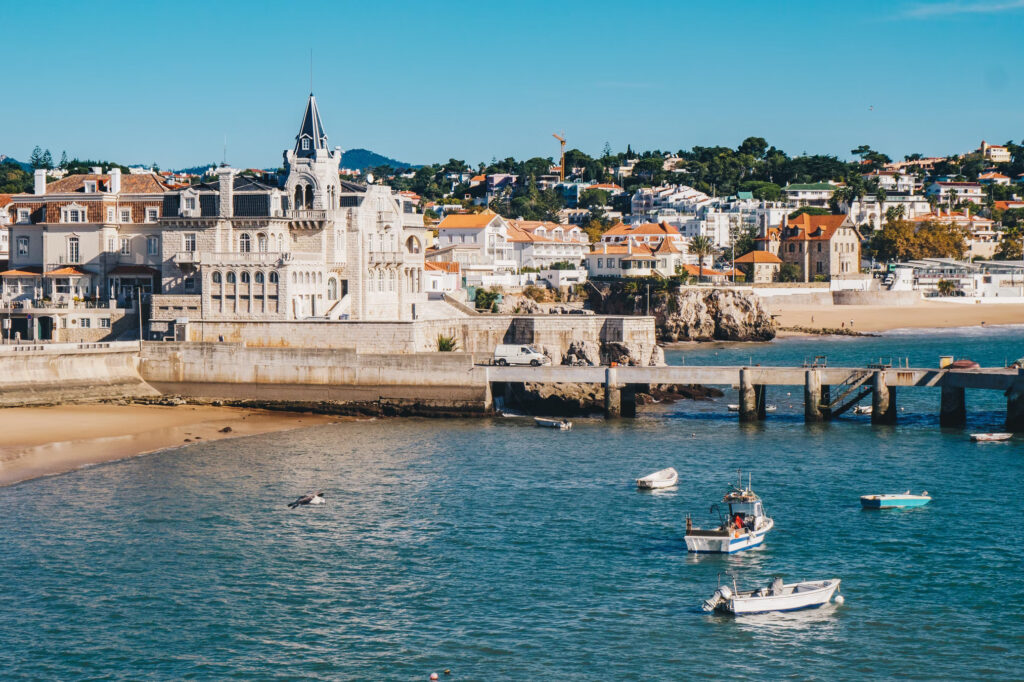
Nemo’s 48 hours in Lisbon: Friday Evening
– Drop off your bags, it’s time to go and hang out with the locals at Miradouro de Santa Catarina . Pick up a takeaway beer or two from the café then settle on the steps and enjoy the view – hopefully with a spectacular sunset too! Soak up your new surroundings with the sound of foreign voices and local buskers playing in this bohemian part of town.
– From there, take a wander as the city starts to stir with an early evening buzz, you never know what you might stumble upon!
– Slowly make your way over to Estrela Da Bica for your fill of authentic flavours, sit outside and enjoy one of the best meals in Lisbon (for a great price too).
– The night is still young, so head down to Praça São Paulo and take a pew in one of the bustling bars and restaurants or, if you’re feeling particularly energetic, bop down to Musicbox to dance the night away…
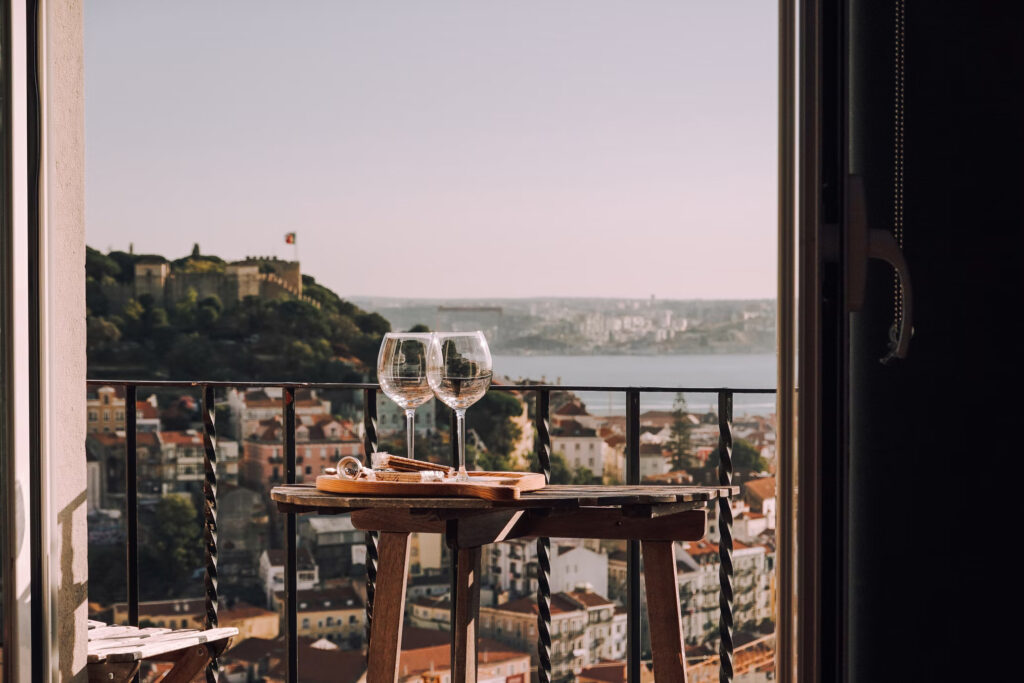
– Saturday morning in Lisbon can only mean one thing… Pastry time. Head to Manteigaria for (arguably) the best pastel de nata in town, get it to take away along with a coffee and stroll around the elegant Chiado and Barrio Alto neighbourhoods to browse the markets and art galleries.
– From here we loved visiting the market at Feira da Ladra , a totally unique street market dating back to the 17th century where you’ll find antiques and curiosities from around the world. Open Tuesday and Saturday, from dawn to the early afternoon.
– From there wander the ancient backstreets of Alfama , the oldest district and a delightful labyrinth of cobbled streets and traditional houses, best explored by getting as lost as possible and stumbling across fantastic local haunts. Pick up lunch at one of the many cafés.
– Take the afternoon at a leisurely pace then as the sun begins to set head for the rooftops, for a trendy urban vibe take the lift to the 6th floor of a parking garage where you’ll find PARK , offering good value cocktails and show stopping views. Java Bar is also nearby and perfect if you’re seeking a classier affair, it’s right next to the Time Out Market too.
– At this point we’re sure you’ll be feeling peckish and we hear Da Noi calling your name, a fantastically busy, tiny restaurant that matches its aesthetic perfection with culinary prowess. Go late! 9 or 10pm.
– Fancy a nightcap? Walk over to Foxtrot bar , a quirky loved-by-locals spot with moreish cocktails.
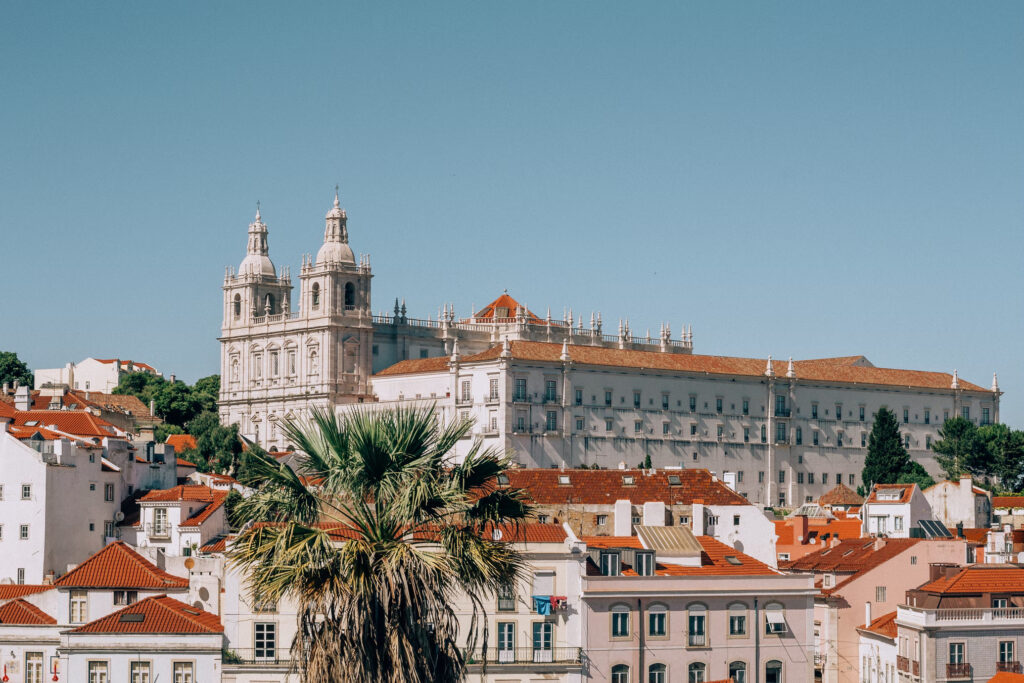
– Lie in and enjoy the dappled morning sun from the comfort of your bed as it reaches across Lisbon’s famous rooftops. Grab a coffee, then it’s time for brunch. Flora and Fauna or Quase Café are great spots depending on where you’re staying in the city.
– Take the opportunity and hop on one of Lisbon’s iconic trams (if you haven’t already). It might be a novelty, but it’s a good one.
– Soak up the last rays before heading on to the next leg of your Portuguese adventure… Comporta , Alentejo and beyond – where’s next for you?
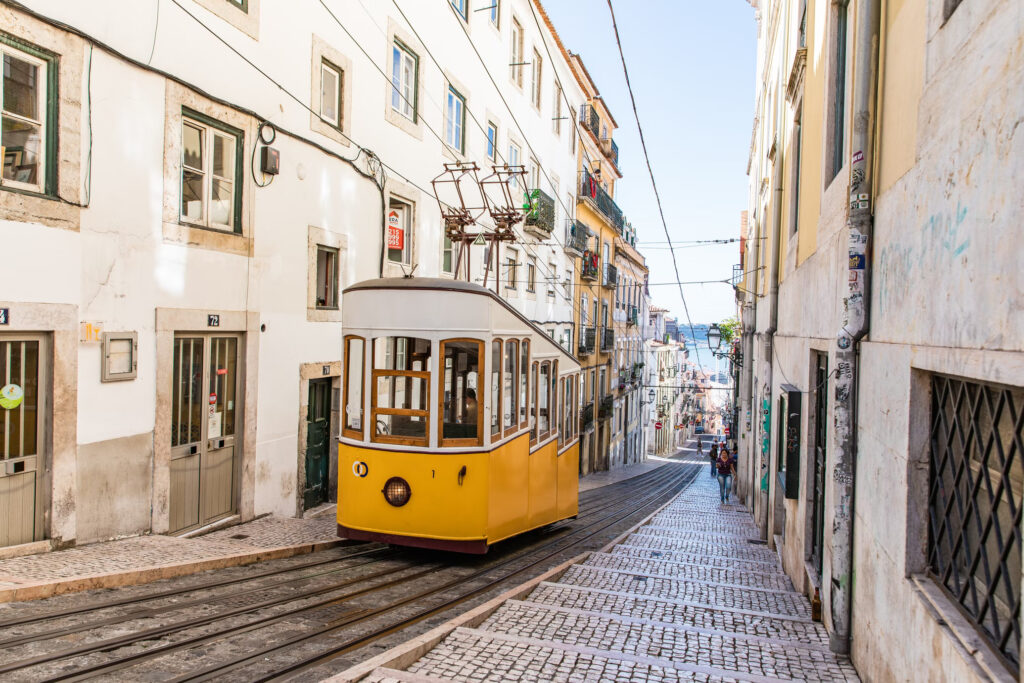
Other restaurants / bars we love in Lisbon
Officina de Duque – a great all rounder
Avillez -Portuguese fine dining
Coyo Taco – ‘Tacoooooos’ (James’ exact word)
Farès Lisboa – A cool Lebanese hangout
Taberna da Rua das Flores – Traditional local taverna
Copa – Quirky speakeasy, knock to enter
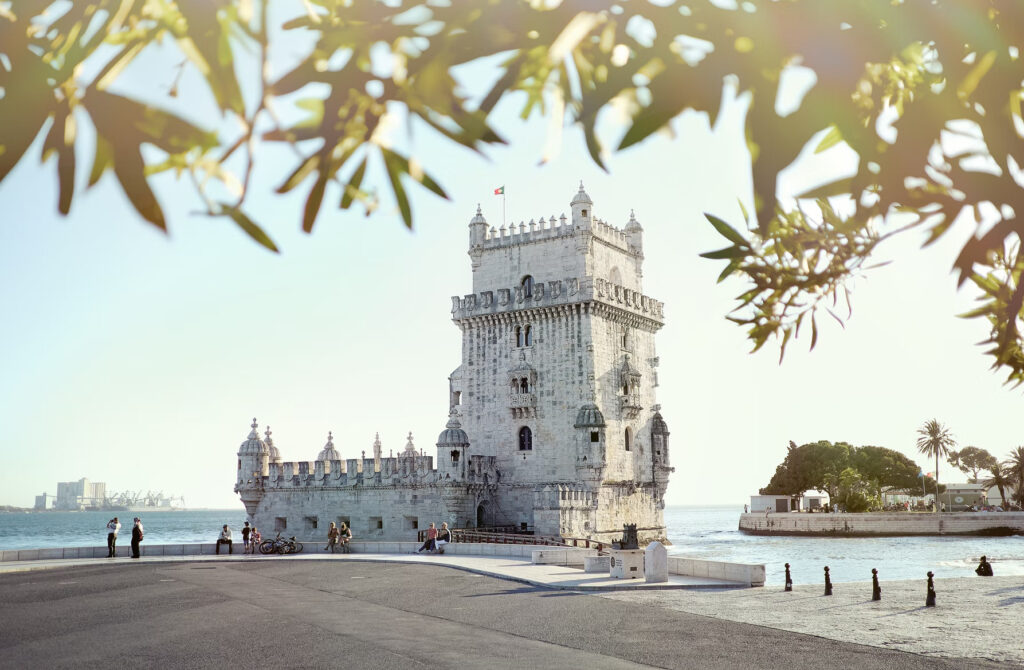
Fancy putting your OOO for a long weekend exploring all Lisbon has to offer? Check out our Portugal itinerary inspiration and hit ‘Design Your Trip’ button on our itinerary pages to start piecing together your dream escape. Need some guidance or fancy chatting it through? We’re only an email or call away.
nemo’s Guide To… Trekking Mount Rinjani
nemo’s go-to guide for hiking the epic Mount Rinjani!
Bolivia FAQs
Bolivia FAQs – From currency to transfers and plug types, we answer all the things you need to know in one handy guide.
The newsletter
Sign up to hear more from the Nemo Travel Nerds and our fascinating partners all over the world
36 Hours in Lisbon
By Seth Sherwood Updated April 20, 2023
- Share full article

You’ll very likely hear many other languages than just Portuguese these days in the hilly, sun-warmed streets of Lisbon, Portugal’s capital, as millions pour in as digital nomads, service-industry workers, home buyers and tourists. For travelers, especially in the summer, this popularity can mean long lines to enter the Castelo de São Jorge or to enjoy a pastry from Pastéis de Belém , which can (almost) diminish the charm of the city’s colorful-tile-wrapped facades, centuries-old churches and melancholy fado music. Lisbon, once a slow-paced maritime city, is in development overdrive, which has not been without discontent: The cost of living has skyrocketed, leading to public debate (and protests ) about the city’s future and to the cancellation of the “golden visa” program , which granted residency to foreigners who invested in high-value properties. Visiting Lisbon thus involves a delicate balance: enjoying one of Europe’s most dynamic cities while being sensitive to the challenges that have accompanied its rapid boom.
Recommendations
- Arkhe is a plant-filled restaurant that specializes in colorful, intricate vegetarian creations.
- Gala Cricri nightclub occupies part of a restored 18th-century palace, the Palácio do Grilo .
- Beato and Marvila , adjacent neighborhoods in an industrial zone, are emerging hotbeds of art and nightlife.
- Pica-Pau dishes out reverent takes on old-time Portuguese recipes.
- Dois Corvos , a microbrewery, pours nearly 20 house beers.
- Tricky’s has clever, contemporary small plates and natural wine in a convivial industrial-ish setting.
- Monkey Mash , a bar that serves adventurous cocktails amid tropical vibes, has a hidden door leading to Red Frog , a speakeasy-style bar with imaginative drinks.
- Casa-Museu Amália Rodrigues is a museum in the home of the late, great fado music singer, for whom it is named.
- Miradouro da Senhora do Monte , an outdoor lookout, offers commanding skyline views.
- Galeria Filomena Soares represents many noted international and Portuguese contemporary artists.
- Galeria Francisco Fino , an art space in the Marvila neighborhood, hosts rotating exhibitions.
- Palácio Nacional da Ajuda , a 19th-century royal palace, contains sumptuous period rooms. Steps away, the new Museu do Tesouro Real displays the crown jewels.
- The No. 12E Tram , which climbs and descends through multiple central Lisbon neighborhoods, offers a cheap and quick sightseeing trip.
- Homecore , a French-owned brand and boutique, supplies cool casualwear.
- Sokyo Lisbon showcases abstract dinnerware and sculptures by Japanese ceramists.
- Distopia stocks vinyl albums, CDs and books, including English-language guides to Lisbon.
- Feira da Ladra , a flea market, bursts with everything from antique cookware to contemporary fashion.
- Feed stocks colorful 1960s- and 1970s-inspired women’s wear in a soaring showroom.
- Little Chelsea Experience , a gallery-bar-boutique, channels the spirit of rock ’n’ roll.
- The Casa Balthazar building, near the central Rossio Square, was acquired in the 19th century by the founder of Confeitaria Nacional — an iconic Lisbon pastry shop — and was converted into a hotel in 2010. The 20 rooms (some with panoramic city views) are outfitted with contemporary bedding and vintage furniture. The hotel also offers a spa, a pool and breakfast provided by, yes, Confeitaira Nacional nearby. Double rooms from 240 euros, or about $265.
- The chic new Hotel Hotel was designed by Pedrita , a studio known for its work on another fashionable Portuguese-owned hotel, the Visionaire Apartments . In addition to its 40 rooms, Hotel Hotel features a swimming pool, a yoga studio and a tattoo parlor. Doubles from €290.
- Cheese & Wine Lapa is a simple, bohemian option in the Lapa neighborhood. Common areas include rooms full of contemporary art and vintage furniture — all of it for sale. Twin rooms with shared bath from around €67. The Cheese & Wine hotel group has other options around town.
- Lisbon has a metro system and a bus network that cover much of the city, along with its much photographed yellow trams. Taxis and ride-hailing apps like Uber and Bolt are also widely available and remarkably affordable compared with other European capitals.

More From 36 Hours
Have a weekend to explore a destination we’ve got the perfect travel itinerary..
Paris: A different side of the French capital reveals smaller museums, under-the-radar spots in Montmartre and a diverse performance scene .
Montreal : Climb a mountain, wander the waterfront and enjoy a smoked-meat sandwich in a city with a surprise around every corner.
Cartagena: With a limonada de coco in hand, explore two walkable neighborhoods over a weekend in this coastal Colombian city.
Glasgow: Take in Gothic architecture, green riverside walks and a global banquet in Scotland’s largest city.
Chicago: Cycle miles of urban trails, tour a restored Frank Lloyd Wright masterwork and catch golden hour along Lake Michigan.
Advertisement
The best ways to travel around in Lisbon

Jul 16, 2023 • 9 min read

See the best of Lisbon with this guide to the local transport network © MesquitaFMS / Getty Images
Despite all the hills and cobbles, Lisbon is an easy city to navigate.
Its impressive and intuitive system of buses, trams and suburban trains, and an efficient metro, make it easy to travel between major points of interest. To conquer the famous seven hills of Lisbon, you can rely on funiculars and elevators – the city's most iconic forms of transportation.
Obviously, you'll want to spend some time exploring the historic Portuguese capital on foot, but it would be bad form to leave Lisbon without taking a ride on Tram 28E, which winds through the historic center, providing a low-cost city tour. Here are the best ways to get around Lisbon.

Walking is the best way to see individual neighborhoods
Lisboetas love their early morning and late afternoon riverside strolls, and plenty of visitors also slip on comfortable walking shoes to explore Lisbon's historic neighborhoods on foot. Navigating the maze of narrow and hilly streets, courtyards and staircases in Alfama, Mouraria and Madragoa can be a challenge in the summer heat, but the experience is at the top of most visitors’ must-do lists . Remember that flat, riverside neighborhoods such as Baixa, Cais do Sodré, Belém and Oriente are more manageable and just as picturesque!
The black-and-white patterns of the city's calçada portuguesa (Portuguese pavements) are one of Lisbon’s calling cards, but be aware this is not the most walking-friendly surface in wet weather. The slick cobblestones can become slippery and are especially treacherous when making steep, downhill strides.
Zap your way around with the Viva Viagem travel pass
The same travel card allows access to the metro and all buses, trains, boats and trams serving Lisbon and neighboring cities, saving money compared to fares paid on-board. The Viva Viagem green card costs €0.50 and is available at vending machines and ticket offices at metro, train and boat stations (there's also a white card, but it's not valid on Metro Transportes do Sul). Top up the card with credit and swipe the card over the sensor to pay on public transport – this is known locally as "zapping."
If you're planning on traveling a lot by public transit in one day, add a 24-hour ticket to your Viva Viagem card. You'll need to buy the right 24-hour ticket combination for all the types of transport you’re planning to use. The simplest combination – known as Carris/Metro – allows you to travel using the same ticket on buses, trams, elevators, funiculars and the metro for €6.60.
CityMapper is the best map and public transport app for travelers to Lisbon, and locals use it frequently. There are also other third-party and government apps, but they aren’t updated as often and don’t work as well.
The metro network is efficient
Lisbon's efficient metro network has four lines, serving the airport (Red Line), Baixa and Chiado (Blue Line), Mouraria and Alvalade (Green Line), and Saldanha and Campo Pequeno (Yellow Line). The Red Line intersects with the other three lines, so it's easy to interchange between lines.
Overall, the metro is easy to navigate, and plans are underway to expand the network to reach neighborhoods such as Belém and Campo de Ourique. However, the metro is not available 24/7; there's a break in services from 1am to 6am. Check your intended itinerary on a map before catching the metro; it’s often quicker to walk between stations, particularly on the Yellow, Blue and Green lines.
On the other hand, the metro is by far the easiest option for reaching points of interest farther from the city center such as Lisbon Zoo (Sete Rios), the Museu Calouste Gulbenkian (São Sebastião) and Parque das Nações (Oriente).

The city is becoming more bike-friendly
Determined to make the city more bicycle-friendly, Lisbon's city planners have put a lot of effort into increasing the number of cycle paths. Drivers, however, are still not used to sharing the road, so this is a transition that is still in progress. If you don't have experience of navigating rogue traffic on two wheels, it’s probably best to stay on riverside paths away from the cars.
To find a bike in the city, download Gira , Lisbon City Council’s official bike-sharing app. It's widely used by locals and tourists, with dozens of bike stations dotted around the center. Prices vary depending on the type of pass that you sign up for, but as a guideline, a visitor using the Daily Pass would get the first 45-minute ride for free, with a charge of €2 for the next 45 minutes. You can also rent e-bikes and scooters through Lime (from Uber) and Bolt.
Buses can get crowded
Lisbon’s bus routes are fairly intuitive, but as buses are one of the forms of public transportation used most frequently by locals, they can get crowded. If you can, avoid catching buses during rush hour, when passengers are bound to be packed in as tightly as the city’s famous sardines.
Buses 728 (Oriente–Belém), 714 (Praça da Figueira–Belém) and 737 (Praça da Figueira–Castelo) are all useful routes for visitors to Lisbon, serving the areas with the most attractions, particularly Belém, Parque das Nações and the historical neighborhoods of Mouraria and Alfama.
Tram 28E offers the perfect tourist route
Everyone knows about Tram 28E, which weaves an atmospheric path through the historic neighborhoods of Mouraria, Alfama and Graça, but you can hop on any of the other old trams for a similarly rewarding experience. Recommended routes include the 12E (Martim Moniz), 18E (Cais do Sodré–Ajuda), 24E (Praça Luís de Camões–Campolide) and 25E (Praça da Figueira–Campo de Ourique). Bigger modern trams run on route 15E, connecting Praça da Figueira to Belém; this route is often used by tourists on their way to Mosteiro dos Jerónimos and Torre de Belém.
One thing to note: while the rickety, mustard-yellow trams are full of character, they're more of a travel experience than a practical way to get around in Lisbon. In addition to not being the most comfortable form of public transportation, they don't cover large areas of the city, and they often get stuck behind poorly parked cars during rush hour.
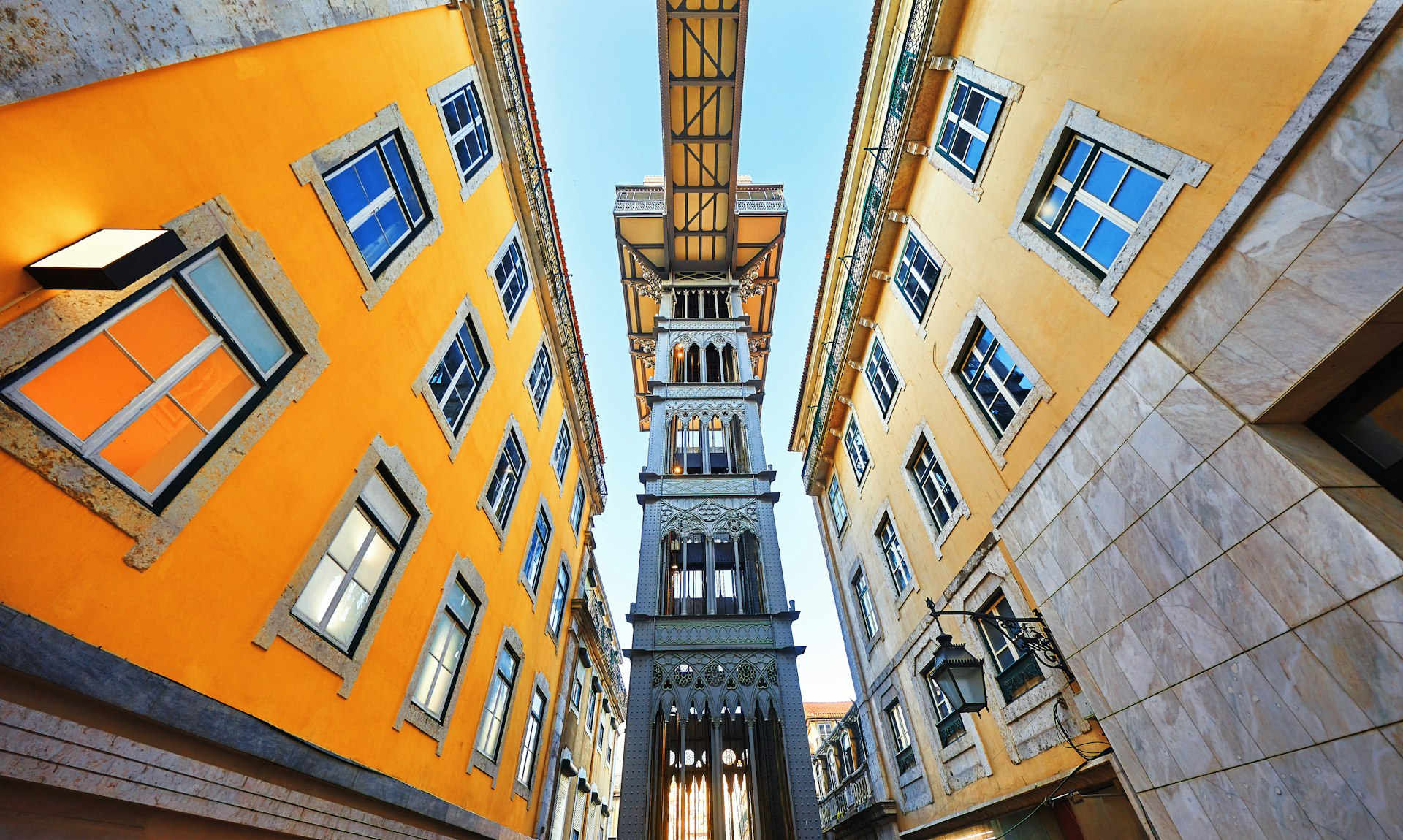
Funiculars and elevators help with the hills
Three funiculars ( ascensores ) and one historic elevator have been helping city-dwellers dodge the uphill climbs in Lisbon since the early 1900s. All four are numbered, but locals refer to them by the names of the streets they ride on. Glória (51E) connects Restauradores to Bairro Alto, Lavra (52E) links Baixa and Jardim do Torel, Bica (53E) connects Cais do Sodré to Bairro Alto, and the Santa Justa elevator (54E) connects Baixa to Largo do Carmo in Chiado.
Tickets bought on board are pricey, costing €3.80 for two rides on the funiculars and €5.30 to go there and back on the elevator. Instead, purchase a Viva Viagem transport card and spend only €1.35 per trip.
Trains are quicker for getting to Belém
Suburban trains on the Cascais Line depart from Cais do Sodré every 20 to 30 minutes; it’s often quicker to hop on one of these trains to get to Belém than it is to catch the tram, a bus or a taxi. The journey takes less than 10 minutes. To reach the eastern side of the city faster than by taking the metro or bus, catch the Azambuja Line train from Santa Apolónia to Oriente Station – a stress-free trip of eight minutes.
Five boat services cross the Tagus
Five boat routes connect the two sides of the Tagus River, and taking a boat is the fastest, cheapest and easiest way to get to the south bank. Boats to Barreiro depart from Terreiro do Paço, and from the Cais do Sodré boat station, you can catch boats to Montijo, Seixal and Cacilhas. From Belém, you can reach Trafaria and Porto Brandão by boat.
Lisbon's taxis are black with a green roof
Grabbing a cab is a good-value option for longer journeys, and for getting to and from the airport. That said, language can sometimes be a barrier, and service standards can be disappointing. Taxis in Lisbon are easy to identify: they're black vehicles with a green roof. They all run on meters, and these are immediately turned on once you get in. Taxi drivers are required to issue a receipt at the end of the ride, whether you ask for one or not. Some taxis take card payments, but not all, so it’s best to carry cash.
Rideshare services are cheaper than regular taxis
Ridesharing apps are used widely in Lisbon; Uber, Bolt and FREE NOW are all popular options. Using these app-based services is cheaper than taking a conventional cab and quicker than getting on a bus to reach the far eastern (Oriente) and western (Belém) sides of the city. However, note that drivers are not always that familiar with the layout of the city. By law, all ride-share vehicles are required to display a sticker on the windshield with the letters TVDE.

Cars are best saved for those with reduced mobility
Only drive in Lisbon if you need to cover a lot of ground in a short time, or if you or those you are traveling with have reduced mobility. As in any densely packed city, there are traffic jams and road works to contend with, but the Portuguese penchant for double parking with blinkers on is even more of a patience test. The shortage of parking is also an issue, particularly on weekdays, when commuters take over every available spot in busy neighborhoods such as Baixa, Chiado and Mouraria.
Accessible transportation in Lisbon
Lisbon is not a very accessible city, and unfortunately, most challenges won’t be easily overcome in the near future. The historic calçada portuguesa sidewalks are uneven and poorly maintained, and trams squeeze their way along narrow streets, further reducing space for the mobility impaired. Travelers with disabilities may find it difficult to ride the narrow and rampless funiculars. Lisbon’s trams are also tricky for people with reduced mobility (tram 15E is the only service with accessible boarding). Most buses aren’t equipped to accommodate wheelchair users, and only some metro stations are equipped with elevators. Find more information in Lonely Planet's free Accessible Travel guide .
This article was first published October 2021 and updated July 2023
Explore related stories

Tips & Advice
Apr 4, 2024 • 4 min read
Northern Portuguese classics and food that's hard to find in Lisbon.

Apr 3, 2024 • 15 min read

Mar 25, 2024 • 6 min read

Mar 15, 2024 • 5 min read

Mar 11, 2024 • 7 min read

Mar 3, 2024 • 6 min read

Feb 28, 2024 • 9 min read

Feb 27, 2024 • 3 min read

Feb 25, 2024 • 7 min read

Jan 17, 2024 • 8 min read
AAA Newsroom
Automotive, Travel, and Traffic Safety Information
With May Approaching, Pump Prices Stick to the Slow Lane
By: andrew gross.

WASHINGTON, D.C. (April 25, 2024)—With domestic gasoline demand decidedly in the doldrums and the cost of oil retreating, the national average dipped two cents since last week to $3.65.
“Domestic gas demand is pretty pokey at the moment, which is often the case in the runup to Memorial Day and the traditional start of summer driving season,” said Andrew Gross, AAA spokesperson. “The recent national average price of $3.67 could be the peak until hurricane season is well underway. But as always, the wildcard will be the cost of oil, so stay tuned.”
For the complete report, including the latest EIA data and oil market dynamics, please visit: https://gasprices.aaa.com/with-may-approaching-pump-prices-stick-to-the-slow-lane/

IMAGES
VIDEO
COMMENTS
Yes, Lisbon is worth visiting. It is a trendy young city and a top choice for Digital Nomads, but you don't need a lot of time to see it. There are other places in Portugal that are worth spending more time in. If you are slow travelling through Portugal I would still allocate a short time for Lisbon.
Things not to miss in Praca do Comercio are: Lisboa Story Centre: Interactive museum of the history of Lisbon and the earthquake of 1755. Martinho da Arcada: The oldest cafe in Lisbon where famous poet Fernando Pessoa frequented. Ribeira das Naus: Waterfront promenade along the Tagus River.
We took numerous day trips while staying in the Lisbon area, and here are a few I recommend: Cascais. This gorgeous resort town is about 30 minutes outside of Lisbon. It has quaint beaches, stunning scenery, and myriad shops and restaurants. The train from downtown Lisbon (€2.25) runs along the coastline with breathtaking views the entire way ...
Note that during peak season in Lisbon, there is usually a very long line to take the lift, so the best time to go is early morning. Opening hours are every day from 7 AM to 10:45 PM. On Carmo Square, you can visit the Carmo Convent which was completely destroyed in the 1755 earthquake, leaving only its empty shell.
Top 5 Things to See and Do in Lisbon. 1. Walk around the Old Town. Alfama, the historic area of Lisbon, is filled with narrow, winding streets lined with shops, cafes, and restaurants. The name, meaning "hot springs," comes from the Moors who conquered here in the 8th century.
View of Lisbon from the Tagus River Day 1 - Lisbon: exploring Baixa, Chiado and Alfama neighbourhoods. Built on 7 hills by the Tagus River, wherever you are in Lisbon, it'll always feel like there's a view.That's because your eyes will marvel at sights like the city's matching orange tile rooftops, sweeping grand cathedrals or the colourful tiled art buildings - a true visual feast of ...
Slow Travel in the time of a pandemic: our month in Lisbon. Posted on January 19, 2022 January 24, ... Lisbon is on the same latitude as San Francisco, same-same but different with its hills, trams, bay, red bridge, fabulous coffee and restaurants for a fraction of the cost. Wear comfy shoes since in the Lisbon hills you will be climbing 100 ...
The top attractions in Lisbon, including the Jerónimos Monastery and Castelo de São Jorge, get extremely crowded, and it will make your life much easier to purchase tickets in advance! This Lisbon travel tip goes for nearby Sintra, too, especially at the iconic Pena Palace and the dreamy Quinta da Regaleira.
Even as a solo traveler in Lisbon, there is no way to effectively navigate and avoid the crowds. To make the prospect of visiting Belem Tower even more bleak, it's out of the way for tourists. Walking to the tower is a dull hour-and-a-half trek, and even public transportation takes a solid 30 minutes.
hello hello sweet friends!! aaaaaah the lisbon slow travel / remote work chapter begins!! in this lil vlog, I moved into my sublet, started unpacking, walked...
Tickets cost €1.40. Taxis are an inexpensive way to cross the city and reach the outlying neighborhoods. Call 21 812 9275 or 21 811 1100 to book. Tram: tram #28 runs through old town and is a great way to view the city. A ride is 1.05 EUR. There are several funiculars that operate within Lisbon.
21.Fado. The soulful melodies of fado are Lisbon's version of the blues. Songs full of meloncholy and heartache sung with the masterful strums of a 12-string guitar are the soundtrack to Lisbon. Head to a tasca for authenic fado, Povo Lisboa in Cais do Sodre and Tasca do Chico in Barrio Alto are local favorites.
Lisbon welcomes visitors with pleasant weather all year long, but spring is the season when it hits the sweet spot. Trees are blooming, days are getting longer and occasional rainfall keeps the parks green, making Lisbon just that bit more romantic. ... Tourist crowds slow to a trickle as the end of daylight saving time approaches and days get ...
Slow travel is a term that has been used to refer to a more sustainable way of travelling and is an alternative to mainstream mass tourism. A big focus of slow travel is also the immersion into the local culture. Slow travel, sometimes also called immersive travel, is what TheSlowTravelista is all about.
Slow Travel in Lisbon, Portugal. Some Facts About Portugal The Great Lisbon Earthquake. Lisbon is one of the oldest cities in the world and used to be a central location for trade and commerce. However, in 1755, the city suffered from a big earthquake followed by fires and a Tsunami that destroyed the city almost completely. Besides the ...
Lisbon - Top Tips. With its eternal golden hues, mosaic-adorned streets with clattering trams and a mouth watering foodie scene, Lisbon is one of our favourite cities to visit. Our co-founder James recently returned from a two-week Portuguese adventure (with a hefty pasteis de nata tally in tow), so what better time than now to bring you our top tips for a 48 hour stint in one of Europe's ...
Five courses, without drinks, €70 per person. 12 a.m. Party in a palace. The nightclub Gala Cricri is inside the Palácio do Grilo, a formerly disused 18th-century manor in the emerging Beato ...
The simplest combination - known as Carris/Metro - allows you to travel using the same ticket on buses, trams, elevators, funiculars and the metro for €6.60. CityMapper is the best map and public transport app for travelers to Lisbon, and locals use it frequently.
3. Pastel de Nata Cooking Class. The Portuguese most certainly love their pastries and desserts. But, the one on everyone's lips is the delectable egg-yolk custard tartlets known as the Pastel de Nata (or Pasteis de Nata in plural), one of the most popular street foods in Europe.. If you want to eat and experience Lisbon like a local, taking a food tour or cooking class is a great place to ...
Ricardo Balocas, a Lisbon native who moved to Macao in 2013, has held a variety of jobs since relocating from Europe, including management roles at the Macao International Airport and at St ...
With May Approaching, Pump Prices Stick to the Slow Lane By: Andrew Gross. Andrew Gross Manager, AAA Public Relations. [email protected]. 4/25/2024. ... travel, insurance and financial services through its federation of 27 motor clubs and more than 1,000 branch offices across North America. Since 1902, the not-for-profit, fully tax-paying ...
Public invited to community meetings and online open house. SEATTLE - Washington State Ferries needs to replace the aging Fauntleroy ferry terminal to maintain safe and reliable ferry service for the 3 million people who travel the "Triangle" route between West Seattle, Vashon Island and the Kitsap Peninsula each year.